Top 28 Companies in Pharmaceutical Clinical Trials

The pharmaceutical clinical trials industry plays an indispensable role across the global healthcare spectrum. Made of numerous companies, their primary responsibility involves conducting research, managing clinical trials, and ensuring the safety and efficacy of medical treatments. These corporations frequently collaborate with pharmaceutical and medical device manufacturers, healthcare organizations, and research institutes. As innovation intensifies and international healthcare challenges elevate, the pharmaceutical clinical trials industry is set to register unprecedented expansion, while contributing towards the introduction of advanced medical treatments and therapies.

Top 28 Pharmaceutical Clinical Trials Companies
- Website: parexel.com
- Headquarters: Newton, Massachusetts, United States
- Founded: 1982
- Headcount: 10001+
- Latest funding type: Acquired
Parexel is a global company that offers services and solutions in the clinical research and healthcare industry. They provide expertise in various areas such as clinical trial management, regulatory outsourcing, medical monitoring, and consulting. They work with pharmaceutical companies, medical device manufacturers, and other healthcare organizations to support the development and advancement of new medicines and therapies.
2. Worldwide Clinical Trials
- Website: worldwide.com
- Headquarters: Research Triangle Park, North Carolina, United States
- Founded: 1986
- Headcount: 1001-5000
Worldwide.com is a global company specializing in clinical trial services and real-world evidence. With over 35 years of experience, they offer a range of services including clinical monitoring, data management, drug safety, patient recruitment, and project management. They focus on therapeutic areas such as cardiovascular, metabolic, neuroscience, oncology, and rare diseases. Their innovative lab services and personalized approach make them a trusted partner in the pharmaceutical industry.
- Website: medpace.com
- Headquarters: Cincinnati, Ohio, United States
- Founded: 1992
- Latest funding type: Ipo
Medpace is a full-service Contract Research Organization (CRO) that accelerates the advancement of safe and effective medical therapeutics. With a global reach, Medpace offers a wide range of services including clinical trial management, patient recruitment, and drug safety monitoring.
4. Premier Research
- Website: premier-research.com
- Headquarters: Morrisville, North Carolina, United States
- Founded: 1989
- Latest funding type: Series Unknown
Premier Research is a clinical research organization that helps innovative biotech and specialty pharma companies transform ideas and breakthrough science into new medical treatments. They offer a range of services, including product development consulting, global regulatory consulting, nonclinical studies, quality assurance, and project management.
5. Novotech
- Website: novotech-cro.com
- Headquarters: Sydney, Nsw, Australia
- Founded: 1996
- Latest funding type: Debt Financing
Novotech is a leading Asia Pacific biotech specialist CRO that offers cost competitive solutions for clinical research. They provide a full range of services including medical and regulatory consulting, patient recruitment, site selection, and clinical operations. With expertise in infectious diseases, vaccines, and biometrics, Novotech offers high-quality research and data management. They have a large homogenous population and locations in various countries.
6. Clinipace
- Website: clinipace.com
- Founded: 2003
- Headcount: 501-1000
Clinipace is a global CRO that specializes in clinical research and development. They provide personalized solutions to biotech and pharmaceutical companies, offering expertise in clinical technology, analytics, regulatory and strategic product development. With a focus on collaboration and control, Clinipace guides their clients through the entire clinical development program.
7. Crown Bioscience
- Website: crownbio.com
- Headquarters: San Diego, California, United States
- Founded: 2006
Crown Bioscience is a Contract Research Organization (CRO) that empowers customers to improve human health. They engage scientific talent, uphold quality standards, and pursue innovation to accelerate and de-risk drug development. Their services include biomarker discovery, efficacy testing, DMPK, and pharmacology.
8. Veeda Clinical Research Limited
- Website: veedacr.com
- Headquarters: Ahmedabad, Gujarat, India
- Founded: 2004
- Latest funding type: Private Equity
Veeda Clinical Research is a company that provides quality research solutions for sponsors and regulatory authorities. They conduct early phase clinical trials in healthy volunteers and patients, specializing in ophthalmology trials. Additionally, they offer bioequivalence and bioavailability studies, drug discovery and development services, clinical endpoint phase III studies, and safety monitoring services.
9. Quanticate
- Website: quanticate.com
- Headquarters: Hitchin, Hertfordshire, United Kingdom
- Founded: 1994
- Headcount: 201-500
Quanticate is a global biometric Clinical Research Organization (CRO) offering statistical and data expertise. They help pharmaceutical and biotech companies bring their drugs to market by providing fast and reliable access to expert biometric teams. Their services include biostatistics, statistical programming, clinical data management, and biostatistical consultancy.
10. Nucleus Network
- Website: nucleusnetwork.com.au
- Headquarters: Melbourne, Victoria, Australia
Nucleus Network is a company that offers clinical research services focusing on early phase and vaccine trials. They provide state-of-the-art facilities, experienced staff, and innovative approaches to help pharmaceutical and biotech companies accelerate their drug development processes.
11. Richmond Pharmacology
- Website: richmondpharmacology.com
- Headquarters: London, London, United Kingdom
- Founded: 2001
- Headcount: 51-200
Richmond Pharmacology is a Clinical Research Organisation that conducts early phase clinical trials in a wide range of medical conditions with patients and healthy volunteers. They work with international pharmaceutical and biotech organizations to drive innovation in the field of clinical research.
12. Integrium, LLC
- Website: integrium.com
- Headquarters: Tustin, California, United States
- Founded: 1998
Integrium is a full-service Clinical Proof of Concept (PoC) firm specializing in various therapeutic areas, including cardiovascular, metabolic disease, and dermatology research. We assist pharmaceutical companies in designing and executing clinical trials to achieve their objectives on time and with expected quality. With cutting-edge technology and unparalleled services, we play a crucial role in advancing new medical advancements. Our team of experts works collaboratively with clients, investigators, and vendors to ensure the successful implementation of clinical trials.
13. Mithra Biotechnology Inc.
- Website: mithracro.com
- Headquarters: 新北市 New Taipei City, Taiwan, Taiwan
- Founded: 1988
MithraCro is a biotechnology company specializing in pharmaceutical analysis services, with expertise in bioequivalence testing, clinical trial services, drug metabolism research, and protein analysis.
14. Pearl Therapeutics
- Website: devprobiopharma.com
- Headquarters: Morristown, New Jersey, United States
- Founded: 2020
- Headcount: 11-50
DevPro Biopharma is a clinical research and development accelerator that specializes in transforming molecules into medicines. They offer comprehensive services to assist in the development of pharmaceutical products.
15. Almac Group
- Website: almacgroup.com
- Headquarters: Craigavon, County Armagh, United Kingdom
- Founded: 1968
- Headcount: 5001-10000
- Latest funding type: Grant
Almac Group provides a range of services in the pharmaceutical industry, including storage and distribution, product launch and distribution, API development and manufacture, clinical trial assays, genomic services, clinical testing, and clinical supply chain management. They offer flexible solutions to meet the needs of their clients and ensure the successful launch and distribution of pharmaceutical products. Almac Group is committed to exceptional quality and customer satisfaction.
16. 4B Technologies, Ltd
- Website: 4btechnologies.com
- Headquarters: 苏州市, Jiangsu, China
- Founded: 2017
- Latest funding type: Series B
4B Technologies is a biopharmaceutical company with a leadership team composed of elite professionals from various fields. They are dedicated to developing innovative and effective treatments for neurological diseases.
17. TechnoDerma Medicines
- Website: tkskin.com
- Headquarters: Xuzhou, Jiangsu, China
- Founded: 2014
- Latest funding type: Series A
Techonderma Medicines, Inc. is a private clinical-stage biopharmaceutical company focused on developing innovative therapies for various skin conditions.
- Website: caidya.com
Caidya is a clinical research organization (CRO) that offers personalized services and expertise in various therapeutic areas. They specialize in conducting regional or multinational studies using efficient operational models, local market knowledge, and advanced technologies. Caidya is committed to transparency, clinical development expertise, and personalized experiences for their clients.
19. Novum Pharmaceutical Research Services
- Website: novumprs.com
- Headquarters: Pittsburgh, Pennsylvania, United States
- Founded: 1972
Novum is a global clinical research organization (CRO) with a focus on delivering high-quality research outcomes and exceptional customer satisfaction. With nearly fifty years of experience, Novum offers a comprehensive suite of services in early clinical development, bioanalytical testing, and phase II-IV clinical trial management. The company's dedicated and skilled team, extensive training programs, and global resources enable efficient project optimization and streamline timelines and budgets.
20. PharPoint Research, Inc.
- Website: pharpoint.com
- Headquarters: Durham, North Carolina, United States
- Founded: 2007
PharPoint Research provides drug development solutions to clients of all sizes. Contact us to speak with a representative about how PharPoint can help with your current or upcoming study needs.
21. NC Coast Clinical Research Initiative
- Website: nccoastclinicalresearch.com
- Headquarters: United States
- Founded: 2012
NC Coast Clinical Research is a consortium of 60+ CROs and 100+ clinical research support companies, providing comprehensive integrated drug development, laboratory and lifecycle management services.
22. Quinta-analytica
- Website: quinta.cz
- Headquarters: Praha 10, Hlavni Mesto Praha, Czechia
- Founded: 1997
Quinta is an innovative and trusted world leader in pharmaceutical analysis, R&D, and clinical testing in both human and veterinary medicinal products.
23. LINK Medical Research
- Website: linkmedical.eu
- Headquarters: Oslo, Oslo, Norway
- Founded: 1995
LINK Medical Research is a leading contract research organization (CRO) in Northern Europe. They offer a strategic partnership and provide highly competent teams and evidence-based documentation for superior clinical outcomes. From early phase development to post-marketing, they offer expert guidance through every stage of product development. With a well-integrated local presence in the Nordics, UK, and Germany, they make the journey to market simple and cost-effective.
24. Medlab Clinical Ltd
- Website: medlab.co
- Headquarters: Botany, New South Wales, Australia
Medlab.co is a company that specializes in drug delivery technology. They have a proprietary NanoCelle® platform with 57 patents worldwide. They offer partnering opportunities, clinical trials, and a range of products. Medlab.co is committed to transforming medicine and improving patient outcomes.
25. Clexio Biosciences
- Website: clexio.com
- Headquarters: Petach Tikva, Israel, Israel
- Founded: 2018
Clexio Biosciences is a multi-asset company dedicated to developing novel therapies for patients suffering from neurological and psychiatric conditions.
26. Suzhou Abogen Biosciences
- Website: abogenbio.com
- Headquarters: 苏州市, 江苏省, China
- Founded: 2019
- Latest funding type: Series C
Abogenbio is a biotechnology company focused on innovative drug development and research. With a team culture of openness and collaboration, we strive to bring hope and healing to patients through the creation of groundbreaking medicines. We are dedicated to fostering a fearless and accountable environment where partners can thrive and pave the way for a brighter future.
27. Abond CRO Inc.
- Website: abondcro.com
- Headquarters: Allendale, Michigan, United States
- Founded: 1974
ABOND is a full-service CRO that offers consulting, clinical operations, data management, and statistical analysis. Our commitment to honesty, focus, and responsibility sets us apart. We provide reliable outcomes and are always answerable for our work.
28. Novatek Pharmaceuticals
- Website: novatekpharmaceuticals.com
Novatek Pharmaceuticals Inc. is a startup based in Houston, TX that provides scientific guidance and conducts clinical research for immunomodulatory drugs related to cancers and infectious diseases. They are currently raising Series A for clinical trials and pipeline development.
Want to find more pharmaceutical clinical trials companies?
If you want to find more companies that offer comprehensive clinical trial services and research solutions you can do so with Inven . This list was built with Inven and there are hundreds of companies like these globally.
With Inven you'll also get to know the company's:
- Ownership: Which of these are private equity backed? Which are family-owned?
- Contact data: Who are the owners and CEO's? What are their emails and phone numbers?
- Financials: How do these companies perform financially? What are their revenues and profit margins?
...and a lot more!
Find companies 10x faster with Inven

Keep on reading
More articles.

Find the right market research agencies, suppliers, platforms, and facilities by exploring the services and solutions that best match your needs
list of top MR Specialties
Browse all specialties
Browse Companies and Platforms
by Specialty
by Location
Browse Focus Group Facilities

Manage your listing
Follow a step-by-step guide with online chat support to create or manage your listing.
About Greenbook Directory
IIEX Conferences
Discover the future of insights at the Insight Innovation Exchange (IIEX) event closest to you
IIEX Virtual Events
Explore important trends, best practices, and innovative use cases without leaving your desk
Insights Tech Showcase
See the latest research tech in action during curated interactive demos from top vendors
Stay updated on what’s new in insights and learn about solutions to the challenges you face
Greenbook Future list
An esteemed awards program that supports and encourages the voices of emerging leaders in the insight community.
Insight Innovation Competition
Submit your innovation that could impact the insights and market research industry for the better.
Find your next position in the world's largest database of market research and data analytics jobs.

For Suppliers
Directory: Renew your listing
Directory: Create a listing
Event sponsorship
Get Recommended Program
Digital Ads
Content marketing
Ads in Reports
Podcasts sponsorship
Run your Webinar
Host a Tech Showcase
Future List Partnership
All services

Dana Stanley
Greenbook’s Chief Revenue Officer
Top Pharmaceutical Market Research Firms for Prescription Medicines
What are pharmaceutical market research companies.
Pharmaceutical market research companies provide services to help pharma, healthcare, and related industries gain insights into how to best market in today's complex healthcare landscape. They inform on marketing for prescription and over-the-counter (OTC) drugs, vaccines, and other pharma products as well as some medical devices.
The top pharmaceutical market research companies offer market research services related to prescription medicines and certain types of healthcare marketing. These vendors conduct research projects for prescription drug development and marketing needs, and their services go hand-in-hand with overarching pharmaceutical research, healthcare research, and other niche aspects of pharma research.
Learn more about pharma market research.
Featured Experts in Top Pharmaceutical Market Research Firms for Prescription Medicines
Learning Resources
in Experts in Market Research on Prescription Medicines
Service or Speciality
Advanced Analytics
Advertising Agencies
Advertising Effectiveness
Advertising Research - General
Africa / Middle East
African-American
Agile Research
Agriculture / Agribusiness
Alcoholic Beverages
Apparel / Clothing / Textiles
Artificial Intelligence / AI-Powered Platforms
Association Membership
Attitude & Usage Research
Automated Market Research Platforms
B2B Research - General
Banking - Commercial
Banking - Retail
Biotechnology
Brainstorming / Facilitation
Brand / product / service launch
Brand / product / service repositioning
Brand Equity
Brand Image Tracking
Brand Loyalty / Satisfaction
Brand Positioning
Bulletin Boards
Business Insights
Business Intelligence Software
Business-to-Business
CATI - Computer-Aided Telephone Interviewing
CX - Customer Experience
CX Benchmark Studies
Candy / Confectionery
Cannabis / CBD
Car Clinics
Casinos / Gambling
Central America
Central Location
Chemical Industry
College Students
Communications
Communications Strategy Research
Computer Hardware
Computer Software
Concept Development
Concept Optimization
Concept Testing
Conjoint Analysis / Trade-off/Choice Modeling
Construction Industry
Consultation
Consumer Durables
Consumer Research - General
Consumer Services
Consumer Trends
Convention / Tradeshow
Copy Testing - Traditional Media
Corporate Image/Identity Research
Cosmetics / Beauty Aids
Credit Cards
Cross-Tabulation Systems
Customer Loyalty / Value
Customer Satisfaction
Data Analysis
Data Integration
Data Mining
Data Processing
Data Visualization & Dashboards
Demographic Analysis
Doctors / Physicians
Eastern Europe & Russia
Electronics
Employee Experience & Satisfaction
Entertainment Industry
Environment & Sustainability
Ethnic Groups
Ethnography / Observational Research
Executives / Professionals
Exercise & Fitness
Field Services
Financial Industry
Financial Services Professionals
Focus Group Facility
Focus Group Facility - Non-Traditional
Focus Group Recruiting
Focus Groups
Focus Groups - International
Focus Groups - Pop-Up
Foods / Nutrition
Forecasting & Predictive Analytics
Foreign Language
Fragrance Industry
Full Service
Gaming / Gamers
General - Healthcare
Generation X
Generation Y / Millennials
Generation Z
Global Capabilities
Global, multinational branding
HMOs / Managed Care
High Net Worth
High Technology
Hispanic / Latino
Home Use Tests
Hospital Personnel
Hospital Purchasing Agents
Hospitals / Nursing Homes
Household Products/Services
Hybrid / Mixed Methodology
Idea Generation
Implicit Association
In-Depth (IDI) / One-on-One
In-Depth / One-on-One
Industrial & Manufacturing
International / Multi-country
International Consumer Market Research
Internet of Things (IoT)
Investment Banking
Journey Mapping
Knowledge Management Systems
Lawn & Garden
Legal / Lawyers
Low Incidence
Mall Intercept
Market & Competitive Intelligence
Market Opportunity Evaluation
Market Segmentation
Market Simulation
Media Industry
Media Market Research
Medical / Health Care
Medical / Healthcare Professionals
Mobile Surveys
Mock Juries
Moderator Services
Movies / Streaming / TV
Multi-Country Studies
Multicultural
Music Tests
Mystery Shopping
NPS Measurement
New Products
Nurses / Nurse Practitioners
Online - Qualitative
Online - Quantitative
Online Communities - MROC
Online Diaries / Journals / Blogs
Online Panels
Packaged Goods
Packaging Development
Packaging Testing
Payments & Incentives
Personal Care Items
Pet Owners / Foods / Supplies
Pharmaceutical - OTC Medicines
Pharmaceutical - Prescription Medicines
Pharmacists
Post-Launch Tracking
Prediction Markets
Preventive Healthcare
Price / Pricing
Price Elasticity
Problem Detection / Dissatisfaction
Product Development
Product Market Research
Product Optimization
Product Testing
Professionals / Executives
Proprietary Panels
Psychographic Research
Psychological / Motivational Research
Purchase Behavior
Qualitative
Qualitative Research
Qualitative Services - General
Quantitative Research
Quick Service Restuarants (QSR)
Recruiting Research
Restaurants / Food Service
Retail Industry
Sample & Recruiting
Secondary Research / Desk Research
Segmentation
Semiotics Research and Analysis
Seniors / Mature
Sensory Research
Sentiment Analysis
Service Quality Needs & Measurement
Shopper Insights
Smart Products
Social Listening & Analytics
South America
Southeast Asia & India
Statistical Analysis
Store Audits
Strategic Research
Surgical Products / Medical Devices
Survey Programming
Survey Recruiting
Syndicated / Published Reports
Taste Test Facility
Teenagers / Youth
Telecommunications
Text Chat / SMS / IM Sessions
Tracking Research
Trademark / Trademark Infringement
Translation Services
Upper Income / Affluent
Usability Lab
User Testing
Utilities / Energy
Veterinarians
Video Conferencing
Video Management Platforms
Video Recording
Website Analysis / Web Analytics
Website Usability / UX
Western Europe
Atlanta (GA)
Boston (MA--NH)
Charlotte (NC--SC)
Chicago (IL--IN--WI)
Cincinnati (OH--KY--IN)
Cleveland (OH)
Connecticut
Massachusetts
Miami-Fort Lauderdale (FL)
New Hampshire
New York (NY--NJ--CT)
Orlando (FL)
Pennsylvania
Philadelphia (PA--NJ--DE--MD)
San Antonio (TX)
South Carolina
St. Louis (MO--IL)
Toronto (ON)
Vendor type
Data & Analytics
Data Collection
International
Panels / Communities
Qualitative Consultant
Software & Technology
Support Services
Business Designation
HIPAA Compliant
Minority-Owned Business
Women-Owned Business
Clear filters ( 0 )
Related Specialties
Interviews with Healthcare Professionals
Moderating with Medical & Healthcare Professionals
Healthcare & Medical [market sector expertise]
OTC Medicines [market sector expertise]
Preventive Healthcare [market sector expertise]
Compare Experts in Market Research on Prescription Medicines

Miami, Florida
SOCIAL MEDIA
Save to my lists
Featured expert
Recommended by Clients
Based on 3 ratings
CASA Demographics
Largest Nationwide Qualitative Panel of Hispanic and Asian-American Segments / Multilingual Recruitment, Moderation & Analysis / Decades of Expertise
Why choose CASA Demographics
Decades of Qual Expertise
Diverse 546,000+ US Panel
Truly Nationwide Reach
MBA & PhD-led Researchers
Multilingual Moderation
Learn more about CASA Demographics

New York, New York
We’re the only B2B research company that solves the challenges of today’s insights leaders by connecting them with verified business expertise.
Why choose NewtonX
100% ID-Verified
1.1 billion reach
140 industries globally
Niche audiences
Custom recruiting
Learn more about NewtonX

Perryville, Missouri
Pinnacle Research Group, LLC
Pinnacle Research Group is a think-tank of highly educated, forward-thinking professionals who combine psychological theory with real world insight.
Why choose Pinnacle Research Group, LLC
Passionately Curious
Expertise Exploring Why
Fresh Perspective
Dedication to Excellence
Seasoned Researchers
Learn more about Pinnacle Research Group, LLC
SIS International Research
SIS International Research, founded in 1984, is a leading full-service Market Research and Market Intelligence firm.
Why choose SIS International Research
Global Coverage
Full Service Capabilities
B2B & Industrial Research
Healthcare Research
Strategy Consulting
Learn more about SIS International Research
Hoboken, New Jersey
SKIM is a global insights agency helping leading companies thrive by understanding decision making.
Why choose SKIM
Price&Portfolio Strategy
Decision Journey Mapping
Decades of Comm Research
Conjoint Analysis
Learn more about SKIM

Newark, New Jersey
APLUSA's US division is a full-service firm with core strengths in segmentation, demand forecasting, chart data innovations, and hybrid qualitative
Why choose APLUSA
Real-world data
Global presence
Oncology expertise
Demand forecasting
Learn more about APLUSA

Cincinnati, Ohio
The Directions Group
The Directions Group is a strategic insights firm helping businesses grow, innovate, and differentiate themselves through integrated intelligence.
Why choose The Directions Group
Lead with Intelligence
Learn more about The Directions Group

Philadelphia, Pennsylvania
Research/strategic consulting - specialization: segmentation, opportunity assessment, forecasting/pricing, positioning, brand strategy & customer exp
Learn more about NAXION

Stamford, Connecticut
Fletcher Knight, Inc.
Fletcher Knight is a leading global brand strategy and innovation consulting firm.
Why choose Fletcher Knight, Inc.
Creative Led Research
Breakthrough Insights
Inspirational Ideas
Rigourous Strategy
Learn more about Fletcher Knight, Inc.

Yardley, Pennsylvania
Olson Research Group
Olson Research offers qualitative and quantitative market research services with unique access to more than 2.4 million HEALTHCARE DECISION MAKERS.
Why choose Olson Research Group
Access to healthcare
Experienced PMs
In-house programming
Recruiting expertise
Precise targeting
Learn more about Olson Research Group

Mexico City, Mexico
IVP Latina / Inter-View Partners
Inter-View Partners (IVP) is an independent group of fieldwork providers, high quality fielding in over 9 countries and various world regions.
Why choose IVP Latina / Inter-View Partners
ONE-STOP-SHOP
QUAL TO QUANT
FIELD NETWORK
SWIFT SERVICE
Learn more about IVP Latina / Inter-View Partners

Boston, Massachusetts
Northern Light Single Point
Custom-built enterprise knowledge management platform that seamlessly integrates full-text search of all your research resources.
Learn more about Northern Light Single Point
Toronto, Ontario, Canada
Human Branding Inc.
Human Branding uses Applied Anthropology Thinking™ to go deeper beneath the surface to better understand human behavior. Named Top 10 MR firm 2023!
Why choose Human Branding Inc.
Deep Humanistic Insights
Decode Human Behavior
Game-changing Results
Behavior Science Experts
Health & Wellness Experts
Learn more about Human Branding Inc.

Chicago, Illinois
Fieldwork Network
Our specialties include local and country-wide recruiting, managing and facilitating Mock Juries, Medical / Medical Device, and Global Research.
Why choose Fieldwork Network
Recruit local & national
Expert On-line Platform
Dedicated Proj Mgmt
50 countries & counting!
Over 40 years experience
Learn more about Fieldwork Network

Atlanta, Georgia
CMI is your research and data enablement partner that develops strategies and innovations to power top Fortune 500 companies.
Why choose CMI
Data Enablement
30+ Years Experience
Custom Solutions
Learn more about CMI
Sign Up for Updates
Get the latest updates from top market research, insights, and analytics experts delivered weekly to your inbox
I agree to receive emails with insights-related content from Greenbook. I understand that I can manage my email preferences or unsubscribe at any time and that Greenbook protects my privacy under the General Data Protection Regulation.*
Your guide for all things market research and consumer insights
Create a New Listing
Manage My Listing
Find Companies
Find Focus Group Facilities
Tech Showcases
GRIT Report
Expert Channels
Get in touch
Marketing Services
Future List
Publish With Us
Privacy policy
Cookie policy
Terms of use
Copyright © 2024 New York AMA Communication Services, Inc. All rights reserved. 234 5th Avenue, 2nd Floor, New York, NY 10001 | Phone: (212) 849-2752
- Partner with Us
- Patient Support
- Latest News
- Media Contacts
- Investors Home
- Events and Presentations
- Investors Resources
- Contract Manufacturing
- Medical Information
- South Africa and Sub-Saharan Africa
- New Zealand
- Belgium (French)
- Belgium (Dutch)
- Bosnia & Herzegovina
- Czech Republic
- Netherlands
- Switzerland (German)
- Switzerland (French)
- United Kingdom
- Puerto Rico
- Saudi Arabia
- United Arab Emirates
- Canada (English)
- Canada (French)
- United States
Please enter a valid search term
We find answers that make life better for patients and our world.
Meeting the needs of patients—and the needs of our time., it’s more than what we discover. it’s how we deliver., putting science to work to solve the challenges people face every day..
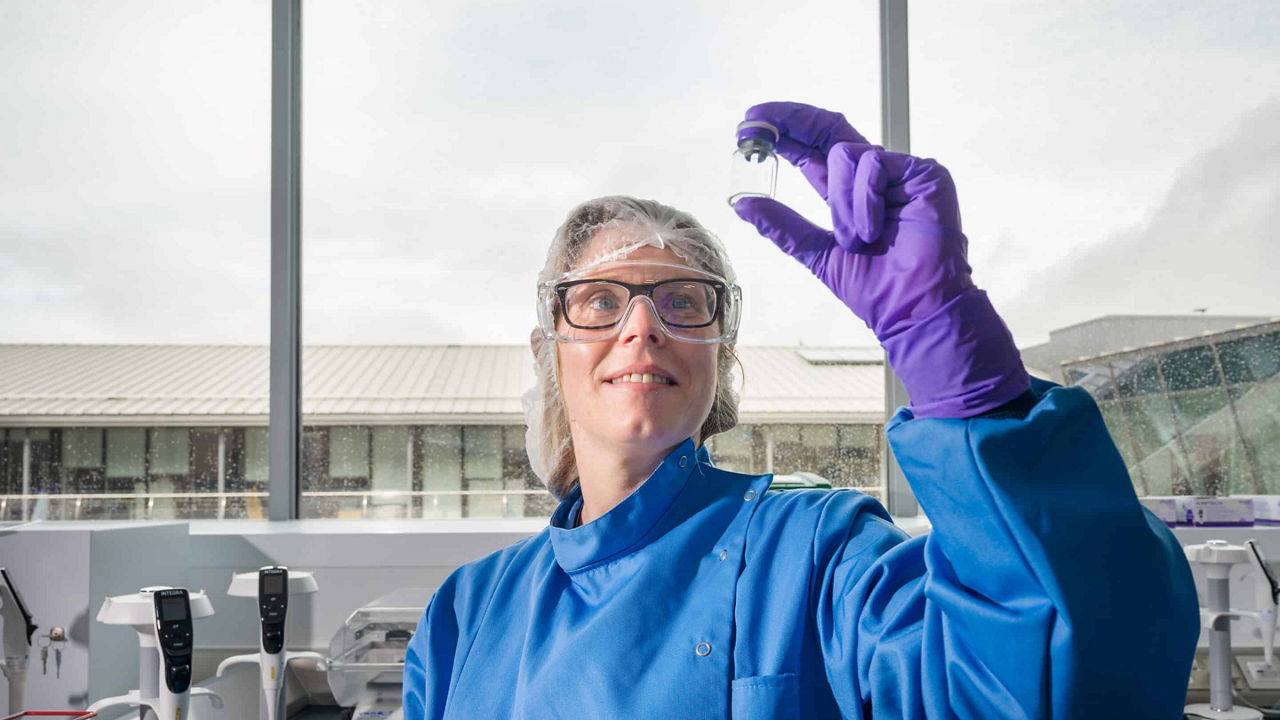
Can We Find Cures Faster?
Learn how AbbVie researchers find and advance ideas that have the potential to cure.
We solve the tough challenges.
By working closely with patients and physicians, we solve the real, complex challenges they’re facing right now, first with science and support.

Our science: First, faster, and for patients
At AbbVie, our R&D teams are chasing bold goals.
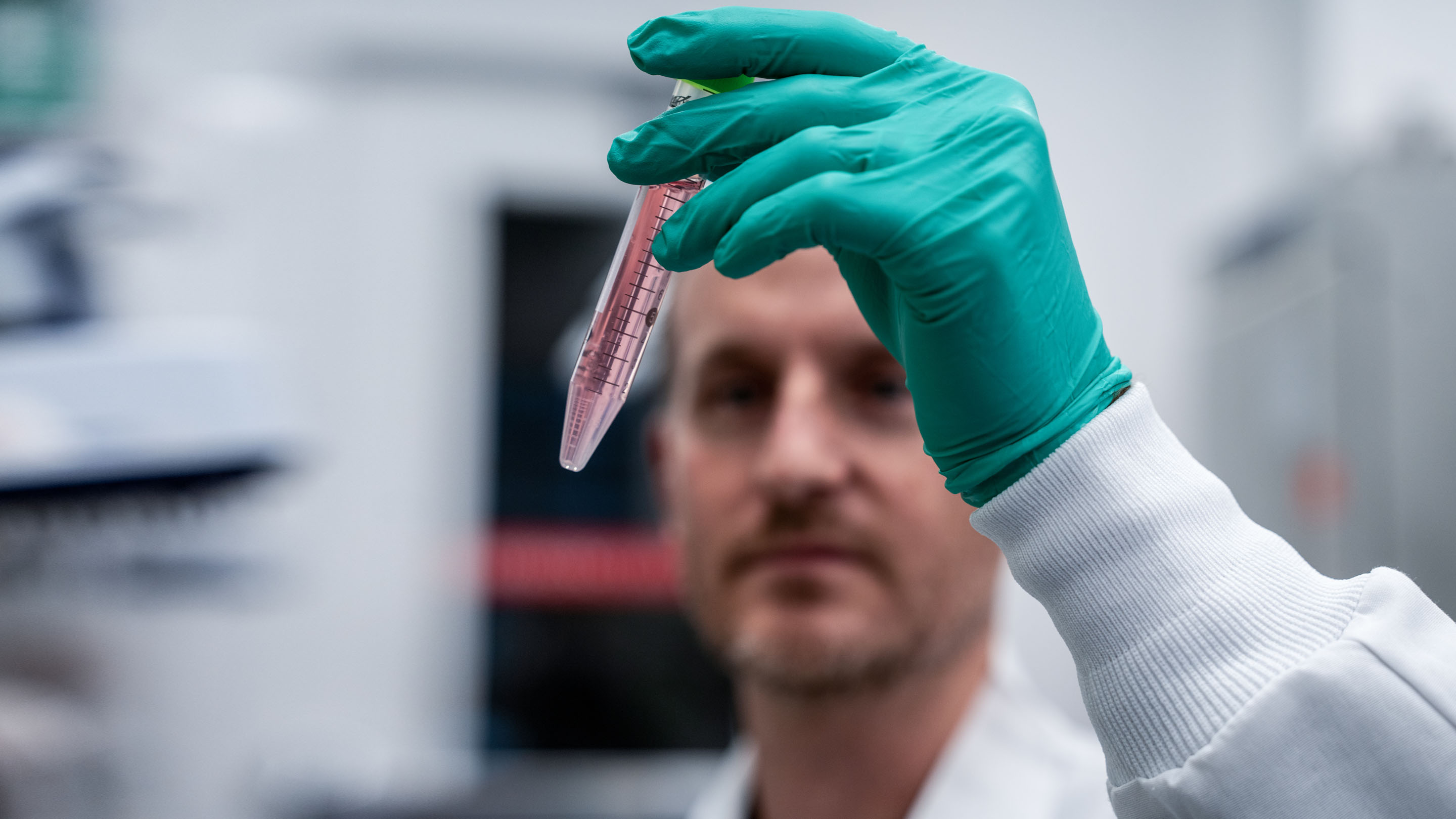
Tenacity is the anchor of solving any real challenge. It's what keeps you there, keeps you trying, keeps you driven to find that answer.
We find the answers together .
We make investments that empower our people and strengthen our partnerships.
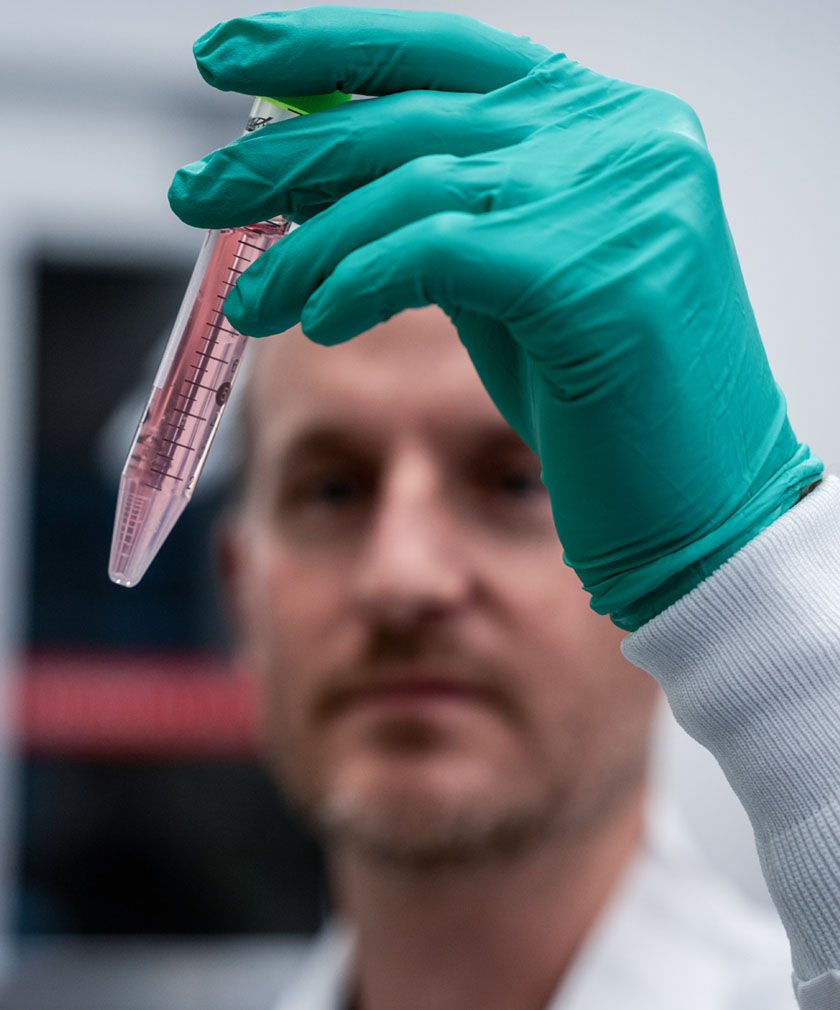
We are recognized on a number of “Best of” lists related to diversity, leadership and engagement, as well as for corporate responsibility practices.

Grow and fulfill your unique potential in our supportive environment that champions collaboration. AbbVie offers functional training, global events, leadership programs and more.

250+ active external innovation partners to conduct groundbreaking science to discover and develop transformational medicines.
Explore opportunities
If you thrive as part of a diverse, collaborative team—we’re ready for you.
We invest in creating better futures.
Our focus and capabilities address tough challenges that lead to improved lives.
AbbVie Reports Second-Quarter 2024 Financial Results
Get the latest information about abbvie.
We make an impact that lasts.
Leading with purpose, we are willing to make the tough choices that deliver a lasting impact to patients, their families and our employees.

Environmental, Social & Governance
See how we're creating positive impact for generations to come.
AbbVie’s Positions & Views
- Sustainability
- News Center
Unless otherwise specified, all product names appearing in this internet site are trademarks owned by or licensed to AbbVie Inc., its subsidiaries or affiliates. No use of any AbbVie trademark, trade name, or trade dress in this site may be made without the prior written authorization of AbbVie Inc., except to identify the product or services of the company.
Copyright © 2024 AbbVie Inc. North Chicago, Illinois, U.S.A.
- Accessibility Statement
- Terms of Use
- Privacy Notice
- Consumer Health Data Privacy Notice
- Cookie Settings
You are about to leave the AbbVie website
The product-specific site Internet site that you have requested is intended for the residents of a particular country or countries, as noted on that site. As a result, the site may contain information on pharmaceuticals that are not approved in other countries or region. If you are a resident of a country other than those to which the site is directed, please return to AbbVie.com or contact your local AbbVie affiliate to obtain the appropriate product information for your country of residence. The Internet site that you have requested may not be optimized to your screen size. Do you wish to continue to this product-specific site?
Top 10 largest clinical research organizations
We take a look at the 10 biggest contract research organizations in the pharma sector in 2022.

The drug discovery process is complex. The clinical stage is particularly resource-intensive, something that has led to the rise in demand for contract research organizations (CROs) that can support drug manufacturers at each stage of the process, from discovery to approval. The core activities a CRO can provide include (but are not limited to) clinical trial management, data research and project management.
Despite an initial downturn at the start of the pandemic, Covid-19 created a spike in the number of clinical trials taking place due to the need for vaccines and drugs to tackle the virus. In the coming years, we expect the rise of technologies that enable decentralized clinical trials to help expand the market share of CROs.
Currently the global CRO services market is projected to grow from US$73.38 bn to $163.48 bn by 2029. Here Pharma IQ takes a look at the 10 biggest CROs in pharma today.
Founded in 1982, IQVIA is an American multinational company formed through the merger of Quintiles, a leading provider of product development and integrated healthcare services, and IMS Health, a global information and technology services company. The latter has enabled company to have a strong focus on digital solutions and analytics. In 2017, Quintiles IMS rebranded to IQVIA.
Laboratory Corporation of America Holdings, also known as Labcorp, is an American company that operates one of the largest clinical laboratory networks in the world. In an average week Labcorp processes tests on more than 3 million patient specimens. In 2020 the company earned revenue in excess of $14 bn.
Syneos Health
Founded in 1999, Syneos Health was created following the merger of two biopharmaceutical companies: INC Research and inVentive health. Today it has offices in more than 110 countries and offers services as a CRO as well as consultancy.
Founded in 1985 as a one-person consultancy firm, Pharmaceutical Product Development (PPD) is a global contract research organization that provides drug development, lab and lifecycle management services. In 2020 the company made US$4.7bn and the following year it became part of Thermo Fisher Scientific.
Headquartered in Dublin, Icon provides strategic management and support for clinical development from the compound selection stage through to clinical trials. Its services include clinical trials management, biometric activities, investigator recruitment and outcomes research.
Parexel was founded in 1982 and acquired by private equity firm Pamplona Capital in 2017 in a deal worth $5 bn. In 2021 it was bought by EQT Private Equity and Goldman Sachs Asset Management. The company conducts clinical trials and operates in more than 50 countries. It makes around $3 bn in revenue annually.
Charles River Laboratories
Founded in 1947, today this company specializes in cell and gene therapies as well as lab services for the pharmaceutical, medical device and biotech industries. As of 2021 it operates more than 90 facilities in 20 countries and has an annual revenue of $3.54 bn.
Award-winning MedPace has offices on six continents, with headquarters in Ohio where it has a clinical research campus and a number of clinical and bioanalytical laboratories. It provides clinical trial services for Phase I-IV studies in the biotech, pharma and medical device industries. Its revenue has been growing steadily year- on-year and is currently almost $1 bn.
CTI Clinical Trial and Consulting Services
This organization was founded in 1999 to provide clinical trial services and bring new drugs to market. It operates in more than 60 countries and since its inception has contributed to the approval of more than 150 new drugs and medical devices around the world.
WuXi AppTec
Founded in 2000 in Shanghai, WuXi AppTec is the newest company in our top 10. It provides services across the entire development cycle including small molecule R&D and manufacturing, biologics R&D and manufacturing, cell and gene therapy. It currently operates in 18 locations across China, Iceland and the US.
Quick links
- How to improve the success rate of clinical trials
- Webinar: The technology enabling decentralized clinical trials
- The challenges of handling and delivering highly potent oncology drugs
Get exclusive access to member-only articles, reports, videos, interviews, webinars and other premium content from industry experts and thought leaders by signing up to Pharma IQ here .
Upcoming Events
Digit pharma & health 2024.
September 10 - 12, 2024 Hilton Düsseldorf

Temperature Control and Logistics North America Summit
September 10 - 12, 2024 Falls Church, VA

AI for Pharma & Healthcare
24 - 26 September, 2024 Amsterdam Marriott Hotel

SmartLab Exchange Europe
February 25 - 26, 2025 Novotel Amsterdam City, Netherlands

Pharma Contract Manufacturing
08 - 10 April, 2025 Berlin

SmartLab Exchange USA 2025
08 - 09 April, 2025 Le Méridien, Fort Lauderdale, Florida, USA

Subscribe to our Free Newsletter
Insights from the world’s foremost thought leaders delivered to your inbox.
Latest Webinars
Pharma iq's power list 2022: in conversation with pharma's top leaders.
2022-10-18 02:00 PM - 03:00 PM BST

A post-pandemic 3D view of the patient and supply journey
2022-06-01 04:30 PM - 05:30 PM CET

Discover how targeted radiotherapy induced toxicity can be identified with imaging
2022-04-28 01:00 PM - 02:00 PM EST

RECOMMENDED

FIND CONTENT BY TYPE
- Infographics
Pharma IQ COMMUNITY
- Advertise With Us
- User Agreement
- Cookie Policy
- Become a Member Today
- Pharma IQ App
ADVERTISE WITH US
Reach Pharmaceuticals & Biotechnology professionals through cost-effective marketing opportunities to deliver your message, position yourself as a thought leader, and introduce new products, techniques and strategies to the market.
JOIN THE Pharma IQ COMMUNITY
Join Pharma & Biotech today and interact with a vibrant network of professionals, keeping up to date with the industry by accessing our wealth of articles, videos, live conferences and more.

Pharma IQ, a division of IQPC
Careers With IQPC | Contact Us | About Us | Cookie Policy
Become a Member today!
PLEASE ENTER YOUR EMAIL TO JOIN FOR FREE
Already an IQPC Community Member? Sign in Here or Forgot Password Sign up now and get FREE access to our extensive library of reports, infographics, whitepapers, webinars and online events from the world’s foremost thought leaders.
We respect your privacy, by clicking 'Subscribe' you will receive our e-newsletter, including information on Podcasts, Webinars, event discounts, online learning opportunities and agree to our User Agreement. You have the right to object. For further information on how we process and monitor your personal data click here . You can unsubscribe at any time.
Top 15 Clinical Research Companies: Leaders in Medical Innovation
What’s on this page:
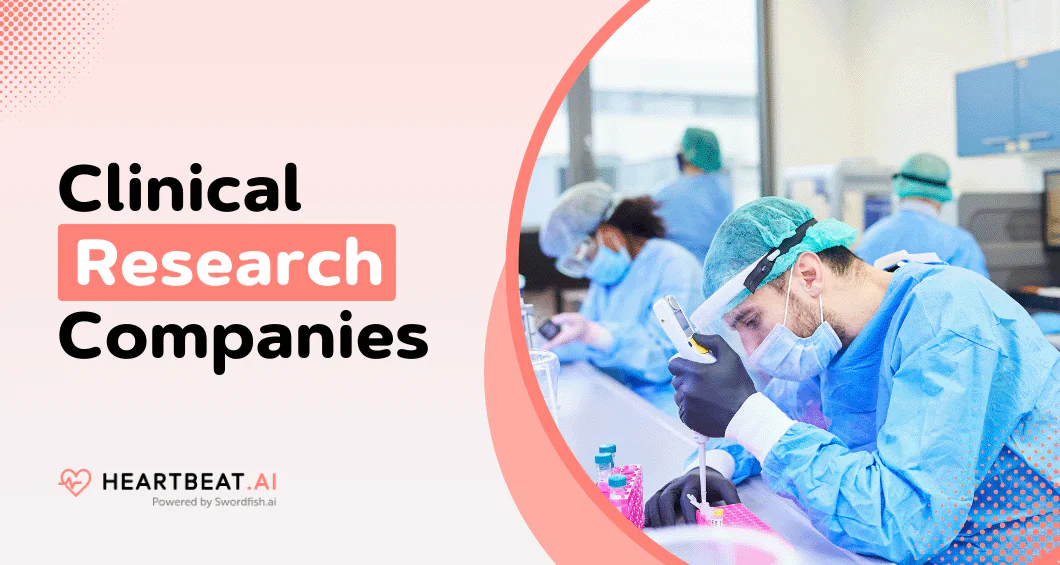
In the healthcare industry, the number of contract research organizations in the US has reached 2,823 in 2023. This marks a subtle but significant increase of 0.9% compared to the previous year.
This increase signals a vital trend: the growing complexity of finding the best clinical research companies in a crowded field. These organizations aren’t just businesses; they’re important in advancing medicine and developing drugs and therapies.
With such an important task, choosing the right company becomes essential. In this guide, we’ve looked closely at many companies along with their strengths and weaknesses and made a list of the top clinical research organizations.
By the end, you’ll know which company is the best fit for your needs.
Quick List of Top 15 Clinical Research Companies
Here is a quick overview of the best companies of clinical research:
- IQVIA: Best for data-driven insights and advanced analytics in healthcare research.
- ICON: Best for comprehensive clinical development services and therapeutic expertise.
- Parexel: Best for global biopharmaceutical services, emphasizing regulatory and clinical trial excellence.
- Syneos Health: Best for integrated biopharmaceutical solutions and clinical-commercial capabilities.
- PPD: Best for drug development services with innovative, technology-enhanced trial strategies.
- Labcorp: Best for comprehensive clinical testing and diagnostics services with global reach.
- Medpace: Best for expertise in clinical research and regulatory affairs for pharmaceutical companies.
- Charles River Laboratories: Best for preclinical research and development services, including animal testing and research models.
- PRA Health Sciences: Best for clinical trial expertise and integrated solutions for biopharmaceutical development.
- AdvanCell: Best for innovative cell and tissue-based research solutions for life science industries.
- Dynata: Best for data-driven insights and market research services for informed decision-making.
- Covance: Best for end-to-end drug development solutions, from preclinical to post-marketing.
- MedNet: Best for technology solutions and eClinical platforms for streamlined clinical trials.
- Fisher Clinical Services Inc: Best for global logistics and supply chain services for clinical trial materials.
- Worldwide Clinical Trials: Best for specialized CRO offering personalized clinical research solutions.
3 Best Clinical Research Organizations: Comparison Chart
Here’s a comparison table to highlight the key features and differences among the best companies of clinical research. This table aims to provide a quick overview of each company’s unique strengths and areas of expertise in the pharmaceutical and healthcare research sector.
| Data-driven insights, advanced analytics | Healthcare research, Data analytics | Technology-driven healthcare research services | |
| Comprehensive clinical development, expertise | Clinical development, Therapeutic research | Clinical trial and development services | |
| Regulatory expertise, clinical trial excellence | Biopharmaceutical services | Global clinical trial management |
3 Top Clinical Research Organization List For Advanced Medical Discoveries
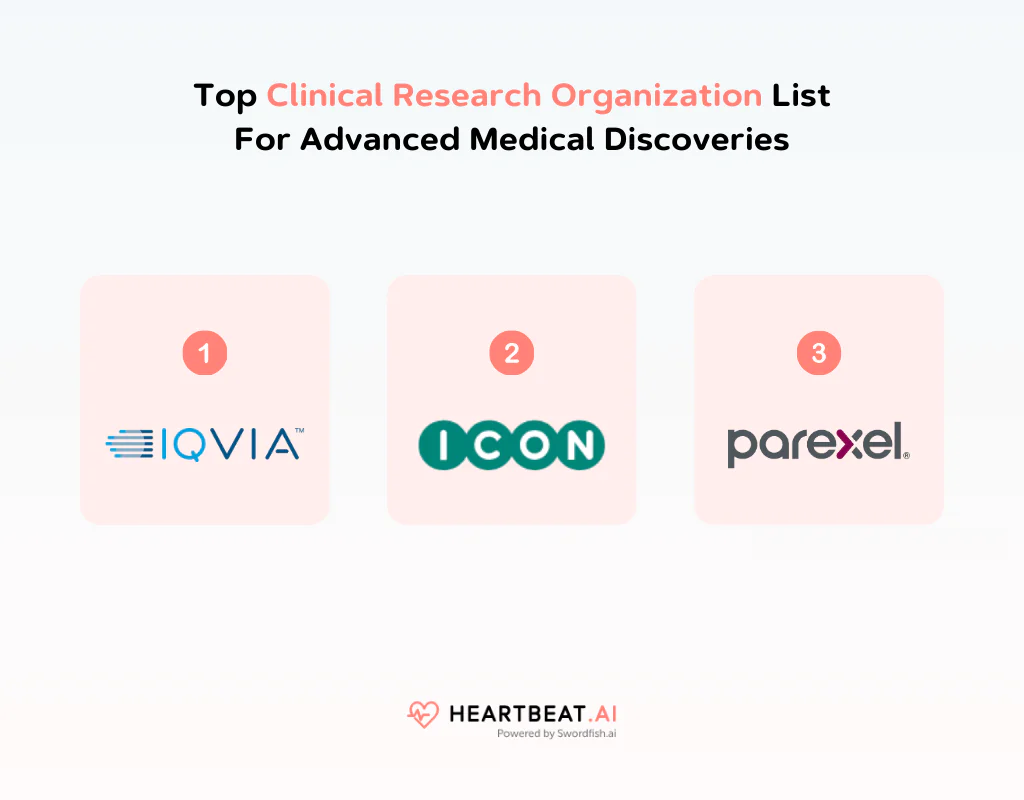
Now, we’ll explore the top clinical research organizations (CROs) dedicated to advancing medical discoveries. Let’s jump into the details of these exceptional organizations.
IQVIA is a global leader in clinical research and healthcare data analytics. They play a crucial role in the medical field by providing comprehensive data, advanced analytics, and expert insights. This helps pharmaceutical and healthcare companies make smarter, more effective decisions.
Why is IQVIA among the best? Their strength lies in their vast database and advanced technology, which enable them to analyze complex healthcare data efficiently. This leads to a better understanding of diseases, more effective treatments, and faster drug development.
IQVIA’s work is essential because it speeds up the process of bringing new medicines to the market, ultimately benefiting patients worldwide. In short, IQVIA is a key catalyst in advancing global healthcare.

About IQVIA
- Founding Team: Dennis Gillings
- Founding Year: 1982
- Company Size: 86,000
Features of IQVIA
IQVIA, a prominent player in the life sciences sector, is dedicated to advancing healthcare through connected intelligence. Here are some key features of IQVIA in the world of clinical research:
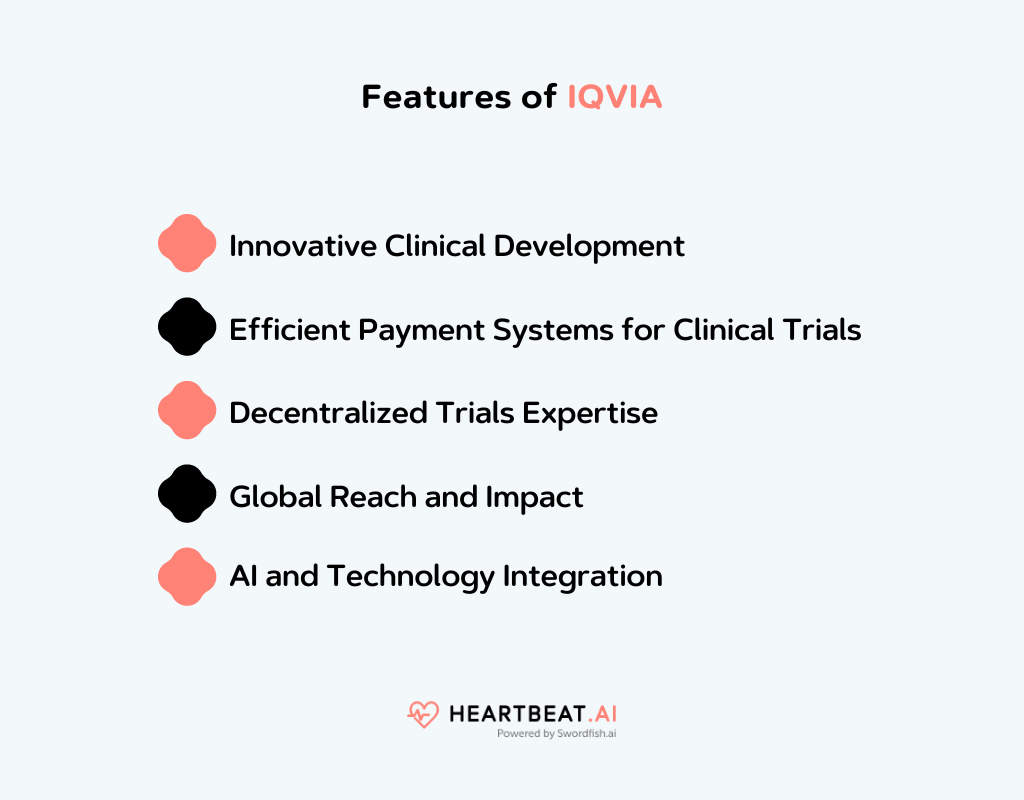
Innovative Clinical Development
IQVIA is reimagining clinical development by intelligently connecting data, technology, and analytics. This approach leads to faster decision-making and reduced risk, enabling the delivery of life-changing therapies more quickly.
Efficient Payment Systems for Clinical Trials
They have simplified the process of paying sites involved in clinical trials. IQVIA offers the capability to make payments within 30 days, even in challenging locations. This significantly reduces the administrative burden of managing clinical trial payments by up to 90%.
Decentralized Trials Expertise
The company has conducted over 500 studies in more than 75 countries, covering over 30 indications using decentralized trial methodologies. This demonstrates their capability in managing complex, multinational clinical trials.
Global Reach and Impact
With a presence in various regions, including Australia, New Zealand, the Middle East, and Africa, IQVIA’s global footprint allows it to drive healthcare innovations worldwide.
AI and Technology Integration
The company is at the forefront of integrating AI and other technologies in healthcare. Their Healthcare-grade AI promises precision, speed, scale, trust, and reliability, essential for advancing health and improving patient outcomes.
- Extensive, reliable healthcare data enhances market research quality.
- Utilizes AI and machine learning for advanced healthcare insights.
- Specialized focus yields a deep understanding of healthcare dynamics.
- Broad international presence enables diverse and large-scale studies.
- Offers advanced tools for insightful healthcare data analysis.
- Advanced tools can be challenging to use without training.
- Handling sensitive health data raises privacy and security issues.
Our Review of IQVIA
IQVIA, a prominent player in the healthcare and life sciences industry, presents a mixed bag of strengths and weaknesses. On the positive side, we appreciate IQVIA’s extensive expertise in data analytics and healthcare consulting.
Their comprehensive research and analysis have undoubtedly driven valuable insights and innovations in the sector. Moreover, their global presence allows for diverse perspectives and access to critical healthcare data.
However, we must also acknowledge some shortcomings. IQVIA’s services can be prohibitively expensive for smaller organizations, limiting accessibility. Additionally, the sheer volume of data can sometimes lead to information overload, making it challenging to extract actionable insights.
ICON is a prominent company in the field of clinical research, playing a significant role in advancing medical science. They specialize in designing and conducting clinical trials for new medicines and treatments.
The work of ICON is crucial because they help determine the safety and effectiveness of these potential medical breakthroughs. They are considered one of the best in clinical research due to their high standards of accuracy, reliability, and ethical practices.
ICON’s expertise ensures that the clinical trials they manage are conducted efficiently and effectively, leading to faster approval of new treatments. This directly impacts patient care, as it allows quicker access to new, potentially life-saving medicines.
In essence, ICON’s contribution is vital in driving forward medical innovations.
- Founding Team: John Climax and Ronan Lambe
- Founding Year: 1990
- Company Size: 41,160
Features of ICON
Here are some of the key features of ICON in clinical research:
Diverse Clinical and Scientific Operations
ICON offers a wide range of clinical and scientific operations services, ensuring comprehensive support for various aspects of clinical trials. This includes everything from study design to execution and data analysis.
Decentralized Clinical Trial Solutions
They provide end-to-end services, operational models, and technology to deliver customized solutions for decentralized clinical trials. This approach is increasingly important in today’s clinical research landscape, offering flexibility and efficiency.
Specialized Therapeutic Areas
ICON has expertise across multiple therapeutic areas including cardiovascular, central nervous system, endocrine & metabolic disorders, infectious diseases, internal medicine & immunology, oncology, and more. This broad expertise allows them to handle a wide range of clinical research projects.
Innovative Solutions for Biotech
ICON provides full-service outsourcing and flexible support customized to the specific needs of biotech companies. This includes due diligence and asset valuation, which are critical for biotech firms navigating the complex landscape of drug development.
Advanced Medical Imaging Solutions
Their expert medical imaging solutions support all stages of clinical research, improving decision-making, increasing efficiency, and reducing trial costs.
- Decades of expertise ensure high-quality clinical research.
- Offers wide-reaching capabilities for multi-regional clinical studies.
- Deep understanding of global regulations enhances compliance and efficiency.
- Invests in new technologies for more efficient trial processes.
- Broad range of specialties contributes to comprehensive service offerings.
- Managing multi-regional trials can lead to logistical challenges.
- Rapid growth may strain resources and affect service quality.
Our Review of ICON
When we researched ICON, we found both commendable aspects and areas for improvement. On the positive side, we appreciate their commitment to clinical research and their global presence, which allows for diverse study options. Their experienced team and advanced technology contribute to reliable data collection and analysis.
However, there are some drawbacks to consider. We have noticed occasional delays in project timelines, which can be frustrating. Additionally, the cost of their services tends to be on the higher side, making it a potential barrier for smaller research endeavors.
Parexel is a globally recognized company in clinical research, known for its important role in developing new medical treatments. They are one of the biggest clinical research organizations. Parexel conducts clinical trials, crucial steps in testing the safety and effectiveness of new drugs.
The work of Parexel is essential because it bridges the gap between medical research and the availability of new treatments to patients. One of the reasons they stand out as one of the best in this field is their rigorous approach to research.
Their commitment to quality and their global network also enables diverse and large-scale studies, setting them apart from others in the field. These strengths allow Parexel to deliver reliable and valuable data, accelerating the process of bringing new, effective medicines to the market.
Simply put, Parexel is a key player in transforming medical research into real-world health solutions.
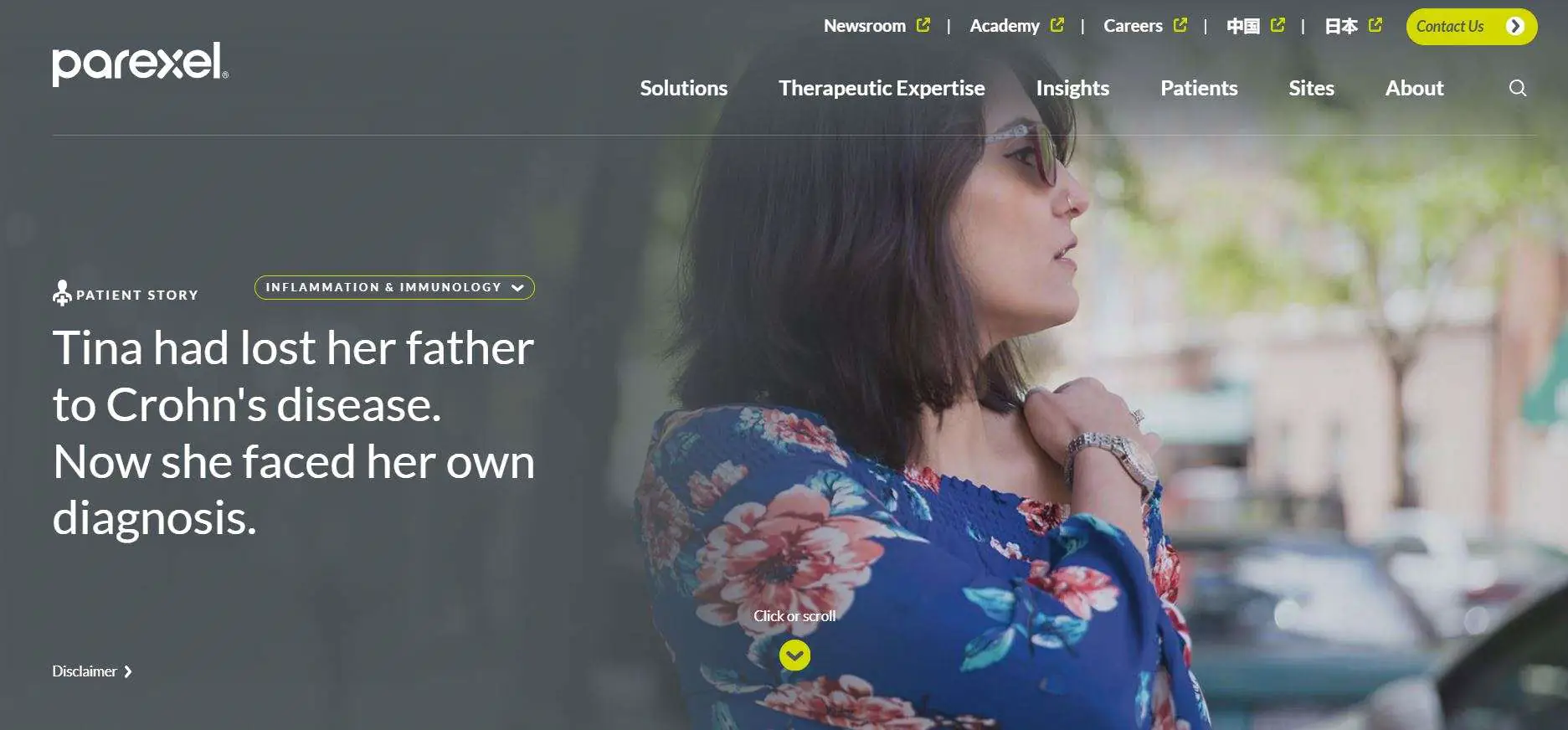
About Parexel
- Founding Team: Josef von Rickenbach and Anne B. Sayigh
- Company Size: 18,900
Features of Parexel
Parexel, a global biopharmaceutical services organization, offers a range of features in clinical research. Here are some key aspects of their approach:
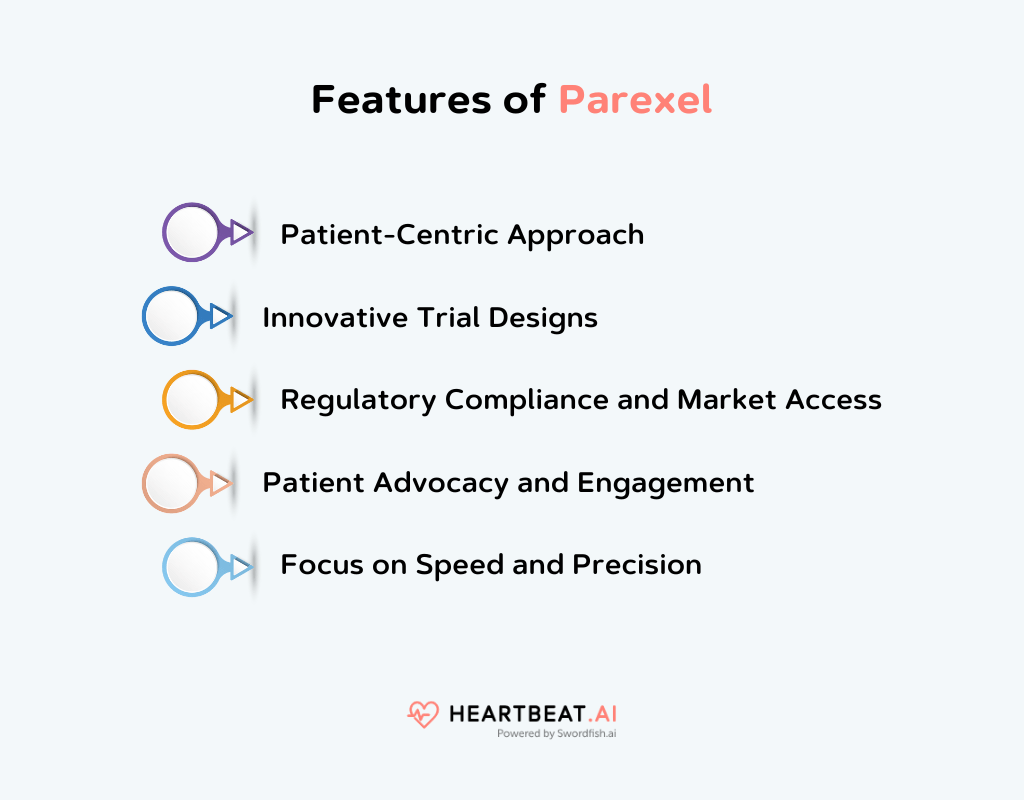
Patient-Centric Approach
Parexel emphasizes a patient-first strategy in their clinical trials. This approach results in deeper and more relevant insights for trial design and execution. This ensures that the trials are more aligned with patient needs and experiences.
Innovative Trial Designs
Parexel employs innovative trial designs to optimize trials for maximum impact. This includes advanced modeling and simulation to predict drug effects ahead of time, which can save time, money, and resources.
Regulatory Compliance and Market Access
Parexel designs studies and endpoints with market access in mind, ensuring that they satisfy global regulations. This approach helps in getting treatments to patients safely and quickly.
Patient Advocacy and Engagement
The company includes patient advocates in their council, using their experiences to improve trial designs. This inclusion demonstrates their commitment to understanding and incorporating patient perspectives in clinical research.
Focus on Speed and Precision
Parexel aims to design neuroscience trials with speed and precision, utilizing the right experts and specializations. This focus is crucial in delivering effective treatments on time.
- Provides advanced technology and analytics for efficient data management.
- Extensive network provides global insights with regional knowledge.
- Expertise in navigating complex regulatory environments worldwide.
- Broad experience across various therapeutic areas ensures versatile solutions.
- Focuses on patient engagement for more effective trial outcomes.
- Rapid expansion can lead to challenges in resource management.
- Concentration in specific areas could pose risks in market shifts.
Our Review of Parexel
Parexel is a notable player in the field of clinical research and pharmaceutical services. We’ve thoroughly analyzed their offerings and found both strengths and areas that need improvement.
On the positive side, Parexel excels in its commitment to innovation and technology. We appreciate their continuous efforts to simplify clinical trials and drug development processes, making them more efficient.
However, we also noticed some downsides. Communication with clients could be more transparent, with clearer updates on project progress. Additionally, there’s room for improvement in terms of ensuring consistency in service quality across different projects.
Other 12 Companies of Clinical Research
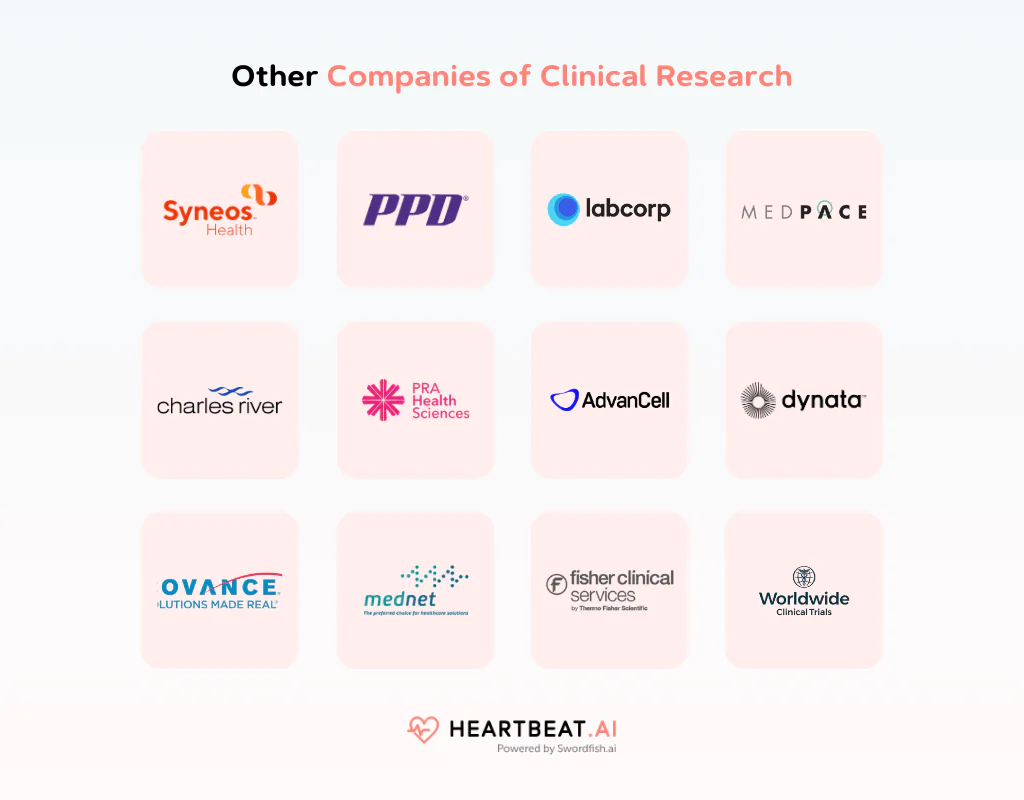
In the world of clinical research, beyond the well-known names, there are 12 other companies making significant contributions. Let’s explore their vital role in advancing healthcare.
1. Syneos Health
Syneos Health helps develop medicines by managing clinical trials for new drugs. They’re essential because they ensure medicines are safe and effective. Syneos Health stands out in clinical research for its comprehensive services and global reach, making drug development smoother and faster.
About Syneos Health
- Founding Team: Colin Shannon
- Founding Year: 1980
- Company Size: 28,000
PPD is a group that tests new drugs to see if they’re good and safe. This is crucial for getting new treatments to people. They stand out for their thorough research and global reach.
- Founding Team: Fred Eshelman
- Founding Year: 1985
- Company Size: 40,000+3
Labcorp does important tests and research for health. They’re needed because they help find out if new treatments are good. They’re among the best for their big labs and fast results.
About Labcorp
- Founding Team: Matthew Benger
- Founding Year: 1978
- Company Size: 75,5000
Medpace focuses on making sure new health treatments are safe. This is key for better medicine. They’re a top choice because of their focus on quality and detail in research.
About Medpace
- Founding Team: August Troendle
- Founding Year: 1992
- Company Size: 5,400
5. Charles River Laboratories
Charles River Laboratories tests drugs and does research to help pets and people stay healthy. They’re essential for safe, new treatments. Their expertise makes them a leader in the field.
About Charles River Laboratories
- Founding Team: Henry Foster
- Founding Year: 1947
- Company Size: 21,400
6. PRA Health Science
PRA Health Science works on finding out if new medicines are safe. This helps everyone get better treatments. They’re known for their excellent research and care in studies.
About PRA Health Science
- Founding Year: 1976
- Company Size: 17,000+
7. AdvanCell
AdvanCell specializes in new treatments, checking if they’re safe and working. Their work is vital for progress in medicine. They’re recognized for their innovation in research.
About AdvanCell
- Founding Team: Andrew Adamovich
Dynata gathers data for health studies. They’re needed for understanding what works in healthcare. They’re a top name for their accurate and wide-reaching data collection.
About Dynata
- Founding Team: Mike Petrullo
- Founding Year: 1940
- Company Size: 5000-10000
Covance helps with drug tests and research to fight diseases. Their role is key for new treatments. They’re celebrated for their comprehensive services and global impact.
About Covance
- Founding Team: Fred Cummings
- Founding Year: 1981
- Company Size: 50,000
MedNet provides software for managing clinical trials. This helps in making research easier and faster. They’re among the best for their tech solutions in research.
About MedNet
- Founding Team: John “Rob” Robertson
- Founding Year: 1996
- Company Size: 51-200
11. Fisher Clinical Services Inc.
Fisher Clinical Services Inc. manages the logistics of clinical trials, ensuring that treatments are tested efficiently. Their work is crucial for the progress of medicine, and they are renowned for their reliability and global network.
About Fisher Clinical Services Inc.
- Founding Team: John Pickering
- Founding Year: 1989
12. Worldwide Clinical Trials
Worldwide Clinical Trials conducts essential research to evaluate new medical treatments. Their work is critical for advancing healthcare. They are distinguished by their global expertise and commitment to innovation in clinical research.
About Worldwide Clinical Trials
- Founding Team: Neal Cutler
- Founding Year: 1986
- Company Size: 3,147
What To Consider When Choosing the Best Clinical Research Companies?
Choosing the right clinical research company (CRC) is crucial for the success of any clinical trial. Here’s a detailed guide on what to consider:

Expertise and Specialization
Always ensure the CRC has expertise in your specific therapeutic area. Companies with experience in similar drug trials or medical devices can better navigate the complexities of your project.
Regulatory Compliance
The CRC must adhere to regulatory guidelines like FDA (US) , EMA (Europe), and others. Check their track record in meeting these standards to avoid compliance issues.
Reputation and Track Record
You should research the company’s history. Look for testimonials, case studies, and reviews from past clients. A company with a strong reputation is likely to deliver quality results.
Project Management Capabilities
Effective project management is key. Assess their ability to manage timelines, budgets, and communication. A CRC that provides transparent, regular updates is preferable.
Patient Recruitment Strategies
Patient recruitment can be challenging. Evaluate their strategies for participant recruitment and retention. Consider their demographic reach and methods for ensuring a diverse participant pool.
Data Management and Analysis
The CRC should have strong systems for data collection, management, and analysis. Ask about their use of Electronic Data Capture (EDC) systems and how they handle data security and confidentiality.
Cost and Financial Terms
Get a clear understanding of the cost structure. Consider the value for money rather than just the lowest cost. Ensure there are no hidden fees and clarify what is included in the quoted price.
How Heartbeat AI Can Help You Get the Best List of Clinical Research Organizations?
Heartbeat AI, with its advanced features, can significantly assist in identifying the best list of clinical research organizations (CROs). Here’s how its various features contribute to this process:
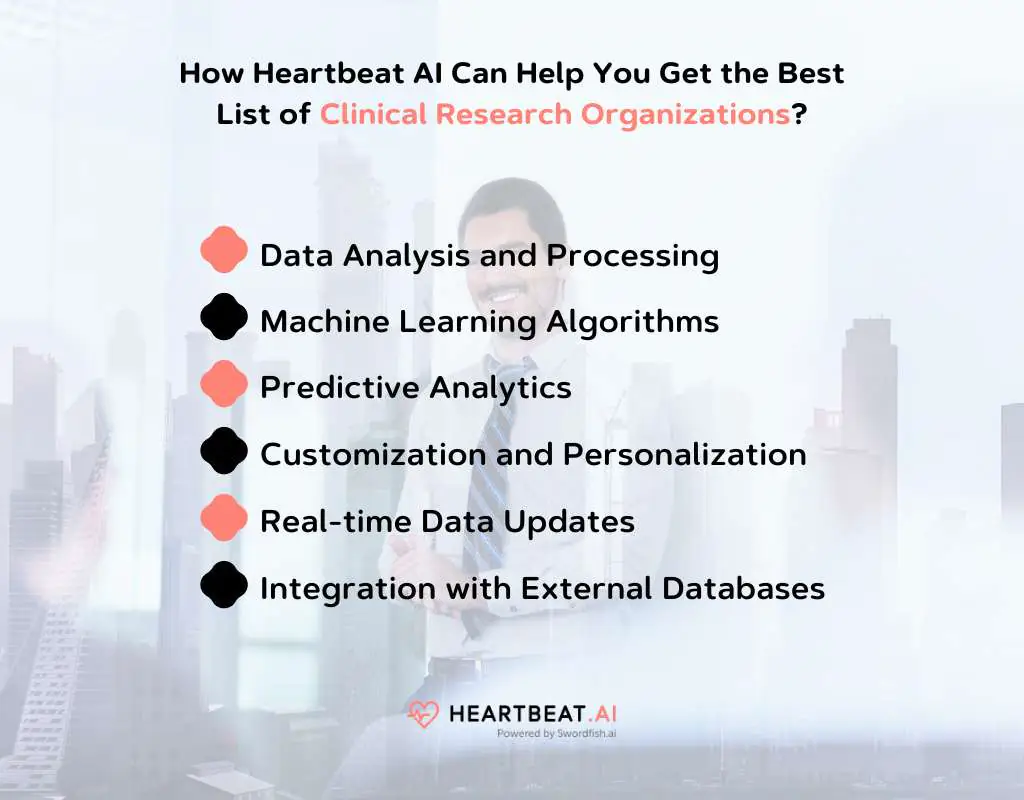
Data Analysis and Processing
Heartbeat AI excels in analyzing vast amounts of data. When it comes to selecting CROs, it can process and analyze information from numerous sources, including past performance records, clinical trial reports, and regulatory compliance data. This thorough analysis helps in identifying CROs with a proven track record of success and reliability.
Machine Learning Algorithms
These algorithms enable Heartbeat AI to learn from historical data and improve its recommendations over time. By understanding trends and patterns in the successful execution of clinical trials, it can better predict which CROs are likely to meet your specific needs.
Predictive Analytics
Heartbeat AI uses predictive models to forecast future trends and outcomes based on historical data. This can be invaluable in predicting the success rate of CROs in upcoming projects, thus aiding in making more informed choices.
Customization and Personalization
The AI can be customized to your specific requirements. If you’re focusing on a specific therapeutic area or clinical trial phase, Heartbeat AI can prioritize specialized CROs in these fields.
Real-time Data Updates
The healthcare and pharmaceutical landscapes are constantly changing. Heartbeat AI’s ability to integrate and analyze real-time data ensures that the recommendations are based on the most current information available.
Integration with External Databases
Heartbeat AI can integrate with various external databases and platforms. This enables it to pull in comprehensive information about CROs from diverse sources, enhancing the accuracy of its recommendations.
Claim $500 of Free Data
Summing up, we’ve explored the best clinical research companies, diving into their features, strengths, weaknesses, and more. Clinical research is vital in healthcare; it’s key for advancing medical knowledge and developing new treatments.
With this guide, you’re equipped to find the right clinical research company that meets your specific needs. Whether it’s for innovative therapies, drug development, or medical advancements, choosing the right partner is crucial. This guide serves as a valuable resource to help you make an informed decision in the complex world of clinical research.
Frequently Asked Question
What services do companies of clinical research offer.
Clinical research organizations offer a wide range of services, including protocol development, patient recruitment, data collection and analysis, regulatory compliance, and more.
What is the role of a clinical research coordinator?
A clinical research coordinator is responsible for managing various aspects of a clinical trial, including patient recruitment, data collection, and ensuring compliance with protocols.
What is informed consent in clinical research?
Informed consent is the process by which participants in a clinical trial are fully informed about the study’s purpose, risks, and benefits. They voluntarily agree to participate based on this information.
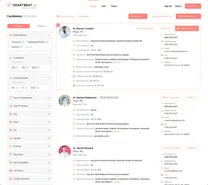
- Health, Pharma & Medtech ›
- Pharmaceutical Products & Market
Pharmaceutical research and development (R&D) – statistics & facts
The rise of r&d investment, why do companies invest in r&d, the characteristics of the r&d pipeline, key insights.
Detailed statistics
Total global pharmaceutical R&D spending 2014-2028
Top 50 pharmaceutical companies - Rx sales and R&D spending 2023
Pharmaceuticals: cost of drug development in the U.S. since 1975
Editor’s Picks Current statistics on this topic
Industry & Market
Top pharma companies worldwide 2024, by size of R&D pipeline
U.S. pharma industry R&D spending as a percent of total revenues 1990-2023
R&D cost to develop new pharmaceutical compounds 2010-2020
Further recommended statistics
- Premium Statistic Total global pharmaceutical R&D spending 2014-2028
- Premium Statistic R&D spending growth worldwide on pharmaceuticals 2015-2028
- Premium Statistic Growth rate of R&D spending in pharmaceutical industry by major region 2007-2023
- Premium Statistic Number of drugs in the R&D pipeline worldwide 2001-2024
- Basic Statistic Pharma companies worldwide with active R&D pipelines 2001-2024
- Basic Statistic Projected most valuable R&D projects based on net present value 2023
Total global pharmaceutical R&D spending 2014-2028
Total global spending on pharmaceutical research and development from 2014 to 2028 (in billion U.S. dollars)
R&D spending growth worldwide on pharmaceuticals 2015-2028
Global growth in total pharmaceutical R&D spending from 2015 to 2028
Growth rate of R&D spending in pharmaceutical industry by major region 2007-2023
Annual growth of pharmaceutical R&D spending in Europe, the U.S., and China between 2009 and 2023
Number of drugs in the R&D pipeline worldwide 2001-2024
Total number of drugs in the R&D pipeline worldwide from 2001 to 2024
Pharma companies worldwide with active R&D pipelines 2001-2024
Total number of pharmaceutical companies with active R&D pipelines worldwide from 2001 to 2024
Projected most valuable R&D projects based on net present value 2023
Selected top pharmaceutical R&D projects based on net present value (NPV) as of December 2023 (in billion U.S. dollars)
R&D performance by company
- Premium Statistic R&D spending share of top pharmaceutical companies 2023
- Basic Statistic Top pharmaceutical companies in R&D spending growth 2022
- Basic Statistic Top 50 global pharmaceutical and biotech companies by R&D intensity in 2022
- Premium Statistic Top pharma companies worldwide 2024, by size of R&D pipeline
- Premium Statistic Distribution of pharmaceutical R&D companies by region 2023 vs. 2024
R&D spending share of top pharmaceutical companies 2023
R&D spending as revenue share of leading 10 pharmaceutical companies in 2023
Top pharmaceutical companies in R&D spending growth 2022
World's top 50 pharmaceutical and biotechnology companies based on R&D spending growth in 2022
Top 50 global pharmaceutical and biotech companies by R&D intensity in 2022
World's top 50 pharmaceutical and biotechnology companies based on R&D intensity in 2022
Top pharma companies worldwide 2024, by size of R&D pipeline
Leading 15 pharmaceutical companies worldwide by size of R&D pipeline as of 2024
Distribution of pharmaceutical R&D companies by region 2023 vs. 2024
Distribution of pharmaceutical R&D companies worldwide as of 2023 and 2024, by country
Characteristics of R&D pipeline
- Basic Statistic Top therapeutic categories worldwide 2024, by number of R&D products
- Premium Statistic Worldwide top diseases 2024, by number of active drugs
- Basic Statistic Worldwide top origins for pipeline drugs by number of active drugs 2024
- Basic Statistic Worldwide pipeline drugs by delivery route share 2023 vs. 2024
- Basic Statistic Worldwide top drug producing mechanisms of action by number of active compounds 2024
Top therapeutic categories worldwide 2024, by number of R&D products
Leading 15 therapeutic categories worldwide by number of R&D products as of 2024
Worldwide top diseases 2024, by number of active drugs
Leading 15 diseases worldwide by number of active drugs as of 2024
Worldwide top origins for pipeline drugs by number of active drugs 2024
Leading 15 origins of drugs in R&D pipeline worldwide by number of active drugs as of 2024
Worldwide pipeline drugs by delivery route share 2023 vs. 2024
Percentage of drugs in R&D pipeline worldwide by delivery route as of 2023 and 2024
Worldwide top drug producing mechanisms of action by number of active compounds 2024
Leading 15 mechanisms of action in R&D pipeline drugs worldwide by number of active compounds as of 2024
Duration, cost and ROI
- Basic Statistic Average length of a clinical trial cycle 2014-2022
- Basic Statistic Rate of return on biopharma R&D late stage pipeline 2013-2023
- Premium Statistic Average R&D cost to develop new biopharma compound 2013-2023
- Premium Statistic Average peak sales forecast per new biopharmaceutical asset 2013-2023
Average length of a clinical trial cycle 2014-2022
Average length of a clinical trial cycle from 2014 to 2022 (in years)
Rate of return on biopharma R&D late stage pipeline 2013-2023
Rate of return on biopharmaceutical late-stage R&D pipeline from 2013 to 2023
Average R&D cost to develop new biopharma compound 2013-2023
Average cost to develop a compound for biopharma companies from 2013 to 2023 (in billion U.S. dollars)
Average peak sales forecast per new biopharmaceutical asset 2013-2023
Projected average peak sales for each new biopharmaceutical asset from 2013 to 2023 (in million U.S. dollars)
Outsourced R&D
- Basic Statistic CRO market size worldwide forecast 2032
- Premium Statistic Leading global contract research organizations based on revenue 2023
- Premium Statistic CDMO market size worldwide forecast 2023-2033
- Basic Statistic Top pharma contract development and manufacturing companies 2022
CRO market size worldwide forecast 2032
Global contract research organization (CRO) market in 2022 and a forecast for 2032 (in billion U.S. dollars)
Leading global contract research organizations based on revenue 2023
Leading global contract research organizations (CROs) based on 2023 revenue (in million U.S. dollars)
CDMO market size worldwide forecast 2023-2033
Contract development and manufacturing organization (CDMO) market forecast worldwide from 2023 to 2033 (in billion U.S. dollars)
Top pharma contract development and manufacturing companies 2022
Leading 10 contract development and manufacturing organizations (CDMOs) based on revenue in 2022 (in billion U.S. dollars)
Public opinion/knowledge
- Basic Statistic Willingness to pay more taxes for additional medical research - U.S. adults 2019-2023
- Basic Statistic View of health research as a problem or solution for rising costs - U.S. adults 2020
- Basic Statistic Importance to support private investments in medical research by government 2022
- Premium Statistic U.S. approval of pharma companies' COVID-19 vaccine development handling 2021
- Basic Statistic Share of U.S. adults who could name a medical or health research entity 2024
- Basic Statistic Participation in clinical trials recommended by a doctor among U.S. adults 2021
Willingness to pay more taxes for additional medical research - U.S. adults 2019-2023
Would you be willing to pay $1 per week more in taxes if you were certain that all of the money would be spent on additional medical research?
View of health research as a problem or solution for rising costs - U.S. adults 2020
When it comes to rising health care costs, would you say research to improve health is part of the problem or part of the solution?
Importance to support private investments in medical research by government 2022
How important is it for the federal government to support incentives for private sector investment in new treatments and cures?
U.S. approval of pharma companies' COVID-19 vaccine development handling 2021
Percentage of U.S. adults who approve of how pharmaceutical companies handled COVID-19 vaccine development as of 2021
Share of U.S. adults who could name a medical or health research entity 2024
Percentage of adults in the United States who could name a medical or health research entity as of 2024
Participation in clinical trials recommended by a doctor among U.S. adults 2021
How likely would you be to participate in a clinical trial recommended by your doctor?
Further reports
Get the best reports to understand your industry.
Mon - Fri, 9am - 6pm (EST)
Mon - Fri, 9am - 5pm (SGT)
Mon - Fri, 10:00am - 6:00pm (JST)
Mon - Fri, 9:30am - 5pm (GMT)
What can we help you find?
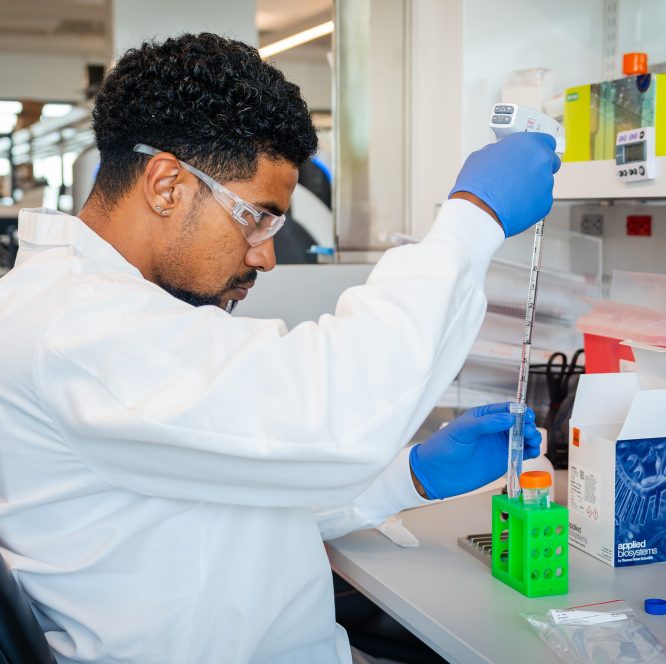
We believe research is the will to conquer the impossible and that science will lead the way.
The journey to discovery is guided by science — and inspired by patients
Every day our scientists, from all backgrounds and disciplines, work together to use the power of leading-edge science to save and improve lives.
Watch now: Merck Research Laboratories
Our research in action
People employed in R&D
Invested in R&D in 2023
Publications by our scientists
Our areas of focus
We follow the science and apply our expertise on core therapeutic areas where we have the greatest potential to help save and improve lives.

Our team of researchers and scientists are pushing the boundaries of cancer research to discover more effective anticancer therapies.
Our work in oncology

Vaccines are one of the greatest public health success stories — and we’ve been discovering, developing, supplying and delivering vaccines to help prevent disease for over 130 years.
Our work in vaccines
Infectious diseases

Our focus has always been on the prevention and treatment of diseases that threaten people and communities around the world.
Our work in infectious diseases
Cardio-metabolic disorders

We have a long history of making an impact in cardio-metabolic disorders, such as type 2 diabetes and cardiovascular disease.
Our work in cardio-metabolic disorders

We’re at the forefront of research, seeking to translate scientific discoveries into treatments for people with immune-mediated inflammatory disorders.
Our work in immunology
Neuroscience

We're tackling the complexities and therapeutic challenges of some of the most devastating neurological disorders.
Our work in neuroscience
We have a proud legacy of turning breakthrough science into medicines and vaccines that save and improve lives around the world.
Check out our pipeline
Publications
As part of our commitment to unparalleled research, our scientists and postdoctoral research fellows are encouraged to be active members of the scientific community.
Explore our publications
Clinical trials
Our progress is due in large part to the important and tough scientific questions we set out to answer with our clinical trials.
Learn about clinical trials
Business development & licensing
With a robust pipeline and portfolio fueled by both our own discoveries and external innovation, we know that collaborations are critical to advancing bold science.
Collaborate with us
Discovery & development

Journey of a molecule
Creating a medicine or vaccine is a journey — from the lab to patients.
Meet our scientists
Innovation is fueled by diverse expertise and backgrounds. Learn more about our R&D leaders pushing scientific boundaries at Merck.

Dean Li Executive vice president and president, Merck Research Laboratories

Eliav Barr Senior vice president, head of global clinical development and chief medical officer

George Addona Senior vice president and head, discovery, preclinical development and translational medicine
Where we work
Research based on innovation is at the core of who we are and what we do. It starts with the capabilities and expertise at our facilities, but we're open to collaboration anywhere the science leads us.
South San Francisco
Visit all of our R&D locations
Read our R&D stories

What is One Pipeline?
How we’re advancing the best internal and external science to progress our pipeline for patients

How Merck scientists are driving next-generation cancer research
Our scientists are accelerating research by looking to improve anti-tumor immune response, targeting specific cancer cells and helping inhibit cancer growth

In our commitment to R&D, the numbers speak for themselves
We follow the science where we can make the greatest difference

Meet two women at the forefront of our HIV research
Two esteemed scientists share their motivations and hopes for the future of HIV research

Vaccines: Our history, our legacy
We've been working to discover and develop vaccines for more than a century
Careers in R&D
We’re calling all aspiring world-class scientists who want to be a part of cutting-edge work to save and improve lives.
Related links

We’re here to help you get the information you need to guide you on your health journey.

Find our latest financials, events & presentations, news, stock information, and contacts.
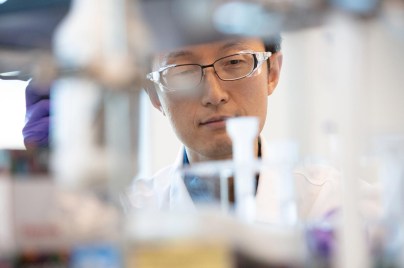
We aspire to be the premier research-intensive biopharmaceutical company.
Forward-looking statement of Merck & Co., Inc., Rahway, N.J., USA
This website of Merck & Co., Inc., Rahway, N.J., USA (the “company”) includes “forward-looking statements” within the meaning of the safe harbor provisions of the U.S. Private Securities Litigation Reform Act of 1995. These statements are based upon the current beliefs and expectations of the company’s management and are subject to significant risks and uncertainties. There can be no guarantees with respect to pipeline candidates that the candidates will receive the necessary regulatory approvals or that they will prove to be commercially successful. If underlying assumptions prove inaccurate or risks or uncertainties materialize, actual results may differ materially from those set forth in the forward-looking statements. Risks and uncertainties include but are not limited to, general industry conditions and competition; general economic factors, including interest rate and currency exchange rate fluctuations; the impact of pharmaceutical industry regulation and health care legislation in the United States and internationally; global trends toward health care cost containment; technological advances, new products and patents attained by competitors; challenges inherent in new product development, including obtaining regulatory approval; the company’s ability to accurately predict future market conditions; manufacturing difficulties or delays; financial instability of international economies and sovereign risk; dependence on the effectiveness of the company’s patents and other protections for innovative products; and the exposure to litigation, including patent litigation, and/or regulatory actions. The company undertakes no obligation to publicly update any forward-looking statement, whether as a result of new information, future events or otherwise. Additional factors that could cause results to differ materially from those described in the forward-looking statements can be found in the company’s Annual Report on Form 10-K for the year ended December 31, 2023 and the company’s other filings with the Securities and Exchange Commission (SEC) available at the SEC’s Internet site (www.sec.gov). No Duty to Update The information contained in this website was current as of the date presented. The company assumes no duty to update the information to reflect subsequent developments. Consequently, the company will not update the information contained in the website and investors should not rely upon the information as current or accurate after the presentation date.
You are leaving Merck.com
Welcome to merck.com.
By continuing, you will be directed to a site intended only for residents of the United States and Canada. We are called MSD everywhere, except in the United States and Canada where we are known as Merck & Co Inc, Rahway, NJ USA.
Learn how our solutions can help you advance your oncology drug development. Meet with our team at the European Society of Medical Oncology (ESMO) Congress at booth 522 in Barcelona, Spain, on Sept. 13-17.
We’ve been named a leader in digital solutions and services by ISG for the fourth straight year, affirming our commitment to our customers and patients around the world.
Our new GMP lab building in Middleton, Wisconsin, will enhance services in new and emerging therapeutic areas and add 350 new jobs to the region.
It’s time for a partner who drives you forward. Let’s devise strategies that position you to meet key milestones, faster.
Drive your drug development program forward. Partner with a leading provider of global clinical research solutions .

Unrivaled therapeutic expertise honed over decades
Deep expertise that covers more than 20 therapeutic areas, from established drug markets to cutting-edge R&D, to perform studies with exceptional quality.
Solutions tailored to accelerate your development
Dependable project management and delivery, underpinned by a global network, integrated data ecosystem and people-first approach.

Comprehensive laboratory services that transform drug development
Laboratory services built on innovation and award-winning technologies to enhance clinical trial performance and regulatory success.
Bring your life-saving therapies to the world
Transformative strategies that empower you to achieve key milestones faster. Because every moment counts in clinical research.

PPD FSP Solutions
The biotech mindset, optimized study planning, insights hub.

Working together, we can reimagine medicine to improve and extend people’s lives.

Research and development
Researchers in Biomedical Research work across several diseases areas to uncover insights into the origins and pathogenesis of disease to drive drug discovery and early development, while the Development organization leads the advanced clinical development of those medicines, running large clinical trials and steering the way to regulatory approval and access for patients.
This work is powered by technology platforms that help us innovate across our core therapeutic areas: Cardiovascular, Renal and Metabolic, Oncology, Immunology, and Neuroscience. We focus on two established platforms – chemistry and biotherapeutics – as well as three advanced platforms – xRNA, radioligand therapy, and gene and cell therapy – we believe will continue to play an increasingly important role in delivering new medicines for patients.

"By building on our strengths, including our long history of scientific innovation and technological leadership, we aim to discover the next generation of medicines that will make a real difference to people’s lives"
Fiona H. Marshall , President, Biomedical Research

"Our greatest impact comes from collaborating with those who share our purpose to develop new medicines that enable physicians to change their practice and ultimately reach all people who can benefit from them."
Shreeram Aradhye , President, Development and Chief Medical Officer
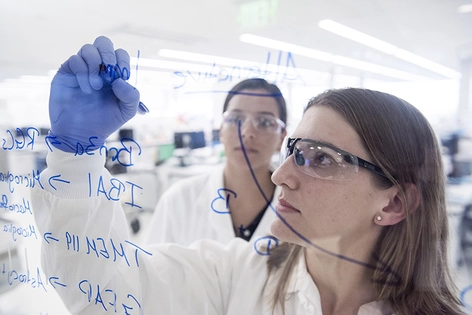
Our Research Areas
We discover and advance innovative treatments for diseases with high unmet need
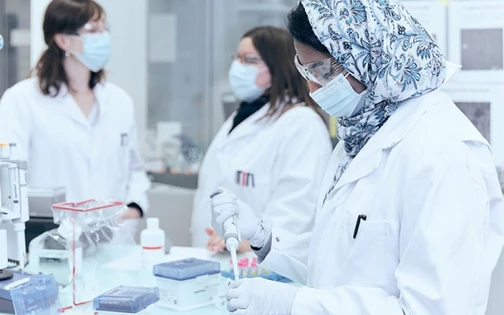
Our Pipeline
We maintain a focused portfolio of investigational medicines intended to alleviate society’s greatest disease burdens
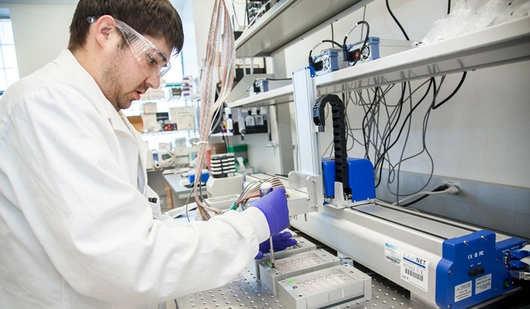
Our Technology Platforms
We’re pursuing platforms that offer more targeted approaches to treat patients
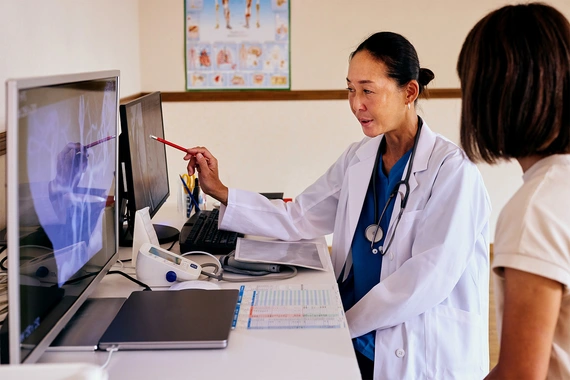
Clinical Trials
Clinical trials are at the heart of our work to bring innovative medicines to people with a particular disease or condition. These studies ensure that an investigative medicine is effective and safe, and rely entirely on patients and healthy volunteers. Learn more about clinical trials at Novartis including opportunities to get involved.
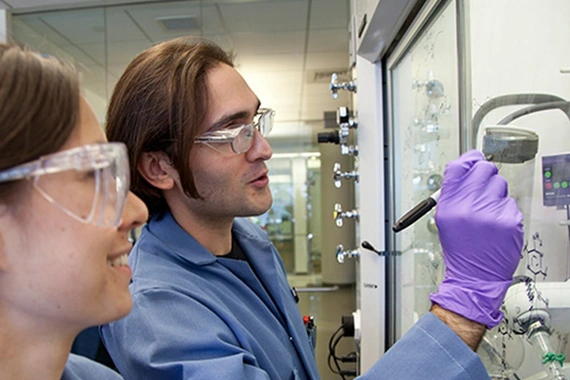
Postdoc Program
This program grants appointments to postdocs at Novartis for up to four years under dual mentorship from a Novartis mentor and an academic mentor.

Collaborations
Our science is deeply interconnected and nimble, open and accepting of criticism, prioritized to win in a competitive landscape, and – most importantly – impatient in its delivery to patients.
Our research benefits from an external network of more than 300 academic and 100 industry alliances focused on areas of mutual scientific interest.

A legacy of blood cancer innovation
Building on more than two decades of chronic myeloid leukemia research, the R&D teams at Novartis pursued an investigational treatment unlike any other.


Drug delivery, service delivery, and the future of cancer care
State-of-the-art Novartis manufacturing facility in Indianapolis fortifies the foundation of an entirely new paradigm in pharmaceutical drug delivery.

From black holes to AI driven drug discovery – collaboration wins the day
Dr Bülent Kızıltan, Global Head of AI & Computational Sciences
More stories
Recent Jobs in Research
Novartis looks for dedicated team members to join its research efforts around the world. We recruit the best and brightest at all levels of expertise.
Translational medicine research at Novartis
Too often, new therapies fail to bridge the treacherous gap that lies between research and entry into human clinical testing. Our team of translational medicine researchers work to bridge this gap and ensure that safe, effective and innovative treatments reach patients as quickly as possible.
- Health Tech
- Health Insurance
- Medical Devices
- Gene Therapy
- Neuroscience
- H5N1 Bird Flu
- Health Disparities
- Infectious Disease
- Mental Health
- Cardiovascular Disease
- Chronic Disease
- Alzheimer's
- Coercive Care
- The Obesity Revolution
- The War on Recovery
- Adam Feuerstein
Matthew Herper
- Jennifer Adaeze Okwerekwu
- Ed Silverman
- CRISPR Tracker
- Breakthrough Device Tracker
- Generative AI Tracker
- Obesity Drug Tracker
- 2024 STAT Summit
- All Summits
- STATUS List
- STAT Madness
- STAT Brand Studio
Don't miss out
Subscribe to STAT+ today, for the best life sciences journalism in the industry
A new list ranks large pharmaceutical companies by research and development
By Matthew Herper May 4, 2023

I f you want a large pharmaceutical company to invent a new drug, your best bet is probably AstraZeneca. But if you have a medicine you’d like to get to market — and you want to see it generate revenue — you might be better off with Pfizer.
That’s the message from the 12th edition of the Pharmaceutical Innovation and Invention Index, produced by the consultancy Idea Pharma, which was released Thursday at the STAT Breakthrough Summit.
advertisement
Every year, Idea ranks the largest pharmaceutical companies based on two measures: what it calls invention, which is basically how good they are at coming up with new medicines, and innovation, which the firm defines as the ability to run clinical trials, deal with regulators, handle manufacturing, and market the new medicine. The rankings themselves are interesting for those who follow pharma, and the data behind them give some key insights into how the industry as a whole is doing and what it takes to bring a new medicine to market.
STAT+ Exclusive Story
Already have an account? Log in

This article is exclusive to STAT+ subscribers
Unlock this article — plus daily coverage and analysis of the biotech sector — by subscribing to stat+..
Totals $468 per year
for 3 months, then $399/year
Then $399/year
Savings start at 25%!
Annually per user
$300 Annually per user
Get unlimited access to award-winning journalism and exclusive events.
About the Author Reprints
Senior Writer, Medicine, Editorial Director of Events
Matthew Herper covers medical innovation — both its promise and its perils.
biotechnology
life sciences
Pharmaceuticals
STAT Breakthrough Summit
STAT encourages you to share your voice. We welcome your commentary, criticism, and expertise on our subscriber-only platform, STAT+ Connect
To submit a correction request, please visit our Contact Us page .

Recommended

Recommended Stories

STAT Plus: UnitedHealth pledged a hands-off approach after buying a Connecticut medical group. Then it upended how doctors practice

STAT Plus: The weight loss drug shortage is driving patients to Hims. What happens when the shortage ends?

STAT Plus: Physicians weigh in on potential impact of Trump’s ear wound: ‘It’s a matter of inches’

STAT Plus: Centene eliminates brokers’ commissions for Medicare drug plans

STAT Plus: Lilly launches Zepbound vials in move that could ease supply constraints
Informed Research
We are a scientific research organization conducting medical and market research for biomedical and pharmaceutical firms. We have expertise in many product areas and specialize in rare diseases.
Published Results
Payors and agencies want evidence of value and efficacy. We produce scientifically valid findings that have withstood the rigors of peer-review journals and have influenced decision makers and investors.
Valid Answers
From exploring market landscapes to measuring clinical utility or product uptake, our pharmaceutical market research answers key business questions and fills critical gaps in claims or syndicated data.
CLARITY PHARMA RESEARCH ® PHARMACEUTICAL M ARKET R ESEARCH R EPORTS B ASED IN S CIENCE ™
- Testimonials
- Claims data
- Antiviral therapy
- Biologics, injectables
- Cardiovascular
- Chronic conditions
- Dermatology
- Hospital / ER
- Immunology, devices
- Kidney disease
- Neuroscience
- Pulmonology
- Rare / Orphan
- Publications
Corporate or staff memberships include ESMO , ISPOR, SOHO, ResearchGate, and:
By continuing to use this site, you consent to the use of cookies on your device unless you have disabled them.
You can change your cookie settings at any time, but some parts of this site may not function properly without them.
© 2014-2023 Clarity Pharma Research® LLC | All Rights Reserved | Privacy Policy
To learn more about our services, contact [email protected] .
- Development Consulting
Global Regulatory Consulting
- Nonclinical Studies
- Chemistry, Manufacturing, and Controls
- Quality Assurance
- Global Compliance
- Medical Affairs
- Study Design
- Biostatistics
- Medical Writing
- Premier IRT
- Study Start-Up
- Quality Management & QA
- Safety & Pharmacovigilance
- Project Management
- Data Management
- Combination Products
- Real-World & Late Phase
- Functional Service Provider
Rare Disease
- Cell & Gene Therapy
- Oncology & Hematology
- Dermatology
- Diagnostics
- Medical Device
- Digital Therapeutics
Neuroscience
- Women’s Health
- Other Experience
- Premier Perspectives Blog
- Resource Center
- Frequently Asked Questions
- Our Approach
- Corporate Social Responsibility
- Investigators
Built for Biotech TM
We help the most innovative companies transform life-changing ideas and breakthrough science into new medical treatments.
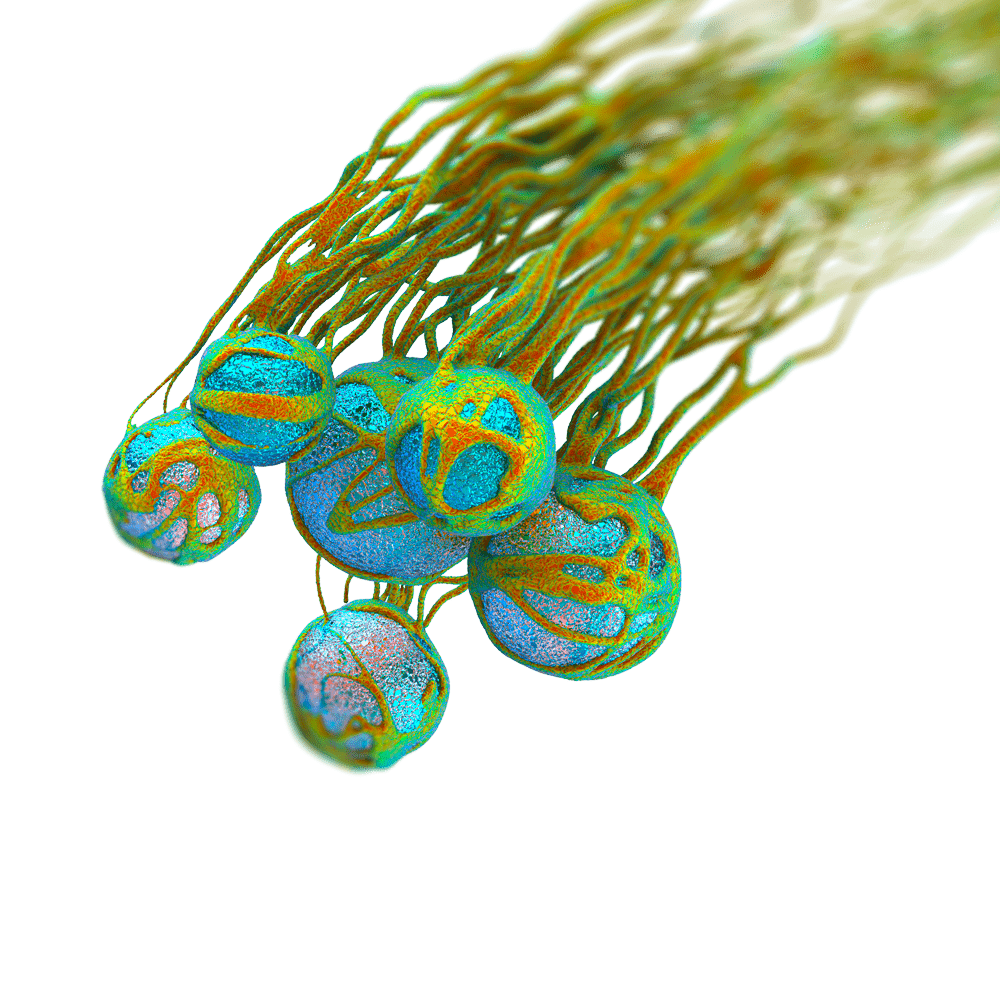
Strategic Product Development
Offering decades of strategic development experience, global compliance, and therapeutic expertise to ensure your promising therapy isn’t delayed by risk or limited resources.

Combining highly trained specialists and carefully refined processes with our world-class technology.

Industry leaders with comprehensive submission experience to strategically position your product.

Core Capabilities
Offering a strategic combination of industry acumen, global compliance, and therapeutic expertise to help ensure that your innovative ideas aren’t hindered by limited resources.
Our Expertise
We’re clinical development experts focused on helping today’s most innovative biotech and specialty pharma companies take their best ideas from benchtop to bedside.
therapeutic & special population expertise
Leading the way, next-generation car-t therapies: optimizing opportunities and operationalizing patient-centric oncology clinical trials, oct southern california, harnessing the power of clinical data with post-market clinical follow-up activities, tips for designing and conducting successful post-market interventional clinical investigations, optimized 505(b)(1) and 505(b)(2) clinical pharmacology programs to accelerate drug development, premier insights.
Customized services for each program, with tailored processes designed to meet highly specific needs. We’ve learned a lot about what works and what doesn’t. Browse the latest learnings and insights from our clinical development professionals.
Oncology & Hematology
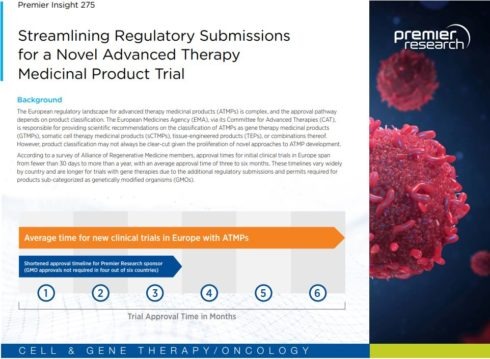
Cell & Gene Therapy
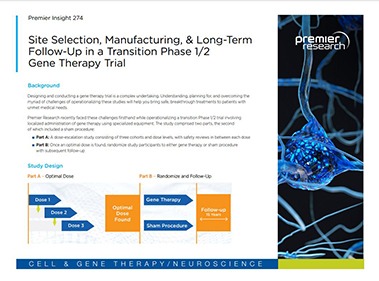
Connect with us
Ready to get started? So are we. Drop us a line to learn more about how we can help.
More From Forbes
Who's the best in drug research 22 companies ranked.
- Share to Facebook
- Share to Twitter
- Share to Linkedin
Billionaire hedge fund manager Bill Ackman is fundamentally wrong in the arguments that he is making in his efforts to force Botox-maker Allergan to sell itself to Valeant Pharmceuticals. Merck and Novartis, both regarded as paragons of R&D, are actually laggards. And Pfizer and AstraZeneca, far from sad sacks driven into each others arms by an inability to develop new drugs, are actually average.
Those are some of the surprising conclusions reached in a new ranking of the top 22 firms by R&D productivity created by Sector & Sovereign Health and its lead analyst, Richard Evans, a former Roche executive and longtime Wall Street analyst. The ranking is included below.
| 1 | Bristol-Myers Squibb | 1.5% | 0.22 | 1.2 | 1.9 | 23 | |
| 2 | Celgene | 32.3% | 0.23 | 1.5 | 8.4 | 98 | |
| 3 | Vertex | -125.4% | 0.81 | 2.4 | 4.2 | 53 | |
| 4 | Gilead | 20.8% | 0.16 | 1.1 | 6.4 | 185 | |
| 5 | Allergan | 8.0% | 0.46 | 1.4 | 8.1 | 96 | |
| 5 | Roche | 7.7% | 0.09 | 0.9 | 2.0 | 24 | |
| 7 | Amgen | 9.4% | 0.09 | 1.1 | 5.3 | 58 | |
| 8 | Johnson & Johnson | 8.2% | 0.07 | 1.0 | 4.8 | 34 | |
| 9 | Novo Nordisk | 17.5% | 0.11 | 1.7 | 10.8 | 439 | |
| 9 | AbbVie | 11.1% | 0.12 | 1.0 | 9.4 | 54 | |
| 9 | Pfizer | -3.2% | 0.11 | 0.9 | 2.5 | 24 | |
| 12 | AstraZeneca | 3.9% | 0.10 | 1.0 | 7.1 | 43 | |
| 12 | Biogen Idec | 9.1% | 0.13 | 1.1 | 13.1 | 155 | |
| 12 | Shire | 18.6% | 0.11 | 1.4 | 15.4 | 338 | |
| 15 | Sanofi | 1.5% | 0.09 | 0.9 | 4.2 | 28 | |
| 16 | Merck | 3.0% | 0.08 | 0.9 | 5.4 | 35 | |
| 17 | GlaxoSmithKline | 1.0% | 0.09 | 1.0 | 6.0 | 36 | |
| 18 | Novartis | 8.4% | 0.05 | 0.7 | 5.3 | 37 | |
| 19 | Regeneron | 8.3% | 0.16 | 0.7 | 13.7 | 638 | |
| 20 | Bayer | -2.1% | 0.07 | 0.9 | 10.3 | 82 | |
| 21 | Eli Lilly | 4.5% | 0.05 | 0.8 | 11.7 | 131 | |
| 22 | Alexion | 12.8% | 0.03 | 0.4 | 21.4 | 8,012 | |
The goal of the report, available for purchase at HiddenPipeline.com , is to start to provide metrics that companies can use to measure how well they are doing when it comes to inventing new drugs — and to get better. T0o often, Evans says, pharmaceutical executives instead use the industry’s low success rates as an argument that success is right around the corner. “A gambler that has lost everything he owned, just because he now has a strong hand doesn't make him a good gambler,” Evans says.
"This is a very rigorous report,” says Elliott Sigal, the former head of research and development at Bristol-Myers Squibb, the top-ranked company. “Nobody would argue: the general trend is that by many measures R&D productivity of the group is going down. Those of us trying to compete and do well in this space see a lot of value for being in the upper quartile. You used to do well if you were in the average."
The business of inventing, testing, and marketing new medicines is in a protracted crisis. The number of new drugs invented per billion dollars of research money spent has been halved every nine years going back decades, like a perverse reversal of the exponential improvement of microchips that keeps Silicon Valley constantly hopped up on its own grandeur.
But when it comes to fixing the R&D difficulties of any particular company, there is a huge problem: the business of inventing and testing drugs is so full of random chance that it is hard to measure how well a company is doing. Merck might launch no drugs one year and six the next because of luck, not because it got infinitely better in that short time. So how do you tell if a particular company is doing better or worse than average? How do you measure R&D productivity so that you can get better?
This is the problem Evans is trying to tackle in his ranking, which he detailed in a 128-page report that he shared with me, and that I have shared with several experts in drug company R&D. Based on discussions with them, I think Evans’ work provides a valuable new lens through which to view drug company research labs, although there’s a lot more work to do before we know how bankable his conclusions are.
Evans ranks firms based on five metrics:
- The economic returns of each company’s R&D spending — essentially, how does income now compare to R&D investment a decade ago?
- The number of patents filed by companies for every $1 million they spend on R&D; only patents before drugs hit the middle stages of trials count, because after that some companies file extra patents with an eye toward defending marketed products later.
- How often a company’s patents are cited by other patents or publications.
- A "leadership" index: is the company is leading or lagging in terms of the number of patents it files in particular diseases or types of chemist. Is it #1 or #11?
- And a ranking of internal bias: basically, how good is a company at avoiding “not-invented here syndrome.
“It’s a really good, solid, and thought-provoking piece of work,” writes Jack Scannell, a noted researcher on pharma R&D productivity, in an email. “I wish I had written it or something like it.” But Scannell notes that, except for the financial metrics, the new data have not been back-tested. “If such an analysis showed that measures did not present subsequent economic returns (or stock returns), then the measures would appear to be demonstrably useless and there would have been no point in writing a big report about them.”
Evans ignores one of the most common measures of research productivity, and one of my favorites: the number of new drugs, called new molecular entities or new biologic entities, approved by the Food and Drug Administration in a given year. Evans says these can be “grossly misleading” because they reflect “the sporadic nature of research.”
Bernard Munos, of the InnoThink Center for Research in Biomedical Innovation, worries that Evans may actually be understating the degree that R&D is a money-losing proposition for drug firms. One reason is that Evans doesn’t separate out R&D in pharma from that in other businesses, like medical devices or over-the-counter products, nor does he try to filter improvements in earnings from introducing new medicines from those that come from cutting costs or increasing drug prices. “The top 12 pharma companies spend $70 billion on R&D, but what comes from their pipelines doesn’t generate $70 billion or more in sales,” Munos writes. However, Evans' data do indicate that R&D prospects have continued to worsen, even as many executives argue they have turned a corner.
Bristol-Myers Squibb tops Evans’ ranking, as it does the rankings that I’ve published using Munos’ data and R&D figures. Celgene and Gilead are ranked #2 and #4, which is, again not a surprise: they’re the two most successful biotechnology companies of the past couple decades. Worth noting: Evans includes R&D costs from companies that are acquired, so Gilead gets credit for the hepatitis C drug, Sovaldi, which it bought, but which is having the most successful drug launch ever.
Vertex Pharmaceuticals of Cambridge, Mass., does surprisingly well. Evans points to it as a rare example of a company focusing in on a core competency — in this case, the science of understanding how drugs bind to receptors, and compares Vertex to the amazing numbers that were posted by Genentech when it was a standalone company.
One big surprise is the performance of #5-ranked Allergan, which is currently the subject of a hostile bid by Valeant Pharmaceuticals and its billionaire CEO Michael Pearson with some help from Ackman. Valeant’s model has been to buy companies that are wasting money on unproductive R&D and to cut costs to make them more profitable and return money to shareholders. If Allergan’s R&D is actually productive, this effort becomes value-destroying. “It's absolutely counter to Valeant's argument, no doubt,” says Evans.
Evans admits that for companies that have only launched one product, like Alexion or Regeneron, the analysis may not be valid. Munos also argues that AbbVie shines only because of its marketing of one new drug, Humira, not because of its ability to introduce new products, and that Lilly is dinged because of its losses in the U.S. insulin market, despite a better record of introducing new drugs.
Twenty years ago, Merck was viewed as the best drug research firm on the planet, a lot like Genentech. Novartis has recently achieved a similar reputation. But Evans says both are actually inefficient, because they follow a model of paying a lot of internal researchers, many of them in fields in which the company is not a leader, to work on a huge number of products. Over the course of its history, Evans says, Merck’s success has not been because it has had better ideas, but because it spends even more money when it finds one, like the cholesterol-lowering statin drugs.
“The reason they are so innovative is because they've taken a four-cylinder engine and put nitro in it,” he says. A more efficient model is the one adopted by Bristol under Sigal, which focused on bringing in products from the outside (Bristol’s breakthrough cancer drugs came from the purchase of Medarex) and using capital efficiently.
Evans has more work to do if he wants to make this ranking definitive; there are just too many ways to measure research productivity and they all give slightly different answers. But it’s a valuable contribution as we try to figure out the shape of the problem facing drug research and look for solutions.
Related On Forbes: The Biggest Drug Companies Of 2014
- Editorial Standards
- Reprints & Permissions
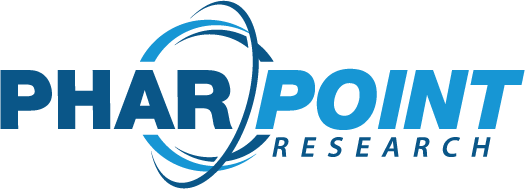
- Investigators
- Client Centric Approach
- Senior Leadership
- Explore All Services
- Clinical Operations & Project Management
- Site Feasibility & Study Start-Up
- Medical Monitoring
- Clinical Data Management
- Data Monitoring Committee (DMC) Services
- Biostatistics
- Medical Writing
- Clinical Trial Rescue
- Clinical Trial Consulting
- Explore All Resources
- Compare Industry Timelines
- View PharPoint’s Therapeutic Expertise
- Explore Success Stories
- Upcoming Events

Helping innovative clients meet their clinical trial goals
From pre-IND to approval, get attentive, experienced support from a consultative contract research organization (CRO).
Meet with our team

“There is an inherent honesty and authenticity in their approach , and as a result, I have complete faith and trust in PharPoint as our partner, and that gives me confidence in the success of our clinical program.”
— US General Manager, Biotechnology Client
“…High priority pivotal studies locked and delivered faster than any other CRO I have worked with in my experience. Not only was the study delivered within budget and early, it was a quality deliverable.”
— VP Clinical Operations, Pharmaceutical Client
Meet the contract research organization that your entire team will love working with.
Flexible, consultative clinical trial support THAT HELPS YOU CONDUCT HIGH QUALITY, COST-EFFECTIVE studies FASTER.
INCREASED Transparency
Transparency and good business ethics are at the heart of everything we do: from the proposal process to how we communicate on-going study progress.
EXPERIENCED TEAMS
The PharPoint team has supported 1,000+ clinical trials and aligns clients with study team members that have the right knowledge and expertise to meet study goals.
FASTER TIMELINES
With strategic early planning and collaboration, efficient study processes, and a seasoned study team, PharPoint helps sponsors meet rapid study timelines .

Receive tailored insight that complements your expertise.
Looking for a clinical consultant to help set your study up for success? PharPoint’s consulting services include pre-IND meeting support, strategic site identification, and enrollment predictions.

STUDY START-UP
Start enrolling faster with an expedited study start up.
Our team works diligently alongside other study partners and sites to get your study off the ground quickly. We leverage a tiered activation process to prioritize FPI. PharPoint is also a registered member of the Accelerated Clinical Trial Agreement (ACTA) and can expedite the contract negotiation process with other participating institutions.

STUDY CONDUCT
Keep your study on track and in compliance.
Enroll patients through partnerships with sites invested in study success, be confident in compliance with a team of experienced monitors and clinical leads, and overcome challenges as they arise with nimble support from clinical trial experts.

STUDY ANALYSIS
Get results one month faster than industry average.
Experience an expedited database lock, get topline results quickly, and feel prepared for next steps – whether that’s the next phase, a regulatory submission, or the next project.
EXPLORE OUR RESOURCES
We’re transparent, attentive, & consultative. But don’t just take our word for it.
“My experience working with PharPoint has been a pleasure. They have taken ownership of our clinical trial since day one. I truly feel that we work as one team.”
– Sr. Director, Clinical Operations (Biotech Client)
Explore case studies:
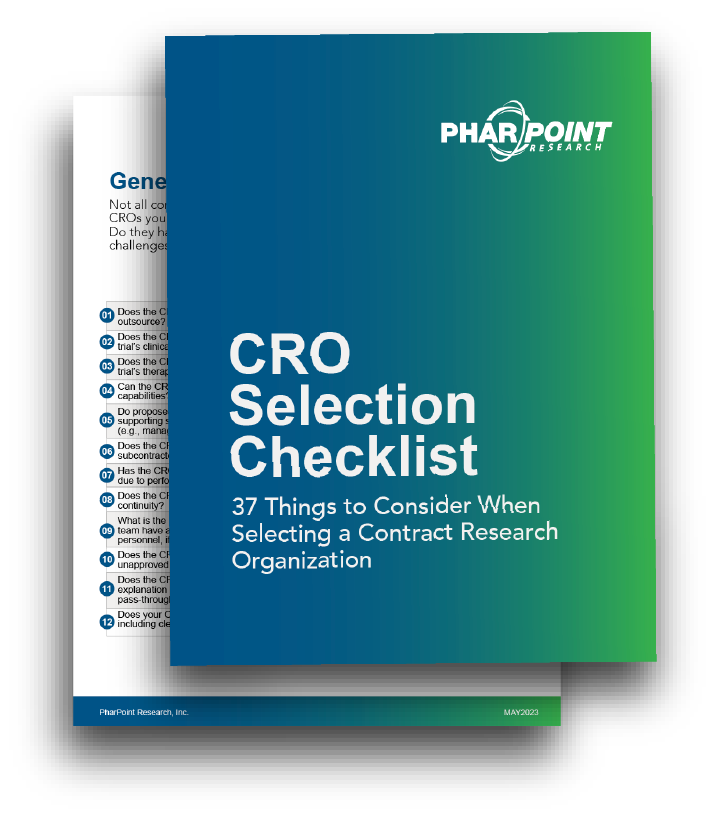
Interactive Checklist: 37 Considerations for Selecting a CRO
Trusted by 180+ companies like yours..
Learn more about PharPoint’s award-winning team & services.

Privacy Overview
- Guide to Clinical Trials Your participation makes a difference
- Clinical Trials in Children Designed to improve kids' health
- Data and Results Sharing our Results
- Integrity and Transparency Building Trust
- Diversity Equity and Representation
- Plain Language Study Results Trial Result Summaries
- Expanded Access & Compassionate Use Possible Treatment Options
- Find a Trial
- Rare Disease Smaller populations but big impact
- Internal Medicine Extending lifespans worldwide
- Inflammation & Immunology Treatment at the molecular level
- Vaccines Preventing the spread of infections
- Oncology The science of optimism
- Anti Infectives Combatting an evolving risk
- Gene Therapy Breakthroughs become treatments
- Medicinal Sciences The next generation of science
- Precision Medicine Developing tailored medicines
- Maternal Immunization Protecting newborns at the start
- mRNA Technology Unleashing the next wave of scientific innovations
- Diseases & Conditions
Coronavirus Resources
- Product Pipeline
- Research Sites
- Branded vs. Generic Learn the difference
- Biologics & Biosimilars Cures found in nature
- Commitment to Quality Maintaining the highest standards
- Global Supply Strategic manufacturing locations
- Manufacturing Sites Where medicine is made in the U.S.
- Health Literacy Learning to be well
- Treatment Choices Learning about treatment decisions
- Partnering With Patients Helping others by reporting side effects
- Tips for Patients Preventing medication errors
- Reporting Adverse Events
- Counterfeiting Preventing medication errors
- Product Safety
- Product List
- Product Contacts
- PfizerPro for Professionals
- Patient Assistance Programs
- Pfizer Distributors
- Announcements
- Behind the Science Features
- Press Releases
- Media Asset Library
- Updates and Statements
- Partnering News
- Media Contacts
- Executives Our senior-most leadership
- Board Members The people steering our company
- Scientists Our experts making discoveries
- Patient Stories Our patients
- Colleague Stories Our colleagues
- Ethics & Compliance Each of us is responsible
- Responsible Business Breakthroughs that change patients’ lives
- Patient Advocacy & Engagement Putting Patients First
- Global Impact Meeting urgent needs worldwide
- Diversity, Equity, and Inclusion Everyone has something to offer
- Environmental Sustainability Our responsiblity to the environment
- Human Rights Furthering dignity and worth
- Health & Safety
- Intellectual Property The benefits of fair competition
- EHS Governance
- Misinformation
- Grants Support for independent research
- Political Partnership Supporting like-minded organizations
- Working with Healthcare Professionals Collaboration to improve lives
- Prescription Value & Pricing How to lower patient costs
- Privacy Principles Commitment to personal data privacy
- Ready for Cures Improving Access to Medicines
- Transparency in Grants Committed to Disclosure
- Policy Positions
- Investors Overview Information for stockholders
- Why Invest Why to join us in our mission
- Events & Presentations Calendar of upcoming events
- Financial Reports Quarterly reports and more
- Investor News Announcements about our performance
- Stock Information Charts and data
- Shareholder Services Information on stock transactions
- Corporate Governance Overview Gaining insight into our performance
- Board Committees & Charters Defining the corporate structure
- The Pfizer Board Policies Ensuring ethical leadership
- Corporate Governance FAQs Learn more about our approach
- Contact Our Directors Email any of our Directors
- Research and Business Development Partnerships
- Venture Investments
- Business to Business
- Pfizer CentreOne
- Pfizer Ignite
- Submit Your Opportunities
Introducing PfizerForAll
Introducing pfizerforall ™.
Looking for an easier way to find care options, talk to a doctor, or book vaccines? Pfizer has your back, with answers and care all in one new website.
Learn more about PfizerForAll
Simplifying How You Access Healthcare
We’re happy to introduce our new, user-friendly platform, PfizerForAll.com, where the millions of Americans with illnesses like migraine, COVID-19 and flu can receive end-to-end services and support all in one place.
Annual Review
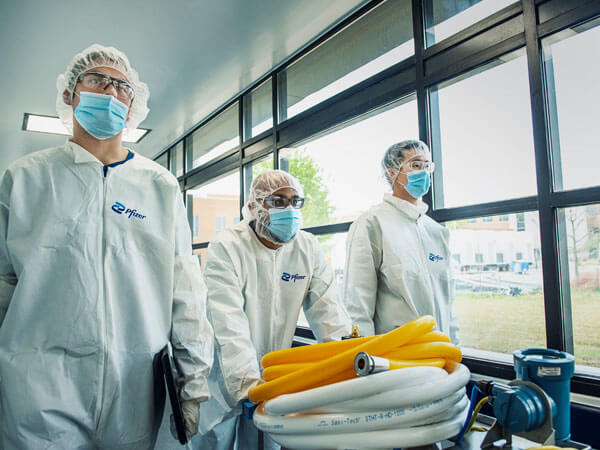
Reflecting on a Year of Breakthroughs
Every year, we leverage the power of our innovative science and passionate people to leave a positive impact on the world. Our new Annual Review sheds light on how we did in 2023.
Impact Report

Our Commitment to Responsible Business
Pfizer prioritizes the health and well-being of people and the planet to deliver breakthroughs around the world in a responsible way.
Behind the Science Feature
"Here's to Science" - Watch Our Big Game Ad
Celebrating 175 years of breakthroughs—and we’re just getting started. Meet some of the scientists from our film.
175th Anniversary

Kicking Off Pfizer's 175th Anniversary Celebration
Pfizer has been in the business of breakthroughs for almost two centuries, and in 2024 we'll be celebrating our 175th anniversary by looking back - and forging ahead.
Latest Articles
A new road to migraine relief.

Global Health Fellows: Partnering to Strengthen Health Systems

Clinical Trial Innovation: Putting the Patient First in Clinical Trial Design

Change the Odds: Uniting to Improve Cancer Outcomes
At Pfizer, we believe that everyone should have the same opportunity to access the latest advances in cancer care, regardless of their background or where they live. That’s why we’re proud to partner with the American Cancer Society on “Change the Odds: Uniting to Improve Cancer Outcomes,” a three-year initiative to bridge the gap in cancer care disparities.
Our Purpose

Pfizer Sets New Ambition: Changing a Billion Lives a Year by 2027
An evolution of the previous Purpose Blueprint, implemented in 2019, the Purpose Blueprint 2.0 consists of five “Core Business Principles” and 15 Big Ideas that will drive us in the years to come.
Closing the Health Equity Gap
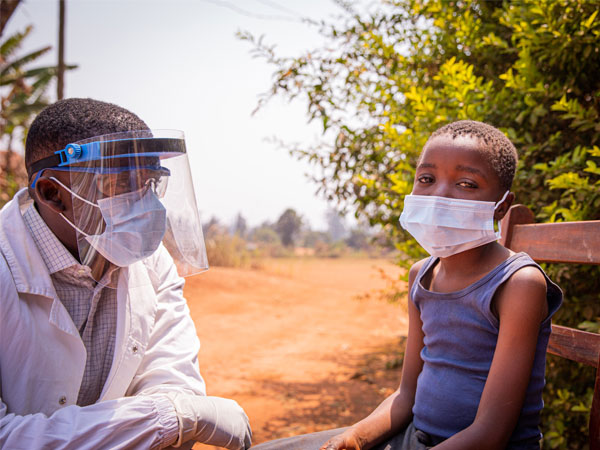
An Accord for a Healthier World
Where people live shouldn’t impact the quality of their healthcare and income shouldn’t determine health outcomes.
While we continue to see the devastating impact of the coronavirus pandemic around the world, we’re committed to helping keep people safe and informed.

A Multi-Pronged Approach to COVID-19
Explore how vaccinations and treatment with oral medication for those eligible are working to combat COVID-19.

Making & Distributing Our Vaccine
Pfizer consistently and diligently monitors the supply of our medicines.
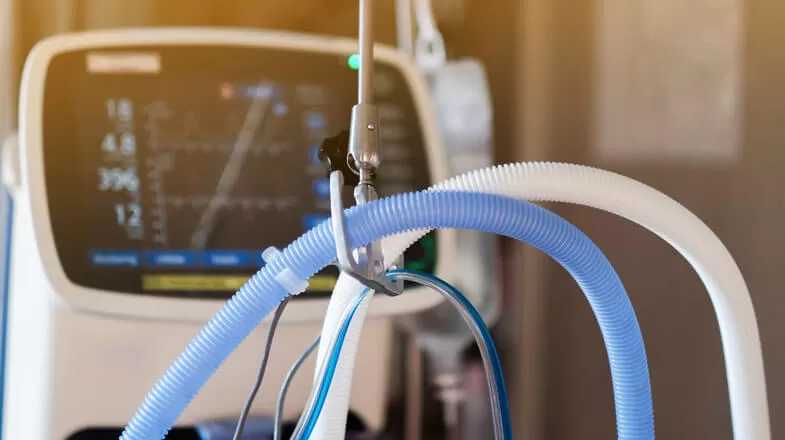
Severe COVID & High Risk Populations
What is severe COVID-19? Learn about severe COVID-19 and its symptoms and risk factors Resources and answers to frequently asked questions.

Recursos para Hispanohablantes (Resources for Spanish-Speakers)
El Dr. Santiago López informa en temas relacionados a la atención médica tales como vacunas, noticias falsas, y ensayos clínicos.
Biotechnology is our foundation. Benefiting patients is our goal. Innovation, pharmaceutical development, and the most dedicated team of clinical researchers is how we do it.

Conquering Cancer

Inflammation & Immunology
Innovation, Research & Development

Driven to Discover the Cure

Rare Disease
Our Approach to Gene Therapy and More

Internal Medicine
Advancing the Fight

Anti Infectives
New Drugs, Medicines & Therapies
Every product is the result of 1,500 scientists overseeing more than 500,000 lab tests and over 36 clinical trials before the first prescription. .

Pfizer RxPathways connects eligible patients to a range of assistance programs that offer insurance support, co-pay help, and medicines for free or at a savings.
Starting with charles pfizer inventing an almond-flavored antiparasite medicine in 1849, our people have always been innovators and trailblazers, committed to finding the next cure. , how drugs are made, the medicines available today have taken an average of 12 years to develop. with dedication, creativity, and science, we can significantly cut that time., areas of focus.

Revolutionary medicines enable us to enrich and extend life for people suffering from all types of diseases.
The pfizer store.

Show Your Pfizer Pride!
Shop and share the collection.
All profits from The Pfizer Store will be donated to charity.
Subscriptions
Sign up for communications from pfizer.
Receive the latest news from Pfizer in our monthly The Breakthrough newsletter and email alerts on a variety of topics.

Innovations Inspired by life

Sun Pharma Advanced Research Company Limited (SPARC) is a clinical-stage biopharmaceutical company that focuses on developing innovative therapeutics to improve standards of care for patients worldwide. At SPARC, our therapeutic focus is in the area of oncology, neurology and immunology, three critical fields that pose significant challenges in healthcare.
Therapeutic Focus

We pioneer precision medicines and targeted delivery to overcome treatment resistance and achieve lasting remission.

We explore new pathways to address the root causes of neurodegeneration, altering disease progression and enhancing patients' quality of life.
R&D Pipeline
Asset / program.
Preclinical
Vodobatinib (SCC-138)
c-ABL Inhibitor
Vodobatinib (SCO-088)
BCR-ABL Inhibitor
Anti-muc-1 adc.
Vibozilimod (SCD-044)
Selective S1PR1 Agonist
Undisclosed.
Emerging from disruption: The future of pharma operations strategy
In the past, many pharmaceutical companies (pharmacos) deprioritized operations strategy in the face of competing business pressures. This is now changing. Factors such as the COVID-19 pandemic, inflation, geopolitics, new therapeutic modalities, and new ways of working make it vital for pharmacos to carefully reconsider their long-term choices in sourcing, manufacturing, and supply chain.
Now is exactly the right time for this renewed emphasis on operations strategy, as pharmacos emerge from two years of intense firefighting. Succeeding in pharma under these new and challenging conditions will require succeeding in operations.
The focus for operational leaders may need to shift from the prevailing emphasis on continuous improvement—including cost savings, quality assurance, and constant readiness to deliver—to longer-term external challenges. These include high inflation and an increase in complexity and risk, as well as the compounding effects these forces have on each other.
Pharma operations leaders now have an opportunity to deliver even greater value to their organizations by achieving this shift in focus, but they must act quickly to keep abreast of the challenges confronting the industry. The effort will require enormous mobilization and thoughtful prioritization. This task will fall to leadership; only the CEO and head of operations are in the right positions to make it happen.
This article explores the challenges facing pharma leaders and the steps they can take to develop a more strategic, long-term, and integrated approach to operations strategy. It presents questions leaders can ask as they design the solutions needed to make sure operations can protect enterprise continuity while still delivering to patients.
A perfect storm of external challenges
The pharma industry is facing a multitude of challenging trends (Exhibit 1). Global demand is growing rapidly, and the unprecedented need for COVID-19 vaccines and therapeutics has put additional pressure on the industry. The industry’s ability to find innovative solutions to deliver COVID-19 vaccines while still meeting overall demand is a remarkable achievement, but rising global demand is still a significant challenge for the industry in the long term.
The product landscape also is changing swiftly. New modalities, such as cell and gene therapy and mRNA vaccine technology, have increased from 11 to 21 percent of the drug development pipeline—the fastest growth ever seen in the sector. This change is likely to bring more fragmentation of technology, new supply chains, and unique product life cycles.
In addition to these industry-specific trends, pharma has also been affected by broader global trends, such as supply chain pressures. While the pharma industry is considered somewhat protected by its high inventory levels and long-standing dual sourcing, over a given ten-year period, the likelihood of supply chain disruptions still represents a potential loss of 25 percent of EBITA . Inflation has risen in recent months to levels not seen for decades, leading to increasing costs for labor, raw materials, and transportation. This is over and above the persistent price pressures pharma is already facing, particularly in generics. Since pharma customers are not expected to fully absorb these cost increases, profit margins are under pressure.
Meanwhile, increased state interventions and protectionist trade policies are creating new pressures on manufacturing networks and could drive increased regionalization. This would be a capital-intensive exercise: to regionalize just 10 percent of current vaccine trade in one particular geographical region, governments would need to invest an estimated $100 million.
Would you like to learn more about our Operations Practice ?
The pharma industry is also facing talent shortages linked to wider labor market trends, including the 20 percent increase in demand for STEM-related roles across the life sciences industry in the United States. The current pool of pharma digital talent is at least 14 percent lower than demand, and many companies are finding it challenging to recruit technical talent. Compounding this challenge is the rise of remote working, which has increased employee expectations for flexibility. In response, nearly all pharmacos are experimenting with hybrid working models.
A few major trends point to an industry tailwind; one of them is the advancement of digital and analytics tools. Digital tools, robots, and sensors are becoming cheaper and easier to access, and they can be used to capture all manner of raw data. In addition, edge computing and cloud analytics are providing real-time optimization and transparency. Pharmacos are working to leverage the power of data to become more agile and resilient. However, to date, no pharmaco has emerged as a true global leader in this field.
The pharma industry is facing a multitude of industry-specific and global trends. But a few major trends point to an industry tailwind; one of them is the advancement of digital and analytics tools.
Each of these global trends represents significant challenges in and of itself, and the trends may be compounded and strengthened through their interactions. This compounding effect can add to the complexity of evaluating an effective strategic response.
Major implications for pharma
These global trends have six major implications for pharmacos: rising operational complexity, increasing risk, shifting capability requirements, higher capital expenditure requirements, variable-cost increases, and opportunities for savings (Exhibit 2).
Operations leaders may need to become comfortable navigating a more complex ecosystem as they respond to increased operational complexity. Risks may increase due to rising environmental, social, and governance (ESG) expectations and skills gaps, while new modalities and digital acceleration will also likely lead to a shift in capability requirements. This could necessitate reskilling and upskilling of staff, as well as a renewed focus on recruiting from outside of the pharma industry.
From a cost perspective, the pharma industry may see significantly increased capital expenditure requirements related to the construction of new sites and new digital infrastructure. Increases are also likely in variable costs in areas such as raw materials, transportation, and employee attrition, reskilling, and salaries.
Future of pharma operations
Pharma companies are experiencing a wave of innovations – from new treatment modalities, to smart machines, advanced analytics, and digital connectivity.
Although these implications are challenging, they may represent possible opportunities for savings in several areas. For example, ESG commitments on waste reduction could reduce costs, as could successful digital implementation. However, the challenge lies in monetizing these cost savings, given that the industry has long created value largely through revenue expansion rather than through cost savings.
Rising to the challenge: Actions to deliver value
To respond to these challenges, pharmaco leaders may now need to emphasize the importance of their operations strategy. They should consider taking a longer-term view and scaling activity across four key themes: network strategy and resilience, digital, operating model, and talent.
Expand focus on longer-term, transformative solutions
Operations leaders can address these challenges through several short-term and long-term responses. For example, problems associated with a more unpredictable supply chain could be addressed with a short-term approach of increasing inventory or a long-term initiative to establish an end-to-end supply chain digital nerve center.
Short-term levers can be an important part of the total response but are insufficient to fully mitigate the challenges facing the industry. To respond effectively, companies may need to accelerate new ways of working and embrace long-term thinking. This will require concrete action with a focus on making sure that strategies are put in place to weather the long-term headwinds the industry is facing.
Accelerate and scale responses across four strategic domains
To identify the actions that pharmacos could take, it may help to group these in terms of four strategic domains: network and resilience, digital strategy, operating model and ecosystem, and talent strategy (Exhibit 3). While these themes are likely to be familiar to any business leader, they now require a substantial shift in mindset. Acting on them also calls for a large investment of resources.
- Plan for and manage future resilience and reliability needs . Recent supply chain disruptions have pushed supply chain resilience up corporate agendas. Companies have been forced into reactive modes that employ short-term levers like building inventory. However, companies could better position themselves by solving multiple variables and building resilience into their operations strategy through longer-term actions like network design and dual sourcing.
- Scale end-to-end adoption of digital and automation . Digital has proven itself highly valuable to pharma operations. However, many companies struggle to move from targeted, single use cases to a fully scaled suite of solutions. And while the adoption of full-scale digital solutions can require heavy investment—around $50 million to $100 million per year for two to three years—the rewards can include significant cost savings, improved quality, and increased resilience, as well as greater employee effectiveness. Companies that truly scale and implement digital can better protect themselves from the pressures of the forces increasing costs for the industry. More and more companies are moving toward network-wide and end-to-end digitization; to date, the World Economic Forum has recognized 103 as “lighthouses,” based on their advanced application of digital technologies . Johnson & Johnson, for example, has successfully launched multiple Industry 4.0 lighthouses, including some focused on end-to-end patient connectivity and order fulfillment.
- Expand adoption of end-to-end partner ecosystems . Companies could also consider changing their operating model from a traditional hub configuration around originators to an end-to-end ecosystem of true strategic partners. More than 50 percent of companies already expect to intensify their collaboration models with other industry players through, for example, service agreements, joint ventures, or ecosystems. Some are already in motion; examples include Pfizer and BioNTech, which have already established a strategic partnership in mRNA technology discovery, and AstraZeneca and Huma, which are collaborating to scale innovation for digital health. These partnerships are indicative of increasing collaborations throughout the industry across functions.
Automation, centralization, and new job requirements may affect nearly 90 percent of today’s workforce, and to deal with this challenge, companies could adopt effective long-term strategies. Retaining talent is challenging in the present environment, with the share of workers planning to leave their jobs in the next three to six months standing at 40 percent since 2021 . 1 Aaron De Smet, Bonnie Dowling, Bryan Hancock, and Bill Schaninger, “ The Great Attrition is making hiring harder. Are you searching the right talent pool? ” July 13, 2022. Strategies for talent retention should therefore be broad and focus on more than just salary.
A viable long-term solution to talent shortages may need to involve more than increasing wages to attract people. To solve structural talent gaps, companies could ensure long-term reskilling and upskilling of the existing workforce. For example, Roche runs an operations rotational program to attract top talent with bachelor’s and master’s degrees, and early in the COVID-19 pandemic, Novartis launched a “choice with responsibility” policy to improve overall employee experience.
Successfully developing a robust operations strategy is complex and requires dedicated resources with the ability to focus on the medium to long term. This means the C-suite will need to prioritize efforts and provide adequate resourcing. Only the CEO and head of operations can set the appropriate direction for their organization, steer their company’s effort, gather the right skills and teams, and manage complex interdependencies and resource-intensive interventions.
Are companies doing enough?
As COOs look to emerge from the disruption of the past two years, reflecting on several questions could help them evaluate their organizations’ level of preparedness to respond to the trends affecting the industry. The process could provide foundational answers to inform a renewed operations strategy.
- Have you projected the impact of today’s current trends on your business?
- Do you have a focused, skilled, and scaled operations strategy team that identifies, prioritizes, and deploys initiatives across different horizons?
- Are your resilience measures proactive and dynamic, and are they being built on talent and digital capabilities to achieve greater agility and reliability?
- Have you experienced greater access to innovation and flexibility as a result of expanding your services and strategic partnerships?
- Has your digital strategy created benefits across your network and transformed your operation from digitally enabled to digitally driven?
- Have you achieved ESG improvements, and do you have a broad, long-term road map for ESG commitments (beyond net zero)?
- Has your operating model been agile enough to adapt to rapidly changing operations requirements, such as new modalities and potential disruptions?
- Have you successfully transformed your operations workforce and comprehensively improved the employee experience?
- Do you have an established governance process that incorporates past lessons into future strategy?
Although the pharma industry has performed a remarkable feat in delivering COVID-19 vaccines while also meeting growing demand, current trends create a challenging environment for pharmaceutical companies. Companies face greater costs, complexity, and risk.
Now is the time to rethink operational strategy to respond to these trends and remain competitive. Such change may have associated challenges and will require bold and innovative leadership. But if companies successfully implement new strategies, they could position themselves to take advantage of the industry’s remarkable growth.
Hillary Dukart is an associate partner in McKinsey’s Denver office, Laurie Lanoue is a partner in the Montreal office, Mariel Rezende is a consultant in the Miami office, and Paul Rutten is a partner in the Amsterdam office.
The authors wish to thank Joe Hughes and Jean-Baptiste Pelletier for their contributions to this article.
Explore a career with us
Related articles.

Against the odds: How life sciences companies excel in large transformations

Four ways to make sure your pharma manufacturing strategy delivers value

Operations can launch the next blockbuster in pharma
An official website of the United States government
The .gov means it’s official. Federal government websites often end in .gov or .mil. Before sharing sensitive information, make sure you’re on a federal government site.
The site is secure. The https:// ensures that you are connecting to the official website and that any information you provide is encrypted and transmitted securely.
- Publications
- Account settings
Preview improvements coming to the PMC website in October 2024. Learn More or Try it out now .
- Advanced Search
- Journal List
- Springer Nature - PMC COVID-19 Collection

Location of the Largest Pharmaceutical Companies in Russia: Contribution to Regional Divergence or Convergence?
O. v. kuznetsova.
1 Plekhanov Russian University of Economics, 115093 Moscow, Russia
2 Federal Research Center “Computer Science and Control,” Russian Academy of Sciences, 119333 Moscow, Russia
R. O. Bobrovsky
3 Moscow State University, 119991 Moscow, Russia
Abstract—
The objective of the article is to identify factors for the location of pharmaceutical enterprises in Russian regions, including from the viewpoint of assessing the possible contribution of the pharmaceutical industry to the reduction of territorial disproportions in the level of economic development. The pharmaceutical production location factors is analyzed based on a generalization of foreign studies on the topic and a database compiled by the authors on the manufacturing enterprises of more than 50 largest pharmaceutical companies in Russia (taking into account the construction time and large-scale modernization of enterprises belonging to Russian or foreign owners). It is concluded that Russia experiences the same factors of pharmaceutical enterprises’ location as abroad: the importance of historically established centers of production is characteristic, including in the eastern regions of the country (due to the reduced role of the transport factor for the industry); preference is often given to expanding capacities of already existing enterprises, instead of construction of new ones; new factories appear on the basis of established pharmaceutical research centers and/or with focus on markets of the largest urban agglomerations and/or in special economic zones and industrial parks. When building new enterprises, investors can seek both to participate in pharmaceutical clusters and save on production costs, including wages, by building factories in areas not saturated in industries. Foreign investment mainly reach only to the western regions of the country due to their capacious sales market and proximity to the countries of origin of companies, which are predominantly European. As a result of numerous factors, the impact of development of pharmaceutical production on territorial disproportions is ambiguous.
FORMULATION OF THE PROBLEM
In recent years, federal authorities have paid increasing attention to the development of the pharmaceutical industry 1 in Russia. Of course, the COVID-19 pandemic that began in 2020 largely contributed to this. However, interest in the industry is due no less to the introduction of anti-Russian sanctions, first in 2014, then in 2022, which contributed to the state’s launch of corresponding import substitution programs and measures to support production in Russian regions. 2 The pharmaceutical industry is associated with the production of vital goods; therefore, the presence in the country of its own medicine production is inevitably considered one of the most important elements of its economic security. As a result, the pharmaceutical industry significantly outperformed other manufacturing in terms of development dynamics not only in 2020, but also in pre-COVID 2019 (production indices amounted to 127.4% in 2019 and 123.2% in 2020). In 2021, the growth rates in the industry remained high (although not maximum): 111.5% versus 105.0% for manufacturing in general. Pharmaceutical production in Russian regions very rarely becomes an object of geographical research, in our opinion, also because of its retained low share in the manufacturing: even in 2020, it was only 1.97% (in volume of shipped goods of own production). There are exceptions among regions, although small in number: in Kursk and Kurgan oblasts, about 14–15%; in Vladimir oblast, more than 9%; in Moscow, Yaroslavl, Ryazan, and Kirov oblasts, 6–7% each; in other federal subjects, less than 5%. More than a quarter of regions have no pharmaceutical industry at all.
Nevertheless, due to the importance of the pharmaceutical industry and dynamism of its development, the issues of patterns and location factors deserve attention. As part of the study, we focus on the pharmaceutical production location factors, since their understanding is important for developing state spatial development policy.
On the one hand, it can be assumed that, due to the science-intensive nature of the pharmaceutical industry, its location will gravitate toward already established scientific centers, which are most often in economically developed regions, an additional advantage of which is a capacious sales market. In this case, further development of the pharmaceutical industry in the country will contribute to the growth of territorial disproportions in economic development level. On the other hand, for pharmaceutical production as small-scale, the role of transport costs should be reduced, which means the possibility of pharmaceutical enterprises’ location in regions remote from the main sales markets, which, as a rule, lag behind in the level and dynamics of their economic development. This can be used to solve the problem of reducing territorial disproportions, since, as has already been shown, in some regions, in particular, small ones, large pharmaceutical enterprises can make a significant contribution to industrial production.
A combination of these two oppositely directed trends (for different types of industries), as well as the effect of other factors in the location of pharmaceutical enterprises, is not excluded. The objective of this article is to test these hypotheses and to identify factors for the location of pharmaceutical enterprises in Russian regions. For this, we analyze the features of location of production facilities of the largest pharmaceutical companies in Russia that had been developed at the end of 2020. In determining the composition of factors affecting the location of pharmaceutical enterprises, we rely on foreign studies on the geography of the industry within individual countries.
REVIEW OF PREVIOUS STUDIES
Due to the importance of the pharmaceutical industry, a considerable number of publications by economists are devoted to it. The object of research is more often the Russian pharmaceutical market than the pharmaceutical industry. The latter is interesting to the authors from the aspect of domestic producers on the market; state support for the industry is often analyzed, but almost no attention is paid to analyzing the location of enterprises in Russian regions.
According to the pharmaceutical research company GSM Group , in 2020, in the structure of drug consumption in Russia, the share of domestic drugs was 33.5% in terms of rubles (in value terms) and 63.1% in terms of packages. Another 10.1% in rubles and 5.5% in packages are represented by imported drugs, the production of which is localized in Russia. 3 Thus, in total, in Russia in 2020, 43.6% of drugs consumed in the country were produced in rubles and 68.6% in packages (this ratio reflects differences in the cost of domestic and imported drugs).
The experience of geographic research of the industry available in Russia is mainly related to the geography of the global pharmaceutical industry; in the 2010s at the Faculty of Geography, Moscow State University, two such candidate theses were defended (Krotkov, 2013; Podgornev, 2015). These, as well as in related studies on the global economy (Mamed’yarov, 2018; Ovcharov, 2005), analyzed differences between countries in the development of the pharmaceutical industry; the main object of research, due to the high degree of globalization of the industry, are transnational corporations (TNC). In (Podgornev, 2015), areas and centers of the pharmaceutical industry are identified; however, it was not the task of the author to explain the distribution patterns of industry enterprises within individual countries. Russia is not given any significant attention in these works due to its low role in the global pharmaceutical industry. Similar works exist abroad: on the geography of the global pharmaceutical industry (Daemmrich, 2009), on regional strategies of TNC, but also more often in a country context (an interesting example is the work on India, which occupies a special place in the global pharmaceutical industry (Yeoh, 2011)).
In Russia, some exceptions to the general rule are studies on pharmaceutical clusters (Aleksandrova et al., 2019; Bogachev and Rodionova, 2014); however, it seems due more to the prevailing interest in clusters and cluster policy in general in the country than to the pharmaceutical industry as such. There is also an important study from the viewpoint of our research on the development of the pharmaceutical industry in Russia until the early 2000s (Rodionova and Ovcharov, 2001), which gives an idea of the geography of the industry that had developed by that time. However, as is well known, active implementation of investment projects in various industries began in Russia precisely in the 2000s, and over the past 20 years, the geography of the pharmaceutical industry, of course, has undergone significant changes.
Abroad, there are few studies devoted to the location of pharmaceutical enterprises within individual countries (rather than global economic studies), but there are still examples of studies on the patterns and factors of the industry location in different types of countries in terms of the development of the pharmaceutical industry: in the traditional leaders among economically developed countries—USA, Germany, and several other European countries (Bignami et al., 2020; Boasson et al., 2005; Demirel and Mazzucato, 2010; Furman, 2003; Janne, 2002); in Ireland, which is characterized by rapid development of innovation (Van Egeraat and Curran, 2013); and in China, which has attracted a significant amount of foreign investment in recent decades and has significantly increased its role in the global economy (Li et al., 2017).
Summarizing these studies, we can say that there are no strict requirements for the location factors of pharmaceutical plants. Pharmaceutical production is small-tonnage; therefore, they need not be bound to raw materials sources or consumers, nor does it require large amounts of fuel or energy (although stable power supply is important). Nevertheless, companies strive to reduce costs: for product delivery to consumers, energy costs for ensuring the required temperature and humidity conditions for production, etc. In addition, for pharmaceutical companies, the availability of clean water is often critical. Pharmaceutical production itself is neither capital- nor labor-intensive (the number of employees in factories is small, and an increased level of qualification of workers is not always needed).
Given the relatively free location of pharmaceutical enterprises, the choice of locations by investors is quite sensitive to state economic policy measures, and in different types of countries. In Ireland, e.g., development of pharmaceutical centers was driven by spatial planning policy, which created industrial sites and infrastructure needed for investors (Van Egeraat and Curran, 2013). In China, the placement of foreign direct investment in the pharmaceutical industry was determined by the absence of strict environmental requirements at the provincial level and, conversely, by the presence of preferential treatment for investors (special economic zones or their counterparts); the shift in state spatial policy from supporting eastern coastal regions to supporting deep provinces led to corresponding shifts in the location of pharmaceutical enterprises (Li et al., 2017). Case studies of the same two countries show that concentration of pharmaceutical enterprises is not necessary: investors are prepared to or already do locate their production in population centers where the pharmaceutical industry had not been previously developed: either in cities where there are good industrial sites with infrastructure (Ireland), or in regions unsaturated in enterprises, where costs are lower and there are more free workers (China (Li et al., 2017)).
In addition, studies in economically developed countries where the pharmaceutical industry originated show that the location of the industry is highly concentrated; pharmaceutical clusters are a typical form of territorial organization of production (Demirel and Mazzucato, 2010; Kaiser, 2003; Podgornev, 2015). Moreover, a case study of US publicly traded pharmaceutical companies demonstrated that inclusion of such companies in clusters is one of the factors that increase their value (Boasson et al., 2005).
The most important feature of pharmaceutical industry is its high research intensity. Therefore, the modern scientific literature analyzes not so much the geography of pharmaceutical production as the geography of R&D and innovation therein. The science intensity of the pharmaceutical industry entails a number of features of the industry:
—the already mentioned key role in the global production of TNC, since only very large companies have sufficient resources for many years of expensive R&D, as well as for the increased costs of promoting products inherent in the pharmaceutical industry;
—the continuing importance of traditional centers of production that appeared at the stage of emergence of the pharmaceutical industry itself in economically developed countries. The pharmaceutical industry appeared either in the work places of pharmaceutical scientists or on the basis of the chemical industry (Daemmrich, 2009; Podgornev, 2015). In modern conditions, economically developed countries are distinguished by the best conditions for the development of high-tech and innovative activity. Such countries are characterized by the presence of companies producing original drugs, while in less developed countries, generic products are more represented.
From the viewpoint of geography, it is important that all the abovesaid on the location of pharmaceutical enterprises pertains directly to pharmaceutical production, while the location of research units of large pharmaceutical companies or small innovative firms has a completely different logic; certain properties of the territory are important for them. Thus, scientific studies show that innovative pharmaceutical companies are characterized by the fact that their specialization depends on the scientific base available in the region (Furman, 2003); the level of development of R&D in the region (both in universities and industry as a whole) positively affects the value of companies (Boasson et al., 2005). In other words, it is possible to establish drug production in a region without the presence of not only any special location factors, but also a research base, while the latter is extremely important for new products.
However, even in terms of the relationship between the level of development of scientific research in a region and location of innovative activity in the pharmaceutical industry, the situation is not so unambiguous. Recent paper (Bignami et al., 2020) analyzes differences in the importance of geographic proximity for the organization of R&D cooperation in the pharmaceutical industry, depending on types of knowledge. It is shown that geographic proximity is much more important for cooperation in basic research than for clinical science. The former is associated with the transfer of implicit knowledge (which requires direct communication of people), while knowledge in clinical science takes place within a highly regulated process that is carefully documented (and such systematized knowledge is easier to transfer with remote collaboration). In addition, the geographical proximity of research centers engaged in basic science and companies allows the latter, if necessary, to involve highly qualified scientists in their work. There is also a tendency to locate clinical trials far from the research centers of pharmaceutical companies, in countries where it is possible to reduce the costs of such trials.
Special attention is paid to how the coming of TNC to a region affects the local development of technologies and innovations. It is shown that this contribution depends on the characteristics of the region, even within economically developed countries. For leading economic centers, external investment complementing domestic investment can create additional opportunities to modernized and expand the local knowledge base. For less developed centers, foreign TNC can be both positive (strengthening regional centers of excellence) and negative, as local firms may not be able to compete with large TNC (Janne, 2002).
Thus, foreign experience suggests that in Russia, the location of enterprises can be explained by various factors and carried out in different regions: both in the largest urban agglomerations (due to their high scientific potential and capacious market), and in economically underdeveloped ones, where costs of production are lower. The possible significance of pharmaceutical clusters is also ambiguous (new enterprises can be located in such clusters, but they can also be located outside them, focusing on other advantages of the territories). It is quite logical to assume the preservation of the importance of the traditional, established in the Soviet period, pharmaceutical centers. It is also important to pay attention to the role of special economic zones and their counterparts in development of the industry.
MATERIALS AND METHODS
The basis of our research is our database of enterprises of the largest pharmaceutical companies in Russia. It was necessary to thus limit the study in order to obtain more accurate and detailed information on enterprises: on their websites, companies clearly indicate which units are production (rather than marketing) and where they are located, when the plants were built (purchased, modernized); clarifications are often given for the reasons for choosing a production site (in the territory of a special economic zone, near or on the basis of a specialized research institute, etc.) or the adjacency of new projects with existing enterprises of companies is visible.
The well-known ratings of the largest Russian companies (for example, Expert, RBC) include single manufacturing pharmaceutical companies (not those selling medicines), and then only in the recent hundreds. Therefore, specialized ratings of pharmaceutical companies are needed. We know of two such ratings that have appeared in recent years. One is the rating of the 50 largest pharmaceutical companies in Russia, published in the electronic journal Healthcare in Russia in December 2018, 4 compiled according to company revenue in 2017. The second is Forbes’ ranking of the top 20 pharmaceutical companies, published in September 2020, 5 based on five criteria: 2019 revenue, year-over-year revenue change, net profit, the number of medicines registered for the company, and the number of clinical trial approvals issued to the company; at the same time, the rating included companies controlled by individuals (more than 50%) and not included in global conglomerates. The lists of companies included in these ratings largely coincide, but not completely: there are 56 companies in the only two ratings considered.
We took into account whether the companies have Russian or foreign owners, since they can be distinguished by the presence of different territorial development strategies. Most of the 56 companies have Russian owners (although formally companies can be registered offshore); there are three state-owned companies, but there are also foreign investors: German STADA , Martin Bauer , B. Braun Melsungen ; Italian Menarini (its German division Berlin-Chemie ); Swiss AVVA ; French Servier ; Hungarian Gedeon Richter ; Slovenian KRKA ; American Abbott ; and Indian Sun Pharmaceutical . Along with foreign companies included in the list of the largest, also well know are projects by Swiss Novartis , French Sanofi , British AstraZeneka , Israeli Teva , and Japanese Takeda . The draft Strategy for the Development of the Pharmaceutical Industry in Russia up to 2030, published in mid-2018, presented a list of projects for the construction of pharmaceutical enterprises implemented in the country for 2001–2015 (there are 36 of them); we also take them into account as the most significant (but basically the projects were implemented just by the largest pharmaceutical companies in Russia; the strategy itself was not approved at the time of writing this article).
The country affiliation of foreign pharmaceutical companies that set up in Russia generally corresponds to the overall situation with legitimate (nonoffshore) foreign direct investment in Russia: European companies, especially German ones, predominate, while the United States, one of the leaders in the global pharmaceutical industry, is poorly represented in Russia. The difference between the pharmaceutical industry and a number of other industries (e.g., the automotive industry) is that only about half of these companies are among the 50 largest global pharmaceutical TNC: Big Pharma , 6 i.e., the Russian market began to be taken over in many respects, conditionally, by medium-sized companies.
When analyzing enterprises, we do not consider their specialization in the production of pharmaceutical substances or drugs, since such information is not always available. It is also noteworthy that Rosstat statistics on the relation of these two components is most likely distorted. The fact is that in recent years there has been an obvious trend towards a reduction in the share of production of pharmaceutical substances in total production in the industry: from 25.4% in 2017 to 9.1% in 2020. However, according to production indices, the volume of production of pharmaceutical substances over the same period (from 2017 to 2020) increased by 3.5 times, and medicines, by only 1.5 times, which demonstrates the significant impact of pricing in the industry. In addition, the production of pharmaceutical substances is characterized by a very strong territorial concentration: at the end of 2020, 74.2% of pharmaceutical substances were produced in only two regions (Moscow and Moscow oblast); 94.0%, in four regions (Moscow, Moscow oblast, St. Petersburg, and Irkutsk oblast).
When analyzing enterprises, we cannot separate the production of original drugs and generics: information about this is usually not available. At the same time, as mentioned above, the locations of R&D subdivisions and manufacturing enterprises in the pharmaceutical industry may not coincide (moreover, there is a lack of information on the geography of R&D subdivisions for foreign countries (Krotkov, 2013)); the production of generics also requires a certain research base. Manufacturers of both original and generic drugs can be successful (in Big Pharma there are also companies specializing in generics, for example, the Israeli Teva ). Therefore, from the viewpoint of the objectives of our article—to analyze the factors of location of pharmaceutical enterprises—the differences between the production of original drugs and generics seem insignificant.
Along with division of companies into domestic and foreign, we pay special attention to the time of construction of enterprises. In our opinion, in terms of content, it makes sense to single out several stages of creating production:
—the Soviet period: many enterprises have survived from the Soviet era, and with the beginning of the market period, they mainly became private and were modernized over the years (we individually note cases when such large-scale modernization programs are known);
—1990s: the years of economic crisis, when few investment projects were implemented in the country;
—the 2000s and the first half of the 2010s: from the beginning of economic growth to the introduction of sanctions, one of the consequences of which was an increased focus on import substitution;
—2015 to the present: here we pay particular attention to projects in 2020 with the completely understandable increase in importance of the pharmaceutical industry during the COVID-19 pandemic.
RESULTS AND DISCUSSION
Figure 1 shows the enterprises of the largest pharmaceutical companies existing at the end of 2020, as well as the investment projects listed in the Strategy-2030. First, we note that among the largest pharmaceutical companies, many have only one production site (in particular, most foreign companies) or two or three closely located ones (in Moscow and Moscow oblast or different cities of federal subject). There are only a few companies with relatively wide geographical production activity that have factories in different Russian macroregions. In the largest number of federal subjects, there are nine production sites at state-owned NPO Microgen JSC (formed in 2003 by a merger of several state-owned enterprises): these are plants in Moscow, Nizhny Novgorod, Perm, Ufa, Omsk, Tomsk, Irkutsk, Stavropol, and Makhachkala. Second place in the number of regions is Pharmstandard JSC with enterprises in Kursk, Ufa, Tomsk, Vladimir, and Moscow oblasts, as well as a plant for medical equipment and instruments in Tyumen.

Manufacturing enterprises of the largest pharmaceutical companies in Russia.
An analysis of the geography of the considered pharmaceutical enterprises in Russia allows, in our opinion, to say that, in general, the same factors for the location of pharmaceutical production are manifested as abroad.
(1) The industry is characterized by the preserved importance of historically established production centers. A significant number of companies, as part of their development, did not build new plants, but expanded and modernized existing production sites. As well, the new plants are often located in the established centers of the pharmaceutical industry, next to existing enterprises. It is important that the Soviet period was distinguished by a rather wide geography of factories. In particular, many of them were in hinterland regions of the country, including as a result of evacuation during World War II; enterprises were located in cities now unattractive to manufacturing companies in general, such as Khabarovsk and Makhachkala.
The preservation and development of historically established centers of pharmaceutical production in the eastern regions of the country (e.g., Irkutsk and Tomsk oblasts), far from the main sales market of European Russia, but supplying products to this market, confirms the reduced importance of the transport factor for pharmaceutical production.
(2) The presence of research centers is important. As mentioned above, even the production of generics requires R&D, and Russian companies also produce original drugs. Therefore, a number of new factories have emerged on the basis of the established pharmaceutical research centers, primarily in Moscow and Moscow oblast. Obolensk, Serpukhovsky district, where the State Research Center for Applied Microbiology and Biotechnology is located, hosts enterprises of two companies: Alium and Geropharm; Rafarma has a workshop for the production of small-tonnage batches in Chernogolovka on the basis of the Institute of Problems of Chemical Physics of the Russian Academy of Sciences; Farmstandard has a production facility in Krasnogorsky district on the basis of the Mechnikov Research Institute of Vaccines and Sera (established at the end of the Soviet period in 1988).
In addition, from the viewpoint of the contribution of the pharmaceutical industry to the reduction of territorial disproportions, it is important to note that a number of pharmaceutical research centers have developed in by far not the most economically developed regions (or areas within federal subjects) and frequently having relatively unfavorable economic and geographical positions. In Kirov oblast, the factory of the Nanolek company appeared in the village of Levintsy, which hosted the Research Institute of Microbiology of the USSR Ministry of Defense during the Soviet period.
An example of a research center located in a region attractive to investors, but not the most economically developed, is the village of Volginsky in Vladimir oblast, where the factories of Farmstandard, Verofarm, and Generium were built and where the All-Russian Research Institute of Veterinary Virology and Microbiology and the Pokrovsky Biopreparations Plant were originally located.
Even from the given names of research centers, it is clear that they can play a different role in the development of pharmaceutical production. In some cases, we are talking directly about the introduction of scientific advances into production; others rely only on the existing human resource potential, traditions (Volginsky is an example of such).
It is also possible that pharmaceutical enterprises will appear on the basis of the chemical industry (as has happened abroad). Thus, in Bryansk oblast, pharmaceutical production was organized in the city of Pochep using the property complex of a plant for the destruction of chemical weapons.
(3) When locating new production facilities, the capacity factor of sales markets—the proximity of the largest urban agglomerations, primarily Moscow and St. Petersburg—is also obviously taken into account. It is not just that the two capitals are simultaneously research centers either. A number of enterprises have emerged in different federal subjects of the Central Federal District, which is quite typical of other manufacturing.
It is important to note that the factor of sales market capacity is of increased importance for foreign companies that focus mainly on their research bases (abroad), and for them the presence of Russian research centers is not of obvious importance, but the presence of a large number of consumers is important: in the Center, the Volga Region, and the Northwest. Territorial proximity to Europe is also important: foreign companies operating in Russia are predominantly European (see above). The same patterns are typical of foreign direct investment attracted to the country as a whole: foreign entrepreneurs cite access to the capacious Russian market as the key motive for investing in Russia.
Another well-known pattern is manifested: focusing on the largest sales markets, foreign companies locate production in areas with a low level of economic development, where there is an opportunity to economize on production costs.
(4) The importance of having a preferential regime for doing business for the location of pharmaceutical enterprises was also confirmed. In many cases, the presence of such preferential treatment complements other favorable factors. In Moscow there is both a research base, a sales market, and preferential terms for a technology-innovative special economic zone (SEZ): Technopolis Moscow and the Skolkovo Innovation Center. Similarly, in St. Petersburg, companies have also taken advantage of the technology-innovative SEZ created there. However, there are also cases of location of pharmaceutical enterprises in SEZs or industrial parks in regions that cannot be attributed to traditional pharmaceutical centers, e.g., the Rafarma plant in the Terbuny regional SEZ in Lipetsk oblast, Ozone in the Tolyatti SEZ, which suggests that the introduction of a preferential treatment for investors can be, as well as abroad, an independent factor in the location of pharmaceutical enterprises.
Clearly, there is often a combination of several favorable factors for the location of pharmaceutical production. Another such example is Kaluga oblast: it is close to a capacious sales market, and the presence of the science city of Obninsk, and the active investment policy of the regional authorities, which have created a number of industrial parks. In this region, according to the general opinion, a pharmaceutical cluster has developed (considered in detail in (Bogachev and Rodionova, 2014)).
(5) In general, the situation with pharmaceutical clusters in Russia is ambiguous. Due to the interest in clusters and cluster policy that has arisen in the country, there are officially announced clusters, which often do not coincide with the real ones (Aleksandrova et al., 2019). Specialists of the Russian Cluster Observatory, HSE University, 7 cite ten such formally declared pharmaceutical clusters, while speaking about the high level of development of only one: in Obninsk, the average level of development of three more clusters and the low level of development of seven clusters (which most likely prevents us from talking about their actual existence).
The selection of clusters is an independent research problem; however, we note that in addition to Moscow and St. Petersburg, two or three of the largest companies are present in cities like Tomsk, Kurgan, Belgorod, Stavropol, Nizhny Novgorod, Ufa, and the already mentioned villages of Volginsky and Obolensk.
As well, there is the example of the R-farm company, which first built a plant in Yaroslavl, then in Rostov in the same Yaroslavl oblast, then in neighboring Kostroma oblast. This logic can be explained by the fact that the company does not want to waste time working with enterprises very remote from each other; they are striving to reduce production costs (Kostroma oblast, as is well known, is “poorer” than Yaroslavl oblast and wages there are also lower).
Thus, we see that in Russia, as well as abroad, companies can choose different strategies, locating their enterprises both in already established pharmaceutical production centers and in places completely new to the industry, based on the logic of their undersaturation in enterprises in principle.
In the conditions of 2020, five main areas of the pharmaceutical industry had increased importance: the development and production of vaccines against COVID-19; specialized drugs for the treatment of COVID-19; production of nonspecialized drugs for the treatment of complications of COVID-19; test systems; personal protective equipment and antiseptics. In the first two—the most innovative—areas, the following projects of the largest pharmaceutical companies are well known:
—the production of specialized drugs for treatment of COVID-19 began in Krasnogorsk (Biocad), Irkutsk and Bratsk (Farmasintez), and Kurgan (Sintez);
—production of a vaccine against COVID-19 —in St. Petersburg (Farmsintez, Biocad and SPbNIIVS), Moscow (R-farm and Bannofarm), Yaroslavl (R-farm), Podolsk near Moscow (Petrovax Farm), in Vladimir oblast near Pokrov (Generium).
In addition, a number of projects that were planned before the start of the pandemic continued in 2020 (see Fig. 1 ).
The conditions of 2020, which required promptness in the development of the pharmaceutical industry (increasing the production of nonspecialized drugs to combat COVID-19 as soon as possible, as well as establishing the production of new drugs and vaccines), led to an increase in the role of a number of existing pharmaceutical enterprises and, to a minimal extent, to the emergence of new pharmaceutical factories. At the same time, the latter were created in SEZ (in Moscow and St. Petersburg); the logic of their appearance is largely the same as the expansion of existing industries: the SEZ is a prepared industrial site, which reduces the time spent on building new enterprises.
CONCLUSIONS
Analysis showed that, first, the logic of location of pharmaceutical enterprises in Russia largely corresponds to that of development of the industry in other countries, and second, the hypothesis about the diversity of individual enterprises’ location factors was confirmed, which means that the pharmaceutical industry can contribute both to divergence and convergence of regions in their level of economic development.
The contribution of the pharmaceutical industry to the increase in territorial disproportions is primarily governed by the lack of desire of foreign investors to locate their enterprises in the eastern regions of the country, which are significantly less investment-attractive (compared to western regions), including due to the smaller capacity of the macroregional consumer market, as well as remoteness from European countries, which are the homeland of most foreign pharmaceutical companies coming to Russia (contribution to disproportions at the macroregional level).
For domestic companies, the location of enterprises in the main settlement zone is also more preferable. In addition, established research centers, the presence of which is significant for Russian companies, are located mainly in European Russia. As a result, a negative trend has emerged for the eastern regions: the total share of the Siberian and Far Eastern federal districts in the total Russian production of medicines and medical materials gradually decreased from 8.4% in 2017 to 7.4% in 2020.
In addition, due to the relative nonmaterial intensity and low-tonnage pharmaceutical production, it can still be located in regions remote from the main sales markets of the country, which is confirmed by the continued importance of the pharmaceutical centers that have developed in the interior of the country. A striking example of 2020 is Irkutsk oblast, where the production of pharmaceutical substances was launched from scratch and the region’s share in their all-Russian production immediately reached 8.4%.
The contribution of pharmaceutical production to the reduction of territorial disproportions is manifested at the level of federal districts and regions. When creating large-scale industries for the industry that are not directly related to interaction with research centers, investors prefer to place them in regions (primarily the Central Federal District) and settlements with a relatively low level of wages, i.e., relatively economically underdeveloped.
Since in some cases companies are guided by the already established centers of scientific research and the pharmaceutical industry (trying to rely not only on the scientific base, but also on the existing personnel potential and traditions), and in others, on saving on production costs, the territorial concentration of pharmaceutical enterprises is not mandatory, just like in other countries. There are examples of both emerging pharmaceutical clusters and stand-alone factories.
The latter means that the authorities of a large number of regions and municipalities can potentially attract pharmaceutical enterprises. At the same time, as the analysis shows, it is important to take into account that investors are very sensitive to the presence in the region of such investment project support tools as special economic zones and industrial parks, where there is an infrastructure prepared for investors and tax incentives. Today, this contributes to the growth of interregional disparities rather than to their reduction, since SEZs and their counterparts are created in regions with a predominantly high or at least medium level of economic development, where regional authorities have the resources and experience in working with investors.
CONFLICT OF INTEREST
The authors declare that they have no conflicts of interest.
1 The pharmaceutical industry in this article pertains to the production of medicines; i.e., we do not consider parapharmaceutical production. Unless otherwise stated, statistical data are given under the OKVED heading “Production of Medicines and Materials Used for Medicinal Purposes.” The source of the data is the Federal State Statistics Service (Rosstat).
2 For example, in 2022, among measures to support business in sanction conditions, an independent measure was provision of backbone enterprises of the pharmaceutical and medical industries, as well as distributors of such products and pharmacy chains, with bank-backed guarantees at a preferential commission rate (for enterprises, 1%; banks are compensated up to 2% by the state).
3 https://dsm.ru/docs/analytics/2020_Report_rus.pdf .
4 https://zdorovayarossia.ru/ratings/top-50-krupneyshikh-farmatsevticheskikh-kompaniy-rossii4903 .
5 https://www.forbes.ru/biznes-photogallery/408079-20-luchshih-farmkompaniy-rossii-pervyy-reyting-forbes?photo=20 .
6 Top 50 pharmaceutical companies in the world for 2020. https://www.pharmexec.com/view/pharm-execs-top-50-companies-2020 .
7 http://map.cluster.hse.ru .
Contributor Information
O. V. Kuznetsova, Email: ur.liam@aglo_avostenzuok .
R. O. Bobrovsky, Email: ur.xednay@yiksvorbobr .
- Alnylam Pharmaceuticals-stock
- News for Alnylam Pharmaceuticals
Strong Buy Rating for Alnylam Pharma Backed by Positive Clinical Data and Robust Commercial Strategy
Alnylam Pharma ( ALNY – Research Report ), the Healthcare sector company, was revisited by a Wall Street analyst yesterday. Analyst Maury Raycroft from Jefferies assigned a Buy rating on the stock and has a $294.00 price target.
Maury Raycroft has given his Buy rating due to a combination of factors including positive key opinion leader feedback, strong clinical data, and a promising commercial strategy for Alnylam Pharma’s product. The feedback from healthcare professionals at the European Society of Cardiology and various advisory boards highlighted the significant treatment effects observed in a relatively modest-sized study. These effects were seen even in patients who were already receiving effective medications, indicating a potential for disease stabilization across different patient subgroups. This is particularly relevant as it suggests that Alnylam’s product could resonate well with both doctors and patients seeking new treatment options. Moreover, Raycroft notes that management’s confidence is bolstered by evidence of larger treatment effects in patients at earlier stages of the disease. The potential for first-line use in new patients and switches from existing treatments positions Alnylam Pharma favorably in the market. The company’s strategy to leverage its existing commercial infrastructure for the launch of its product in cardiomyopathy, coupled with the anticipated advantages in Medicare Part B coverage, also supports the optimistic outlook. This comprehensive approach, which includes pre-specified win-ratio analyses consistent with primary data, underscores the Buy rating and the expectation of Alnylam Pharma’s growth and market penetration.
Raycroft covers the Healthcare sector, focusing on stocks such as Alnylam Pharma, Ultragenyx Pharmaceutical, and KalVista Pharmaceuticals. According to TipRanks , Raycroft has an average return of 8.4% and a 41.46% success rate on recommended stocks.
In another report released today, Stifel Nicolaus also maintained a Buy rating on the stock with a $295.00 price target.
TipRanks tracks over 100,000 company insiders, identifying the select few who excel in timing their transactions. By upgrading to TipRanks Premium, you will gain access to this exclusive data and discover crucial insights to guide your investment decisions. Begin your TipRanks Premium journey today.
Alnylam Pharma (ALNY) Company Description:
Alnylam Pharmaceuticals, Inc. operates as biopharmaceutical company, which engages in the discovery, development and commercialization of RNAi therapeutics. It is the translation of RNAi as a new class of innovative medicines with a core focus on RNAi therapeutics for the treatment of genetically defined diseases. The company was founded by John Kennedy Clarke, Paul R. Schimmel and Phillip A. Sharp on June 14, 2002 and is headquartered in Cambridge, MA.
Read More on ALNY:
- Alnylam updated ‘checks nearly all the boxes,’ says Barclays
- Dell, Marvell get AI boost to beat expectations: Morning Buzz
- JPMorgan healthcare analysts hold an analyst/industry conference call
- Morning Movers: Intel gains following report of potential foundry split
- Alnylam announces results from HELIOS-B Phase 3 study of vutrisiran
Alnylam Pharmaceuticals News MORE
Related Stocks

- Our CLT & Focus Group Facilities
- Concept Ideation & Invention Methods
- Creative Problem Solving Research
- Product & Packaging Evaluation
- Consumer / Shopper Segmentation
- Path to Purchase / Journey Mapping
- Virtual Store Testing
- Brand Positioning Research
- Message Evaluation Optimization
- Ad Copy Testing
- Reputation Management
- Brand Equity Assessment
- Market Structure & Landscape
- Competitive Intelligence
- Benchmarking Market Research
- Customer & Employee Satisfaction Surveys
- Habits & Practices / Attitudes & Usage
- Data Presentation & Reporting
- Data Analysis & Interpretation
- Data Processing & Analytics
- Syndicated Data
- Segmentation Algorithms & Panels
- Proprietary Research Reports
- Data Mining
- Consumer Insights
- Sensory Data Analysis
- Crisis Communications
- Marketing & Business Strategy
- Focus Groups
- Face To Face Interviews
- In-Depth Interviews
- Public Opinion
- Web Interviews
- Postal Mail Surveys/Questionnaires
- Interactive Voice Responses
- Public Opinion & Community Engagement
- Leadership Team
- Company Acquisitions
- Testimonials
- Pharmaceutical
- Retail & Consumer
- Agriculture
- Manufacturing
- Marketing & Advertising
- Entertainment
- Finance & Legal
- Food & Beverage
- Travel & Hospitality
- Apparel & Footwear
- Home & Hardware
- Health & Beauty Aids
- Hi-Tech & Ecommerce
- Alternative Energy
- Case Studies
- Project Summaries
- Research Tools
- Join Our Panel
Pharmaceutical Market Research
Closely tied to the healthcare industry, the pharmaceutical industry is also facing challenges, including pressure on drug pricing, regulation, changing healthcare models, and the growth of global drug manufacturing and sales. By 2024 the global pharmaceutical market is anticipated to grow to over US $1.3 trillion, with a CAGR of nearly 7%, and $500 billion in the U.S. alone.
Navigating growth in such a turbulent environment requires well-executed, timely, and high-quality insights delivered through pharmaceutical industry market research. Research America regularly provides these insights to companies throughout the pharma industry, building a solid reputation for helping pharmaceutical companies succeed and grow.
We combine measurable psychology and anthropology-based research with our knowledgeable staff to provide actionable and targeted results.
Our areas of expertise include:
- Disease areas such as Auto-Immune, Dermatology, Pain Management, Oncology, Cardiology, Sexual Dysfunction, Gastroenterology, and Ophthalmology
- Medical Device areas such as Cardiac, Anesthesiology, Diabetes, Pulmonary, and Surgical Devices
Research America has extensive experience in pharmaceutical market research, including:
- Customized segmentation to better understand and reach target audiences
- Brand and value proposition development
- New product launch strategies
- Customer service measurement programs
- Marketing program evaluation
- Promotional programs effectiveness
- Ad testing and messaging testing for key market segments
- Creative Concept Testing
- HCP Messaging Strategy
- Physician ATUs
- HCP Segmentation
- Market Landscape Segmentation
- Pricing Studies
Payer perspective - concentrated buyer landscape
Acute Care Products - Determining likely P&T Stakeholder review and adoption strategies, level of socialist and patient type utilization/restriction among:
- Key Specialists/Unit Chi
- Consultant Pharmacists
- System Pharmacy Directors
- Post-acute transition/coverage
Retail/LTC Products - Determining likely Commercial and Medicare review, adoption and reimbursement stance including mechanisms for control among:
- MCO and PBM Pharmacy Directors
- IDN Pharmacy Directors
- Target Prescribers
Specialty Pharmacy Products -Determining likely Commercial and Medicare review, adoption, patient qualification and experience among:
- System Medical Directors
- Pharmacy Directors
- Target Prescribers/Buyers
- Patient Experience Mgt.
- Specialty Pharmacy
- Support Programs
Payer Perspective- Focus
Business and clinical decisions among ‘concentrated buyers’. These would include numerous segments, with a specialty in health plans and PBMs. Other projects are divided among hospitals and their GPOs, Long Term Care and their GPOs, and Specialty Pharmacies.
Our qualitative and quantitative research with payers tackle the critical issues from their perspective. These insights can inform product strategy, positioning, and effective value messaging.
Payer Research projects:
- Adult flu with MCOs and retail pharmacies
- First quadrivalent meningococcal vaccine - pricing research
- Assessment of environment for the U.S. IUD marketplace
- Metastatic melanoma - present payer
- access and reimbursement
- environment
- Formulary access and reimbursement of treatment for tardive dyskinesia
Insights to Guide Reimbursement Strategy:
Develop and implement the right strategies and tactics to gain market access. Payer and pricing research to help develop effective strategies, such as:
- Identifying reimbursement issues to address in value arguments
- Understanding payer perspectives and value drivers
- Evaluating the treatment attributes that influence pricing, reimbursement, and access decisions
Message Testing
Understand which clinical and economic value messages will resonate with different types of decision makers. Help you refine messages and identify potential evidence gaps.
Payer Value Proposition
Identify key product elements and tie them together to tell the most compelling story to payers
Our Pharma Clients:
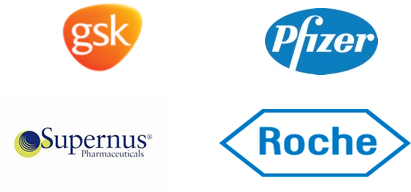
Additional services provided by our Segmedica® division include:
Anthropology-based research.
All forms of anthropological research, including in-home, in-office, or in-hospital are conducted by our health experts. Our staff includes experienced sociologists and anthropologists as well as both clinical and academic psychology advisors. Some examples of Anthropological work include:
- HealthVoice®
- SocialInsight™
- SelfInspire®
- Ethnography
RxConnex™ – a Powerful New Pharmacy Data Tool
A source for obtaining complete pharmacy records for study respondents. We have exclusive access to pharmacy records covering 85% of the US population. The service requires patient agreement and is HIPAA compliant. You will not receive any PHI as part of the process.
Why consider this service:
- Our pilot studies confirm that, in many cases, the difference between patient-reported medical conditions, products taken, and levels of compliance and the facts are very large indeed. Particularly for studies involving complex and co-morbid conditions, RxConnex is an essential validation step.
- We provide data and metrics including medication possession ratio (MPR) and proportion of days covered (PDC) as well as persistence data
- EMR data has been shown to be unreliable in terms of prescribed medicines and those actually taken by the patient.
- EMR data is very costly to obtain. The cost of RxConnex data is low and will add very little to the cost of your project.
- For smaller, qualitative studies, making sure you have the right patient respondents.
- Tracking patients’ behaviors over time.
- Adherence and/or compliance studies where patient-level data is critical to understanding patient behavior.
- Show patterns in compliance or persistence over a period of time.
- Follow specific patients and track their adherence and persistence.
- HEOR data validation and insights in outcomes studies.
Valuable in:
- Patient flow
- Patient journey
- Buying process
- Patient segmentation
- Research for adherence programs and support programs
JourneySmart™
When you need to walk in your customers’ shoes, see the world through their eyes, experience their life as if it was your own, and to viscerally understand their unmet needs, you need a research firm that can explain how their minds are working and then how you can effectively influence their behaviors. Research America has a wide range of research methodologies and has specialized experts on staff with a very diverse toolbox.
Key Advantages:
- Superb patient journeys and customer experience reports
- Specialized research for journeys in the digital space
- HEOR for the economic and outcome journey and/or clinical trial experience
- For rare and ultra-rare diseases, our in-house recruitment unit can find and engage your targets
- Deeper, more meaningful, and more actionable results
- Can be built around your customer or patient segmentation, one of our PersonaSmart personality-based psychological models, or both
- Assurance of a project completed to the highest standard, on time, and on budget
- Rare and ultra-rare diseases and specialties
PersonaSmart™ Provides actionable results using a unique global profiling tool.
PersonaSmart™ is an innovative way of linking personality to decision-making and behavior in healthcare, healthy eating at home and out in the world, nutrition, personal care and beauty, pet care – in fact, in any activity to do with health and wellness.
We have developed personality-based models which are strongly predictive to decision-making processes and behaviors in the following categories:
- Customer Health and Wellness
- Food, Beverage, and Nutrition
- Health Networks and Services
- Pharmaceuticals and Devices
Simple and effective, PersonaSmart™ provides actionable results using a unique global profiling tool. Contact us to learn more!
TripleSmart™
TripleSmart™ is a whole new way of looking at market segmentation embracing three distinct methodologies in one study.
The advantages for you are:
- Superior customer insights and actionability
- Removes risk of project failure
- Uses a globally validated personality tool
- Can result in significant cost and time savings
- Ideal for rare and ultra-rare populations and markets
- Works consistently across all medical, healthcare, nutrition, provider, plans, health and wellness, and beauty markets
For more information about our pharmaceutical market research and how we can help you, please Contact Us
CUSTOMER EXPERIENCE
CONSUMER INSIGHTS
- Marketing Research |
- Market Research Surveys |
- Market Research Company |
- Market Research Interviews |
- Market Research Calls |
- Market Research News |
- Market Research Initiative |
- Privacy Policy |
- Technology Vendors
- Recent Research
- Media Support
Founded Year
Total raised, last raised, about r-pharm.
R-Pharm is a Russian private hi-tech pharmaceutical company founded in 2001, employs over 3200 highly qualified specialists, has over 60 branches. R-Pharm operates in Russia and CIS, USA, Germany, Japan, Turkey/MENA and India. The company is involved in R&D, manufacturing, marketing, sales and distribution of innovative pharmaceutical products from a broad number of therapeutic areas in specialty/hospital care.
Headquarters Location
10, Testovskaya st
Moscow, 123317,
Russian Federation
R-Pharm Patents
R-Pharm has filed 7 patents.
The 3 most popular patent topics include:
- antineoplastic drugs
- clusters of differentiation

Grant Date | Title | Related Topics | Status |
|---|---|---|---|
Application Date | |
|---|---|
Grant Date | |
Title | |
Related Topics | |
Status |
Latest R-Pharm News
Apr 12, 2024
(Las Vegas, Nevada, United States) As per DelveInsight’s assessment, globally, Gout pipeline constitutes 40+ key companies continuously working towards developing 40+ Gout treatment therapies, analysis of Clinical Trials, Therapies, Mechanism of Action, Route of Administration, and Developments analyzes DelveInsight. The Gout Pipeline report embraces in-depth commercial and clinical assessment of the pipeline products from the pre-clinical developmental phase to the marketed phase. The report also covers a detailed description of the drug, including the mechanism of action of the drug, clinical studies, NDA approvals (if any), and product development activities comprising the technology, collaborations, mergers acquisition, funding, designations, and other product-related details. “ Gout Pipeline Insight, 2024 “ report by DelveInsight outlines comprehensive insights into the present clinical development scenario and growth prospects across the Gout Market. Some of the key takeaways from the Gout Pipeline Report: Companies across the globe are diligently working toward developing novel Gout treatment therapies with a considerable amount of success over the years. Gout companies working in the treatment market are TaiwanJ Pharmaceuticals, Nippon Chemiphar, HemoShear Horizon Therapeutics, Protalix BioTherapeutics, Horizon Therapeutics plc, Arthrosi Therapeutics, Dyve Biosciences, LG Chem, Jiangsu Hengrui Medicine Co., Selecta Biosciences Inc, InventisBio Co., Ltd, Allena Pharmaceuticals, Olatec Therapeutics LLC, Shanton Pharma Co., Ltd., LG Chem, and others, are developing therapies for the Gout treatment Emerging Gout therapies in the different phases of clinical trials are- TJC-0434, NC-2700, Research Program, NC-2500, PRX-115, HZN-457, AR-882, DYV700, LC350189, SHR-4640, SEL-212, D-0120 + Allopurinol, ALLN-346, Dapansutrile, SAP001, Tigulixostat, and others are expected to have a significant impact on the Gout market in the coming years. In February 2024, PK Med, a biotechnology company headquartered in France, has obtained clearance from the US Food and Drug Administration (FDA) to progress its injectable gout treatment, PKM-01, directly into Phase II clinical trials, bypassing Phase I studies. The Phase II trial will assess three different doses of PKM-01, a combination therapy consisting of controlled-release colchicine with ropivacaine, an anesthetic. This prospective, randomized study aims to determine the optimal dosage of the treatment for further advancement into Phase III trials. In March 2023, Selecta Biosciences, Inc. revealed favorable outcomes from the Phase 3 DISSOLVE I & II trials, comparing SEL-212 against a placebo. SEL-212 aims to address chronic refractory gout. Gout Overview An extremely painful type of inflammatory arthritis that is common is gout. Usually, it only affects one joint at a time, most commonly the big toe joint. Periods of increased symptom severity are referred to as flares, and periods with no symptoms are referred to as remission. TJC-0434: TaiwanJ Pharmaceuticals NC-2500: Nippon Chemiphar SEL-212: Selecta Biosciences Inc ALLN-346: Allena Pharmaceuticals Tigulixostat: LG Chem Further Gout product details are provided in the report. Download the Gout pipeline report to learn more about the emerging Gout therapies Some of the key companies in the Gout Therapeutics Market include: Key companies developing therapies for Gout are – Jiangsu Hengrui Medicine, Selecta Biosciences, LG Chem, Shanton Pharma, TWi Biotechnology, Olatec Therapeutics, Allena Pharmaceuticals, JW Pharmaceutical, Revive Therapeutics, Hinova pharmaceuticals, Arthrosi Therapeutics, Dyve Biosciences, Jiangsu Atom Bioscience and Pharmaceutical, Swedish Orphan Biovitrum, Allen Pharmaceuticals, Teijin Pharma, AstraZeneca, R-Pharm, InventisBio, Nippon Chemiphar, Sinovent, Shenyang Sunshine Pharmaceutical, Rigel Pharmaceuticals, Chongqing Fochon Pharmaceutical, Alnylam Pharmaceuticals, Enzychem Lifesciences, Arrowhead Pharmaceuticals, Horizon Therapeutics, and others. The Gout pipeline report provides insights into The report provides detailed insights about companies that are developing therapies for the treatment of Gout with aggregate therapies developed by each company for the same. It accesses the Different therapeutic candidates segmented into early-stage, mid-stage, and late-stage of development for Gout Treatment. Gout key companies are involved in targeted therapeutics development with respective active and inactive (dormant or discontinued) projects. Gout Drugs under development based on the stage of development, route of administration, target receptor, monotherapy or combination therapy, a different mechanism of action, and molecular type. Detailed analysis of collaborations (company-company collaborations and company-academia collaborations), licensing agreement and financing details for future advancement of the Gout market. The report is built using data and information traced from the researcher’s proprietary databases, company/university websites, clinical trial registries, conferences, SEC filings, investor presentations, and featured press releases from company/university websites and industry-specific third-party sources, etc. Gout Pipeline Market Drivers The rise in the prevalence of Gout, Novel urate-lowering agents are some of the important factors that are fueling the Gout Market. Gout Pipeline Market Barriers However, gaps in the quality of care, lack of knowledge about guidelines and evidence based gout management, lack of novel therapies in Gout pipeline and other factors are creating obstacles in the Gout Market growth. Coverage: Global Key Gout Companies: TaiwanJ Pharmaceuticals, Nippon Chemiphar, HemoShear Horizon Therapeutics, Protalix BioTherapeutics, Horizon Therapeutics plc, Arthrosi Therapeutics, Dyve Biosciences, LG Chem, Jiangsu Hengrui Medicine Co., Selecta Biosciences Inc, InventisBio Co., Ltd, Allena Pharmaceuticals, Olatec Therapeutics LLC, Shanton Pharma Co., Ltd., LG Chem, and others Key Gout Therapies: TJC-0434, NC-2700, Research Program, NC-2500, PRX-115, HZN-457, AR-882, DYV700, LC350189, SHR-4640, SEL-212, D-0120 + Allopurinol, ALLN-346, Dapansutrile, SAP001, Tigulixostat, and others Gout Therapeutic Assessment: Gout current marketed and Gout emerging therapies Gout Market Dynamics: Gout market drivers and Gout market barriers
R-Pharm Frequently Asked Questions (FAQ)
When was R-Pharm founded?
R-Pharm was founded in 2001.
Where is R-Pharm's headquarters?
R-Pharm's headquarters is located at 10, Testovskaya st, Moscow.
What is R-Pharm's latest funding round?
R-Pharm's latest funding round is Debt.
How much did R-Pharm raise?
R-Pharm raised a total of $237M.
Who are the investors of R-Pharm?
Investors of R-Pharm include Vnesheconombank and OrbiMed Advisors.
CBI websites generally use certain cookies to enable better interactions with our sites and services. Use of these cookies, which may be stored on your device, permits us to improve and customize your experience. You can read more about your cookie choices at our privacy policy here . By continuing to use this site you are consenting to these choices.
- Fierce Pharma
- Fierce Biotech
- Fierce Healthcare
- Fierce Life Sciences Events
- Cell & Gene Therapy
- Drug Delivery
- Warning Letters
- Special Reports
- Special Report
- Awards Gala
- Fierce Events
- Industry Events
- Whitepapers
Scilex's Semnur Pharmaceuticals to go public through $2.5B SPAC merger as it advances sciatica prospect
Semnur Pharmaceuticals, which is working on a non-opioid prospect for sciatica, has agreed to merge with special purpose acquisition company Denali Capital Acquisition Corp. in a deal worth $2.5 billion.
Upon closure of the deal , which is expected by the first quarter of 2025, Semnur plans to continue the road to potential commercialization for its lead candidate Semdexa.
Semdexa is an injectable corticosteroid gel formulation of dexamethasone sodium phosphate that’s meant to treat patients with moderate to severe lumbosacral radicular pain, or sciatica.
The condition causes pain in patients' lower back and hips, symptoms that are often treated with opioids, Semnur’s parent company Scilex Holding Company has previously noted .
In a phase 3 study of 401 patients, treatment with Semdexa triggered a “rapid onset” of pain relief and continued to reduce pain intensity for over one month, Scilex said in March 2022. If approved, the med would be the first cleared to specifically treat the condition.
In a pain field where UCB and Biogen have have come up short , Semdexa could represent a major commercial boon. The drug could rake in sales of $1.5 billion to $2 billion by the fifth year of launch in just the sciatica indication, Scilex has forecast, citing independent market research by Syneos Health Consulting.
The treatment holds an FDA fast-track designation, and a 700-patient trial needed to support a potential approval was previously projected to finish enrollment in 2025.
“With Semnur on its way to becoming a publicly-traded company, our unique model continues to demonstrate the multiple ways that we can unlock the value of Scilex and enhance our shareholders’ value,” Scilex’s CEO Jaisim Shah said in the company’s release. “I believe this business combination will enable us to advance our growth strategy, which includes gaining access to public markets and exploring potential partnerships and global pharma collaborations for our product candidate, Semdexa.”
Scilex, a former subsidiary of troubled Sorrento Therapeutics, also made its way to the U.S. public markets through a SPAC merger with Vickers Vantage Corp. in a deal that closed in 2022. The company now markets migraine treatment Elyxyb and gout flare preventative Glopera as well as pain patch ZTlido.
Manage My Cookies
Your privacy is important to us. Cookies are very small text files that are stored on your computer when you visit a website. We use cookies and other tracking technologies for a variety of purposes and to enhance your online experience on our website. You can change your preferences and decline certain types of cookies to be stored on your computer while browsing our website. You can also remove any cookies already stored on your computer, but keep in mind that deleting cookies may prevent you from using parts of our website. You can check our privacy policy page for more information.
- Strictly Necessary Cookies Always Active These cookies are essential to provide you with services available through our website and to enable you to use certain features of our website. Without these cookies, we cannot provide you certain services on our website; as a result these cookies do not require your consent. Advertisement Cookies These cookies are used to show advertising that is likely to be of interest to you based on your browsing habits. These cookies, as served by our content and/or advertising providers, may combine information they collected from our website with other information they have independently collected relating to your web browser's activities across their network of websites. Functionality Cookies These cookies are used to provide you with a more personalized experience on our website and to remember choices you make when you use our website. For example, we may use functionality cookies to remember your language preferences or remember your login details. Analytics Cookies These cookies are used to collect information to analyze the traffic to our website and how visitors are using our website. For example, these cookies may track things such as how long you spend on the website or the pages you visit which helps us to understand how we can improve our website site for you. Strictly Necessary Cookies Always Active These cookies are essential to provide you with services available through our website and to enable you to use certain features of our website. Without these cookies, we cannot provide you certain services on our website; as a result these cookies do not require your consent. Advertisement Cookies These cookies are used to show advertising that is likely to be of interest to you based on your browsing habits. These cookies, as served by our content and/or advertising providers, may combine information they collected from our website with other information they have independently collected relating to your web browser's activities across their network of websites. Functionality Cookies These cookies are used to provide you with a more personalized experience on our website and to remember choices you make when you use our website. For example, we may use functionality cookies to remember your language preferences or remember your login details. Analytics Cookies These cookies are used to collect information to analyze the traffic to our website and how visitors are using our website. For example, these cookies may track things such as how long you spend on the website or the pages you visit which helps us to understand how we can improve our website site for you.
Search in PhRMA

Medicines in Development
Medicines in development for vaccines: 2024 report.

Vaccines are one of the most effective tools for protecting and promoting public health. Download our analysis on the vaccine pipeline to learn about the innovative treatments and preventions in development.

Medicines in Development for Cancer: 2023 Report
Today, there are 1,600 treatments and vaccines in development for cancer. Explore the new report from PhRMA examining these innovative medicines.

Medicines in Development 2023 Report: The Leading Chronic Diseases Impacting Older Americans
Today, there are more than 400 medicines in development for leading chronic diseases affecting older Americans. A new report from PhRMA explores the medicines that target these diseases and conditions.

Medicines in Development for Mental Illness 2023 Report
Read more about the full list of more than 180 medicines treating the many diseases and conditions of particular concern to mental health.

Medicines in Development 2022 Report: Chronic Diseases
Today, there are nearly 800 medicines in development for chronic diseases. A new report from PhRMA explores these medicines that target these diseases and conditions.

Medicines in Development 2022 Report: Disorders of the Blood
Read about the more than 500 medicines, treating many of the diseases and conditions that affect the blood, that are currently in development by the America's biopharmaceutical research companies.

Medicines in Development for Women's Health 2022 Report
Read about the more than 600 medicines and vaccines, treating many of the diseases and conditions of particular concern for women's health, that are currently in development by the America's biopharmaceutical research companies.

Medicines in Development for Rare Diseases 2021 Report
Read about the more than 700 medicines and vaccines, treating many of the approximately 8,000 known rare diseases, that are currently in development by the America's biopharmaceutical research companies.
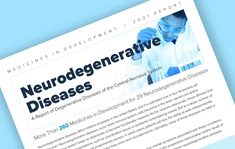
Medicines in Development for Neurodegenerative Diseases 2021 Report
Today, more than 260 medicines and vaccines for 29 different neurodegenerative diseases are currently in development by innovative biopharmaceutical research companies.
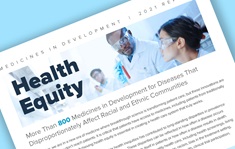
Medicines in Development for Health Equity 2021 Report
Today, more than 800 medicines are in development for diseases that disproportionately affect racial and ethnic communities.
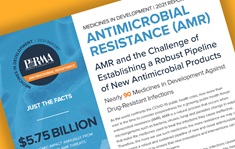
Medicines in Development for Antimicrobial Resistance 2021 Report
As the world confronts the COVID-19 public health crisis, now more than ever is the time to consider preparedness for a growing public health threat: antimicrobial resistance (AMR). This means a robust and sustained pipeline of new and novel antimicrobial medicines is critical to ensure that new innovations and interventions can keep pace with these evolving pathogens.
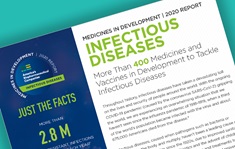
Medicines in Development for Infectious Diseases 2020 Report
More than 400 medicines and vaccines are in development to tackle infectious diseases.
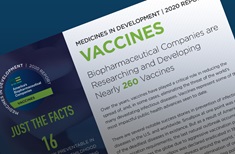
Medicines in Development for Vaccines 2020 Report
Over the years, vaccines have played a critical role in reducing the spread of, and, in some cases, eliminating the threat of the world’s many devastating infectious diseases. Vaccines represent some of the most impactful public health advances seen to date.
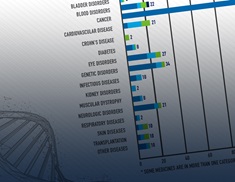
Medicines in Development for Cell and Gene Therapy 2020
Nearly 400 cell and gene therapies are in development, targeting a broad range of diseases.
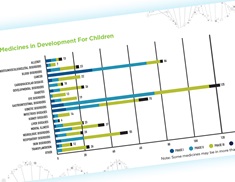
Medicines in Development for Children 2020 Report
The biopharmaceutical industry is currently developing nearly 600 medicines to meed the unique needs of pediatric patients.
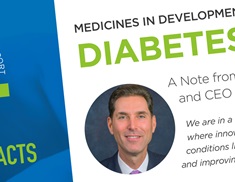
Medicines in Development for Diabetes 2019 Report
Biopharmaceutical companies are developing more than 160 new treatments for diabetes, including some that would offer an oral medicine option for Type 1 diabetes patients who currently administer insulin daily.
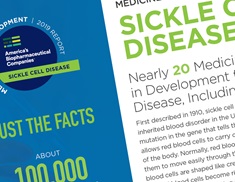
Medicines in Development for Sickle Cell Disease 2019 Report
There are nearly 20 medicines in development for Sickle Cell Disease, including gene therapies.
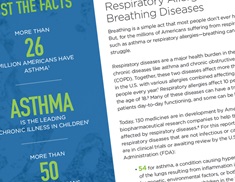
Medicines in Development for Asthma and Allergy 2019 Report
There are more than 100 medicines in development for Asthma, respiratory allergies, and other breathing diseases.

Medicines in Development for Skin Diseases 2018 Update
More than 300 medicines to treat skin diseases are in development by biopharmaceutical research companies.

Medicines in Development for Heart Disease and Stroke 2018 Report
America’s biopharmaceutical research companies are developing 200 medicines for leading causes of death in the U.S.

Medicines in Development for Neurological Disorders 2018 Report
America's biopharmaceutical companies are developing 537 medicines for numerous, wide-ranging neurological disorders.

Medicines in Development for Alzheimer's Disease 2017 Report
America’s biopharmaceutical research companies are investigating or developing 85 medicines for Alzheimer's.
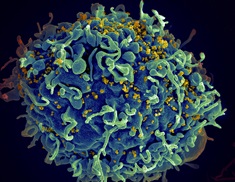
Medicines in Development for HIV 2017 Report
America’s biopharmaceutical research companies are developing 52 medicines and vaccines for HIV.

Medicines in Development for Immuno-Oncology 2017 Report
America’s biopharmaceutical research companies are developing more than 240 immuno-oncology treatments.

Medicines in Development for Autoimmune Diseases 2016 Report
America’s biopharmaceutical research companies are investigating or developing 80 medicines for autoimmune diseases.

Medicines in Development for Osteoporosis 2016 Report
America's biopharmaceutical research companies are developing nine medicines for the treatment of osteoporosis.

Medicines in Development for Leukemia & Lymphoma 2015 Report
America’s biopharmaceutical research companies are developing more than 240 medicines for leukemia, lymphoma and other blood cancers.

Medicines in Development for Parkinson's Disease 2014 Report
America’s biopharmaceutical research companies are currently developing 37 medicines to help the estimated 1.5 million Americans living with Parkinson’s Disease.

Medicines in Development for Biologics 2013 Report
America’s biopharmaceutical research companies are developing 907 biologics targeting more than 100 diseases.

Medicines in Development for COPD 2012 Report
America’s biopharmaceutical research companies are working on 54 medicines to treat chronic obstructive pulmonary disease (COPD).

Inflation Reduction Act Could Have Devastating Consequences for Americans
The Inflation Reduction Act puts patients’ access to medicines on the line.
This website uses cookies and other tracking technologies to optimize performance, preferences, usage, and statistics. By clicking “Accept All”, you consent to store on your device the cookies and other tracking technologies that require consent. You can tailor or change your preferences by clicking “Manage My Cookies”. You can check our privacy policy for more information.
A nation must think before it acts.

- America and the West
- Middle East
- National Security
- Central Asia
- China & Taiwan
- Expert Commentary
- Conversations
- Intern Corner
- Newsletters
- Press Contact
- Upcoming Events
- People, Politics, and Prose
- Briefings, Booktalks, and Conversations
- The Benjamin Franklin Award
- Event and Lecture Archive
- Ties That Bind: NATO at 75 and Beyond
- Chain Reaction
- Bear Market Brief
- Baltic Ways
- Report in Short
- Our Mission
- Board of Trustees
- Board of Advisors
- Research Programs
- Audited Financials
- PA Certificate of Charitable Registration
- Corporate Partnership

The Rise of Sino-Russian Biotech Cooperation
- Svitlana Lebedenko
- May 9, 2022
- Eurasia Program
The People’s Republic of China’s rise as a global innovation power is rooted in the development of a sovereign innovation infrastructure, one that allows China to compete in high-technology races with the United States. This process is complemented by an intensifying science and technology partnership with the Russian Federation. By decoupling from China and Russia, the United States and its allies are pushing China and Russia closer to each other. The paper discusses recent examples of Sino-Russian biotechnology cooperation projects, offering an early account of the emerging integration of two distinct but complementary innovation infrastructures.

Introduction
The People’s Republic of China’s emergence as a global power is rooted in the rapid development of a sovereign innovation infrastructure, one that allows China to compete in high-technology races with the United States. China’s build-up of its innovation infrastructure is complemented by another process: an intensifying cooperation with the Russian Federation in security, trade, energy supplies, artificial intelligence, 5G, space research, and biotechnology. Moscow and Beijing have a complicated history of interactions. Previously, China and the Soviet Union were isolated from the world market of technology, and after the Sino-Soviet relationship worsened, they were also isolated from each other. However, today, in light of deteriorating relations with the United States, strategic alignment emerges. The U.S. and the European Union’s decoupling from business with China and imposing economic sanctions on Russia push the two countries to examine the potential of their strategic cooperation more closely. [1]

Innovation Infrastructure
China and Russia are very different in terms of their innovation performance. China has an ascending trajectory and has already advanced to self-sufficient manufacturing of “sophisticated intermediate goods.” [2] It is well integrated into global innovation networks, while Russia is not. Since the break-up of the Soviet Union, Russia has been sliding down a descending trajectory. [3] It became a natural resource exporter heavily dependent on imports of foreign technology.
Regardless of these differences, Beijing and Moscow are actively developing a joint innovation infrastructure. The two countries declared 2020 and 2021 the “Cross Years of Russian and Chinese scientific, technical, and innovation cooperation.” [4] China demonstrated its ability in launching and managing large-scale projects and leads in Sino-Russian partnerships. Most of the infrastructure projects take place under the auspices of the Belt and Road Initiative. [5] For example, one of its institutes is Russia-China Investment Fund, a private equity fund established jointly by the Russian Direct Investment Fund and China Investment Corporation, which equally committed USD 2 billion. [6]

Lomonosov Moscow State University (left) and Tsinghua University Campus (right). (Adobe Stock)
The purpose of building this type of infrastructure is to accelerate Sino-Russian partnerships in science and technology and facilitate technology transfer. In 2020, the two countries announced the construction of the first Sino-Russian Innovation Complex, a joint venture of Tus-Holdings, Russian Direct Investment Fund, Tsinghua University, and Lomonosov Moscow State University. The purpose of this Innovation Complex is to prepare for future joint research and development centers, university labs for basic research, and science parks. This project followed the establishment in 2016 of the first Sino-Russian university founded by Beijing Institute of Technology, Shenzhen Municipal People’s Government, and Lomonosov Moscow State University. [7] The new university’s mission is to “to nurture talents for the Belt and Road Initiative.” [8] Few joint research centers, for instance, in computational mathematics and cybernetics, were launched, and there are plans to open other centers in chemistry and materials, biology, and space science. [9]
In addition, the Russia-China Investment Fund, in partnership with Tus-Holdings, supports the construction of the Sino-Russian High-Tech Innovation Park at the Skolkovo Innovation Centre. According to the press release, “Tus-Holdings is considering the possibility to create a network of innovation facilities in Russia by building new technology parks in other areas of the country.” [10] Another science and technology park within Lomonosov Moscow State University is anticipated and is expected to “become a platform for innovative cooperation between scientific and technological workers and scientific and technological enterprises of the two countries.” [11]
These projects are recent, and at the moment, it is unclear whether they would be successful in spurring actual innovation in the near future. What is clear, though, is that their proliferation in the last few years signals the commitment to closer and long-term integration of the Russian and Chinese innovation systems. Such integration is incremental and might take decades. In the words of Tus-Holdings Chairman Jiwu Wang, the company’s vision is “ an ecosystem of innovative cooperation in science and technology between China and Russia . . . and deepening economic integration between the two countries” [emphasis added]. [12]

(sputnikvaccine.com)
Biotechnology
Chinese-Russian technological alignment has been particularly apparent in the sector of biotechnology. Broadly, biotechnology refers to the manipulation of living organisms or their compounds to produce new products or services. Biotechnology is perceived to be “a key strategic technology for industrial growth” and is distinguished from other technological sectors for its capacity to alter the means of production across a variety of industrial sectors. [13] Examples of the sectors include pharmaceuticals, agriculture, and food processing, and extend to dual-use technologies.
Biotechnology is a strategic sector for China. The Made in China 2025 Initiative sets the goal of manufacturing high-tech products, including innovative medicines. [14] The plan introduced targets for Chinese pharmaceutical firms to advance in biotechnology innovation and increase exports. [15] About half of all industrial parks in China focus on the development of pharmaceuticals. [16] By 2018, China established 111 biotechnology science parks. [17] Although China still lags behind the U.S. in biotechnology innovation, analysts concede that it is rapidly progressing and closing this gap. [18] So far, China’s efforts have concentrated on creating the necessary infrastructure for biotechnology development.
In turn, Russia has rich natural resources, but over 80% of biotech products are imported, and Russia’s share in the global market of biotech products is below 0.1%. [19] Russian biotech is a sector that experienced massive brain drain after the break-up of the Soviet Union, with many scientists leaving for Western countries and Israel. [20] The persistent challenge for the Russian biotechnology industry, including the biopharmaceutical industry, is its critical dependency on imports. Between 1992 and 2014, the production of substances (active pharmaceutical ingredients) decreased by a factor of 20. [21] According to the Ministry of Industrial Policy of Russia, in 2015, the country imported 95% of active pharmaceutical ingredients required to produce finished pharmaceuticals. [22] In 2018, the share of foreign medicines on the Russian market constituted 70.2% by value and 39.4% by volume. In 2019, foreign medicines generated USD 19.6 billion in income, which was about 70% of the Russian pharmaceutical market. [23] By some accounts, this sum is larger than what Russia earns from its arms export. [24] Pharmaceutical imports exceed exports by 14 times. [25] By all formal indicators in life-science research and biotechnology, such as gross domestic product (GDP) expenditure on R&D, patents, and journal publications, Russia lags behind the United States, China, France, South Korea, Japan, Germany, and India. [26]
Yet, Russia sees biotechnology as a priority area for its future. [27] The first post-Soviet strategic document in this area was enacted in 2012 and entitled the State Coordination Program for the Development of Biotechnology in the Russian Federation until 2020 (BIO 2020). Around USD 18 million was invested in the development of biotechnology, with 22% directed to biomedicine and biopharmaceuticals research. [28] The results of the program are considered limited, except for some improvement in vaccine and monoclonal antibodies research. [29] The state programs in the pharmaceutical industry appear to be more specific and thus more practical.
For example, the State Program for the Development of the Pharmaceutical and Medical Industry until 2020 (PHARMA 2020), published in 2014, attempted to reduce Russia’s dependency on foreign medical technologies. Sanctions put added pressure on import substitution in this area. [30] As a result of this program, 50 new industrial sites were built, 130 new medicines entered the market (9 of which were classified as innovative), and 8 scientific-research centers of pre-clinical development were built or reconstructed. [31] In addition, PHARMA 2020 launched several biopharmaceutical projects, including those of Biocad and Generium, [32] some of the largest producers of the Sputnik V vaccine. [33]
Moscow approved PHARMA 2030 in December 2021. The main difference between PHARMA 2020 and PHARMA 2030 is a call for an upgrade from import substitution to an innovative model of production. In nine years, Russia aims to double the production of local medicines and medical equipment and increase their export. The program foresees investment in infrastructure to allow for deepening cooperation between production, science, and education. [34]
According to data from the Eurasian Economic Commission, Russia’s innovative companies include few active players: Generium, ChemRar, Biocad, and Pharmapark. [35] ChemRar, a high-tech center in the Moscow region, hosts a handful companies benefiting from its infrastructure and scientific-research institute. One of the objectives of the center is conducting R&D for its partners especially around innovative antibiotics. In 2020, ChemRar, with the help of the Russian Direct Investment Fund (RDIF), developed a specific medicine for anti-coronavirus treatment, Avifavir, which is currently supplied to 15 countries. [36] Avifavir is based on a known substance Favipiravir, originally developed in Japan to treat influenza, but ChemRar conducted clinical trials to confirm its effectiveness in treating COVID-19 specifically. Pharmapark, another Moscow-based company, is Russia’s top producer of the active pharmaceutical ingredient interferon alfa-2b and covers 80% of local demand of Russian producers of finished pharmaceuticals. Some of these companies are becoming instrumental in Sino-Russian biotech partnership.
When it comes to breakthroughs, what is notable about the Russian biopharma industry is the persistent Soviet legacy of production being subordinated to research institutes. By estimates, about 30 universities, mostly in Moscow and Saint Petersburg, have programs in biotechnology, and about 50 institutes of the Russian Academy of Science conduct biology research. [37] Consider the Russian COVID-19 vaccines as an example. The Sputnik V vaccine came out from the Gamaleya Institute, a state-owned research institute, not from industry. The Novosibirsk-based state-owned scientific center, Vektor State Research Center of Virology and Biotechnology, developed the EpiVacCorona vaccine. [38] Similarly, state-owned Chumakov Scientific Center for Research and Development of Immune-and-Biological Products of Russian Academy of Sciences developed the KoviVac vaccine. [39]

Arguably, Russia’s weak point is not in the development of biopharmaceutical innovation but in scaling-up of production. In the biotechnology sector, innovative projects are financially supported through Russian development institutes, such as Skolkovo, Russian Venture Company, and Rusnano. [40] Often, their resources only suffice for the development stage but not for substantially increasing production. For the latter, the Russian Foreign Direct Investment Fund plays a bigger role, but it would be limited without help from its international partners. This is where China’s resources find a good application.
Notwithstanding the respective limitations of national biotech industries, Russia and China’s cooperation has recently intensified and involved the use of the joint innovation infrastructure projects mentioned above. For example, Russian company Biocad, [41] together with Chinese manufacturer Shanghai Pharmaceuticals Holding (SPH), created a joint venture, SPH Biocad, based in China. SPH Biocad will commercialize Biocad’s portfolio of medicines (e.g., oncology and autoimmune treatment) in the Chinese market. [42] The joint venture received USD 400 million in funding, in which SPH holds 50.1% and Biocad 49.9%. [43] The long-term plan is to turn the joint venture from a generic producer into an innovative player. [44]
Another example of the use of the joint innovation infrastructure to advance biopharmaceutical cooperation is the Russia-China Investment Fund. In 2020, it invested in the creation of the Russian pharmaceutical holding Binnopharm Group. [45] In the same year, Binnopharm Group joined a group of companies involved in the production of the Sputnik V vaccine. With consolidated assets, Binnopharm Group became one of the top three largest pharmaceutical manufacturers in Russia and now owns the portfolio of over 450 registered medicines, the most among Russian companies. [46] Binnopharm Group plans to establish a new R&D center in Krasnogorsk (Moscow region) by integrating R&D centers of the enterprises that were merged and invest USD 33 million in the development of 100 new medicines by 2025. [47] The impact on biopharmaceutical innovation of this merger is yet to be seen. Evidently though, China has been behind the major projects aiming to help Russia create and improve the necessary infrastructure for the development of biopharmaceuticals industry. Infrastructure for innovation-based industries, such as biotechnology, is a key pillar, and China’s kind of investment in Russia is aimed to develop and upgrade the necessary innovation capabilities.
In addition to joint investments, China and Russia have launched bilateral research projects. The countries agreed to establish a joint laboratory for research on COVID-19. The National Fund of Natural Sciences of China and the Russian Fund of Fundamental Research will supervise the project. [48] In a similar vein, the Russian Vektor State Research Centre of Virology and Biotechnology have cooperated with the Ministry of Science and Technology of China on projects related to the human avian influenza (bird flu). [49] The exchange of vaccine technology and declarations to combine efforts in coronavirus research accelerated the formation of the institutional links between the Chinese and Russian innovation systems, especially in the biotechnology sector. It signals the countries’ commitment to an enduring innovation partnership. [50]
The processes addressed in this paper have been unfolding before the war in Ukraine. Western decoupling from China and Russia has been pushing the two countries towards deepening their cooperation. The accelerating Sino-Russian innovation cooperation projects confirm this assumption. While it can be premature to assess the levels of joint biopharmaceutical innovation, the implications of China’s engagement with the Russian biotech are not trivial. The nature of this engagement goes beyond investment projects, aiming to strengthen the institutional links between research organizations, manufacturers, and sovereign funds of the two nations. After February 24, 2022, Western sanctions and companies fleeing Russia will force Moscow to seek deeper cooperation with China in high-tech sectors. Russian biotech is not a self-sufficient industry and requires international partnerships to develop. But Russia is now limited in who it can partner with. Given the past trajectory of joint innovation partnership, naturally, China is now Russia’s ultimate bet when it comes to biotechnology development. Russian biotech future is in China’s hands. There are not currently signs that China will change its favorable position towards Russia; hence, Sino-Russian innovation partnerships will likely intensify.
[1] Samuel Bendett and Elsa Kania, ‘A New Sino-Russian High-Tech Partnership’, Australian Strategic Policy Institute , October 2019, https://www.aspi.org.au/report/new-sino-russian-high-tech-partnership.
[2] Richard E. Baldwin, The Great Convergence: Information Technology and the New Globalization (Cambridge, Massachusetts: The Belknap Press of Harvard University Press, 2016), p. 294.
[3] For more details, see, Svitlana Lebedenko, ‘Russian Innovation in the Era of Patent Globalization’, IIC – International Review of Intellectual Property and Competition Law 53, no. 2 (2022): pp. 173-193.
[4] Desheng Cao, ‘China, Russia Enhance Links in Sci-Tech Innovation’, China Daily , November 2021, https://www.chinadaily.com.cn/a/202111/27/WS61a16e3ea310cdd39bc77dbd.html.
[5] A long-term project announced by the General Secretary Xi Jinping in 2013 and envisioned to be completed by 2049.
[6] Russia-China Investment Fund, http://rcif.com/ . See also: Belt and Road Initiative, ‘BRI Institutions’, https://www.beltroad-initiative.com/institutions-and-mechanisms/ .
[7] ‘About the University: Brief’, Shenzhen MSU-BIT University, https://en.smbu.edu.cn/About_the_University/Brief.htm.
[9] ‘Development Plan’, Shenzhen MSU-BIT University, https://en.smbu.edu.cn/info/1035/1258.htm.
[10] Russian Direct Investment Fund, ‘RCIF and Tus-Holdings expand comprehensive cooperation in the technology & innovation sector’, September 11, 2018, https://rdif.ru/Eng_fullNews/3412/ .
[11] ‘RDIF, RCIF and Tus-Holdings agree to jointly establish innovation center at Lomonosov Moscow State University’, April 26, 2019, https://rdif.ru/Eng_fullNews/4050/ .
[13] Susan Bartholomew, ‘National Systems of Biotechnology Innovation: Complex Interdependence in the Global System’, in Systems of Innovation: Growth, Competitiveness and Employment , ed. Charles Edquist and Maureen McKelvey, I (Cheltenham, UK; Northampton, MA, USA: Edward Elgar Publishing Limited, 2000), pp. 444-445.
[14] Rolf Schmid and Xin Xiong, Biotech in China Innovation, Politics, and Economics (Singapore: Jenny Stanford Publishing, 2021), p. 285.
[15] Adolfo Arranz, ‘“Made in China 2025”: Beijing Bets on Biotech’, South China Morning Post , October 2018, https://multimedia.scmp.com/news/china/article/2167415/china-2025-biotech/index.html?src=social.
[16] ‘China’s Biotech Parks – Leveraging the Ecosystem for Success’ (Deloitte, May 2021), p. 2, https://www2.deloitte.com/cn/en/pages/life-sciences-and-healthcare/articles/pr-china-biotech-parks-leveraging-the-ecosystem-for-success.html.
[18] For indicators and comparative statistics, see, Robert D. Atkinson, ‘China’s Biopharmaceutical Strategy: Challenge or Complement to U.S. Industry Competitiveness?’ (Information Technology and Innovation Foundation, August 2019), https://itif.org/publications/2019/08/12/chinas-biopharmaceutical-strategy-challenge-or-complement-us-industry.
[19] Anna Grebenyuk and Nikolai Ravin, ‘The Long-Term Development of Russian Biotech Sector’, Foresight 19, no. 5 (September 2017): pp. 491, 498.
[20] Gigi Kwik Gronvall and Brittany Bland, ‘Life-Science Research and Biosecurity Concerns in the Russian Federation’, The Nonproliferation Review , February 2021, pp. 3-4.
[21] Vladimir V. Moiseev, State Policy of Economic Development of Modern Russia (2000-2016) (translation by author) (Moscow: Direkt-Media, 2017), p. 297.
[22] ‘Information on the Results of Analysis of the State and Development of the Biotechnology Industry of Member States of the Eurasian Economic Union – Working Materials (Translation by Author)’, (Moscow: Eurasian Economic Commission, Department of Industrial Policy, 2015), p. 27.
[23] Balakin, Ayginin, and Ivashenko, ‘Russian Pharmaceutical Industry until 2030: Analytic Overview (Translation by Author)’, p. 38.
[25] Aleksandr V. Evstratov, Main Tendencies and Ways of Development of the Pharmaceutical Market in the Russian Federation (translation by author) (Volgograd: VolgGTU, 2018), p. 18.
[26] Gronvall and Bland, p. 8.
[27] Ibid, p. 4.
[30] Arthur Boyarov, Alina Osmakova, and Vladimir Popov, ‘Bioeconomy in Russia: Today and Tomorrow’, New Biotechnology 60 (January 2021), p. 36.
[31] K.V. Balakin, A.A. Ayginin, and A.A. Ivashenko, ‘Russian Pharmaceutical Industry until 2030: Analytic Overview (Translation by Author)’ (Dolgoprudny: Biopharmaceutical Claster ‘Severnyi’, 2021), pp. 42-43.
[32] Boyarov, Osmakova, and Popov, ‘Bioeconomy in Russia’, p. 37.
[33] ‘Russian company plans to produce 5-6 mln doses of Sputnik V per month in June-July’, Tass , April 6, 2021, https://tass.com/economy/1274415 ; and ‘The Sputnik V Manufacturer Will Produce 20 Million Doses of Vaccine Per Month (translation by author)’, Generium , June 5, 2016, https://www.generium.ru/about/press_center/Media_about_us/proizvoditel-sputnika-v-s-iyulya-nachnet-vypuskat-20-mln-doz-vaktsiny-v-mesyats/ .
[34] Balakin, Ayginin, and Ivashenko, p. 43.
[35] ‘Information on the Results of Analysis of the State and Development of the Biotechnology Industry of Member States of the Eurasian Economic Union – Working Materials (Translation by Author)’, pp. 28-30.
[36] ‘Russia’s Avifavir Coronavirus Drug Registered in Indonesia’, Russian Direct Investment Fund , March 2021, https://rdif.ru/Eng_fullNews/6644/.
[37] ‘Overview of the Biotechnology Market in Russia and of its Prospects of Development (translation by author)’ (Frost & Sullivan, 2014), p. 21.
[38] By December 2020, Vektor has also developed a vaccine against HIV and conducted the first phase of clinical trials. Balakin, Ayginin, and Ivashenko, ‘Russian Pharmaceutical Industry until 2030: Analytic Overview (Translation by Author)’, pp. 41-42.
[39] ‘Pharmaceutical Market of Russia 2020 (Translation by Author)’ (Moscow: DSM Group, 2020), p. 117.
[40] ‘Overview of the Biotechnology Market in Russia and of its Prospects of Development (translation by author)’, p. 17.
[41] Biocad is a scientific-production company in the Moscow region with the focus on urology, gynecology, oncology, and neurology products.
[42] Ben Hargreaves, ‘China and Russia Collaborate to Create Biologics Joint Venture’, Bio-Pharma Reporter , October 2, 2019, https://www.biopharma-reporter.com/Article/2019/10/02/China-and-Russia-collaborate-to-create-biologics-JV .
[45] The Russian pharmaceutical company Alium was founded in 1994 on the basis of the Research Centre of Applied Microbiology. In 2019, it was acquired by JSC “AFK” Sistema. In 2020, all the pharmaceutical assets of the JSC “AFK” Sistema, including Alium, were merged in Binnopharm Group. See, Binnopharm Croup, https://binnopharmgroup.ru/.
[46] ‘Morgan Lewis Advises the Russia-China Investment Fund (RCIF) on Creation of Pharmaceutical Holding’, Chambers and Partners, February 2021, https://chambers.com/articles/morgan-lewis-advises-the-russia-china-investment-fund-rcif-on-creation-of-pharmaceutical-holding.
[47] ‘Russia’s Binnopharm Group Hopes to Launch up to 100 New Drugs in Comin’, ThePharmaLetter , September 2021, https://www.thepharmaletter.com/article/russia-s-binnopharm-group-hopes-to-launch-up-to-100-new-drugs-in-coming-years.
[49] ‘International Cooperation (Translation by Author)’, Russian Centre for Virology and Biotechnology ‘Vektor’, http://www.vector.nsc.ru/mejdunarodnoe-sotrudnichestvo/.
[50] See, for instance, a declaration of Xi Jinping on deepening the cooperation with Russia on vaccine development. ‘Xi Eyes Deeper Vaccine Cooperation with Russia’, Xinhuanet , August 2021, http://www.news.cn/english/2021-08/25/c_1310148390.htm.
You May Also be Interested in
Crowded pond: nato and russian maritime power in the baltic sea.
NATO has wrestled with how to defend its Baltic member states of Estonia, Latvia, and Lithuania ever since their...
Tensions Between Russia and Ukraine: How Likely is Another War?
As the war in Ukraine heads into its eighth year, many fear that Moscow may be preparing a...
A Tale of Two Elections: Lessons from the Very Different Trajectories of Democracy in Taiwan and Hong Kong in December 2021
Two elections, both postponed for months by authorities citing the difficulties and dangers of voting during the COVID-19 pandemic,...

IMAGES
VIDEO
COMMENTS
The Pharmaceutical Research and Manufacturers of America, PhRMA, represents the nation's leading biopharmaceutical research companies. We strive to conduct effective advocacy for public policies that encourage the discovery of important, new medicines for patients by biopharmaceutical research companies.
The Pharmaceutical Research and Manufacturers of America, PhRMA, represents the nation's leading biopharmaceutical research companies. We strive to conduct effective advocacy for public policies that encourage the discovery of important, new medicines for patients by biopharmaceutical research companies.
10. Nucleus Network. Nucleus Network is a company that offers clinical research services focusing on early phase and vaccine trials. They provide state-of-the-art facilities, experienced staff, and innovative approaches to help pharmaceutical and biotech companies accelerate their drug development processes. 11.
Pharmaceutical market research companies provide services to help pharma, healthcare, and related industries gain insights into how to best market in today's complex healthcare landscape. They inform on marketing for prescription and over-the-counter (OTC) drugs, vaccines, and other pharma products as well as some medical devices. ...
Grow and fulfill your unique potential in our supportive environment that champions collaboration. AbbVie offers functional training, global events, leadership programs and more. Learning and Development. 250+ active external innovation partners to conduct groundbreaking science to discover and develop transformational medicines.
Laboratory Corporation of America Holdings, also known as Labcorp, is an American company that operates one of the largest clinical laboratory networks in the world. In an average week Labcorp processes tests on more than 3 million patient specimens. In 2020 the company earned revenue in excess of $14 bn. Syneos Health.
1. IQVIA. IQVIA is a global leader in clinical research and healthcare data analytics. They play a crucial role in the medical field by providing comprehensive data, advanced analytics, and expert insights. This helps pharmaceutical and healthcare companies make smarter, more effective decisions.
There were over 5,500 pharmaceutical companies with active research and development (R&D) pipelines in 2023. The discovery of new medicines and the improvement of existing ones is vital for the ...
Research based on innovation is at the core of who we are and what we do. It starts with the capabilities and expertise at our facilities, but we're open to collaboration anywhere the science leads us. ... We aspire to be the premier research-intensive biopharmaceutical company. Connect with us on social. For patients and health care professionals.
The primary location for our company's global Vaccine Research and Development work. Sandwich, UK. Home of the Pharmaceutical Sciences and Global Regulatory Affairs groups. St. Louis, MO. A 300,000 sq. ft. facility producing innovative emergency care products that serve unique needs during severe medical crises.
The PPD™ clinical research business of Thermo Fisher Scientific is a global contract research organization (CRO) delivering clinical expertise for your product's success. Learn more about our life changing therapies. ... A model intentionally built to serve the needs of small- to mid-sized biotech and pharma companies. Simplify the journey ...
Research and development. We are an innovative medicines company with research and development at our core. Our R&D engine powers an industry-leading pipeline focused on delivering transformative medicines to fight disease, restore possibility and help people live life on their own terms. Researchers in Biomedical Research work across several ...
A new list ranks large pharmaceutical companies by research and development. I f you want a large pharmaceutical company to invent a new drug, your best bet is probably AstraZeneca. But if you ...
Valid Answers . From exploring market landscapes to measuring clinical utility or product uptake, our pharmaceutical market research answers key business questions and fills critical gaps in claims or syndicated data.
Top Biotech Pharma Device Clinical Research Organization CRO. We help the most innovative companies transform life-changing ideas and breakthrough science into new medical treatments. Offering decades of strategic development experience, global compliance, and therapeutic expertise to ensure your promising therapy isn't delayed by risk or ...
Bristol-Myers Squibb tops Evans' ranking, as it does the rankings that I've published using Munos' data and R&D figures. Celgene and Gilead are ranked #2 and #4, which is, again not a ...
The PharPoint team has supported 1,000+ clinical trials and aligns clients with study team members that have the right knowledge and expertise to meet study goals. FASTER TIMELINES. With strategic early planning and collaboration, efficient study processes, and a seasoned study team, PharPoint helps sponsors meet rapid study timelines. PLANNING.
At Pfizer, we believe that everyone should have the same opportunity to access the latest advances in cancer care, regardless of their background or where they live. That's why we're proud to partner with the American Cancer Society on "Change the Odds: Uniting to Improve Cancer Outcomes," a three-year initiative to bridge the gap in ...
Sun Pharma Advanced Research Company Limited (SPARC) is a clinical-stage biopharmaceutical company that focuses on developing innovative therapeutics to improve standards of care for patients worldwide. At SPARC, our therapeutic focus is in the area of oncology, neurology and immunology, three critical fields that pose significant challenges in ...
In the past, many pharmaceutical companies (pharmacos) deprioritized operations strategy in the face of competing business pressures.This is now changing. Factors such as the COVID-19 pandemic, inflation, geopolitics, new therapeutic modalities, and new ways of working make it vital for pharmacos to carefully reconsider their long-term choices in sourcing, manufacturing, and supply chain.
This report examines research and development (R&D) by the pharmaceutical industry. Spending on R&D and Its Results. Spending on R&D and the introduction of new drugs have both increased in the past two decades. In 2019, the pharmaceutical industry spent $83 billion dollars on R&D. Adjusted for inflation, that amount is about 10 times what the ...
The difference between the pharmaceutical industry and a number of other industries (e.g., the automotive industry) is that only about half of these companies are among the 50 largest global pharmaceutical TNC: Big Pharma, 6 i.e., the Russian market began to be taken over in many respects, conditionally, by medium-sized companies.
Alnylam Pharma (ALNY - Research Report), the Healthcare sector company, was revisited by a Wall Street analyst yesterday. Analyst Maury Raycroft from Jefferies assigned a Buy rating on the stock ...
By 2024 the global pharmaceutical market is anticipated to grow to over US $1.3 trillion, with a CAGR of nearly 7%, and $500 billion in the U.S. alone. Navigating growth in such a turbulent environment requires well-executed, timely, and high-quality insights delivered through pharmaceutical industry market research.
R-Pharm is a Russian private hi-tech pharmaceutical company founded in 2001, employs over 3200 highly qualified specialists, has over 60 branches. Use the CB Insights Platform to explore R-Pharm's full profile. ... Shanton Pharma Co., Ltd., LG Chem, and others Key Gout Therapies: TJC-0434, NC-2700, Research Program, NC-2500, PRX-115, HZN-457 ...
Clinical research company Parexel is moving its headquarters from Durham to a new tower in Kane Realty's North Hills Innovation District in Raleigh.. Why it matters: The 61,000-square-foot lease is the first office tenant signed so far at Tower 5, which is expected to open later this year. It comes at a time when Raleigh's office market has struggled with a move toward remote work.
The innovations our ecosystem fuels. Explore PHRMA's commitment to scientific innovation and advancements in the pharmaceutical industry. Discover our advocacy efforts, collaborations, and initiatives aimed at fostering groundbreaking research, accelerating the development of innovative therapies, and improving patient outcomes.
Semnur Pharmaceuticals, which is working on a non-opioid prospect for sciatica, has agreed to merge with special purpose acquisition company Denali Capital Acquisition Corp. in a deal worth $2.5 ...
America's biopharmaceutical research companies are researching and developing new medicines to meet unmet need and continuing research and development even after U.S. Food and Drug Administration (FDA) approval, all with the goal of improving patients' health, quality of life, and saving lives. Since 2000, nearly 900 new medicines have been ...
The Russian pharmaceutical company Alium was founded in 1994 on the basis of the Research Centre of Applied Microbiology. In 2019, it was acquired by JSC "AFK" Sistema. In 2020, all the pharmaceutical assets of the JSC "AFK" Sistema, including Alium, were merged in Binnopharm Group. See, Binnopharm Croup, https://binnopharmgroup.ru/.